Factors Influence Consumers Buying Behaviour in Textile Industry PDF
VerifiedAdded on 2021/08/17
|70
|20962
|576
AI Summary
Contribute Materials
Your contribution can guide someone’s learning journey. Share your
documents today.
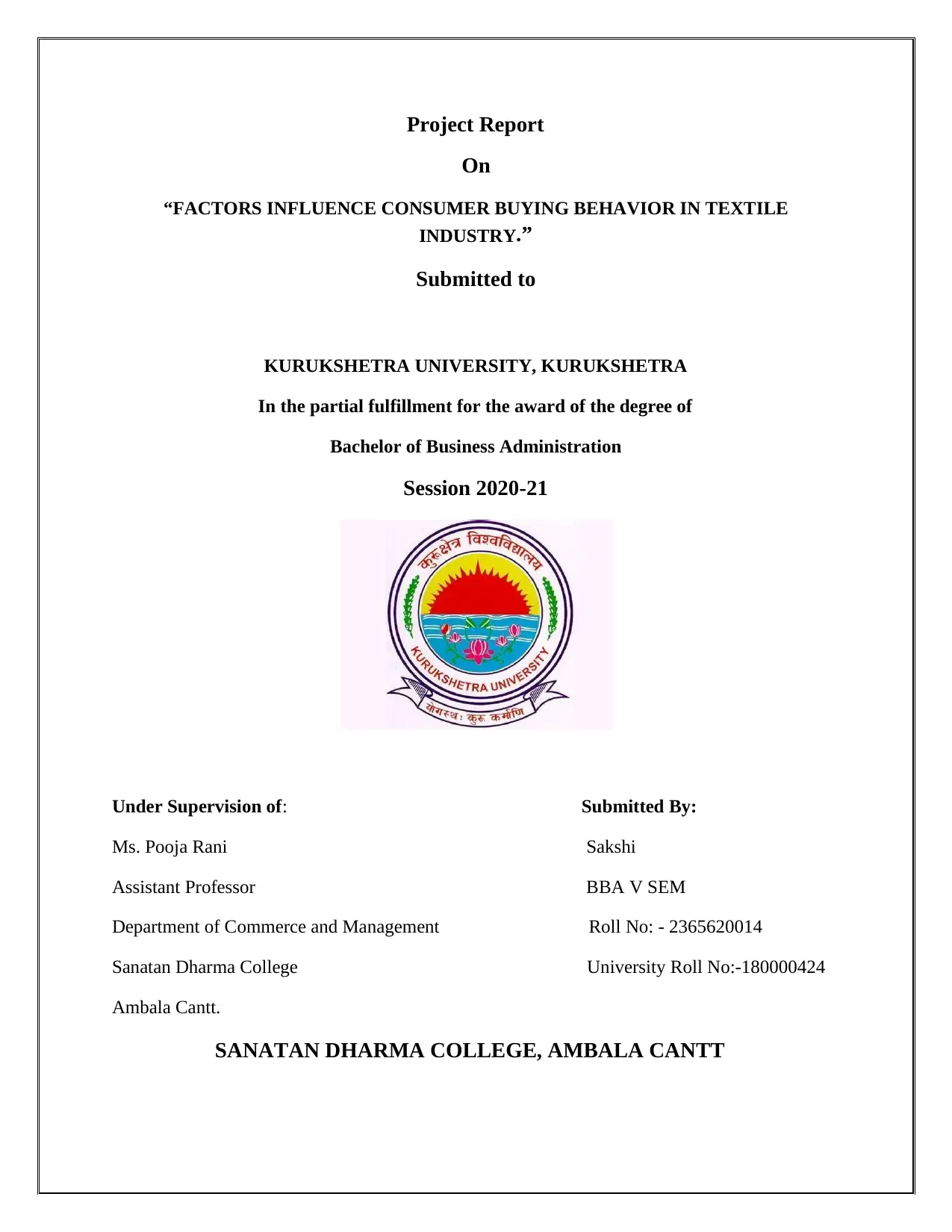
Project Report
On
“FACTORS INFLUENCE CONSUMER BUYING BEHAVIOR IN TEXTILE
INDUSTRY.”
Submitted to
KURUKSHETRA UNIVERSITY, KURUKSHETRA
In the partial fulfillment for the award of the degree of
Bachelor of Business Administration
Session 2020-21
Under Supervision of: Submitted By:
Ms. Pooja Rani Sakshi
Assistant Professor BBA V SEM
Department of Commerce and Management Roll No: - 2365620014
Sanatan Dharma College University Roll No:-180000424
Ambala Cantt.
SANATAN DHARMA COLLEGE, AMBALA CANTT
On
“FACTORS INFLUENCE CONSUMER BUYING BEHAVIOR IN TEXTILE
INDUSTRY.”
Submitted to
KURUKSHETRA UNIVERSITY, KURUKSHETRA
In the partial fulfillment for the award of the degree of
Bachelor of Business Administration
Session 2020-21
Under Supervision of: Submitted By:
Ms. Pooja Rani Sakshi
Assistant Professor BBA V SEM
Department of Commerce and Management Roll No: - 2365620014
Sanatan Dharma College University Roll No:-180000424
Ambala Cantt.
SANATAN DHARMA COLLEGE, AMBALA CANTT
Secure Best Marks with AI Grader
Need help grading? Try our AI Grader for instant feedback on your assignments.
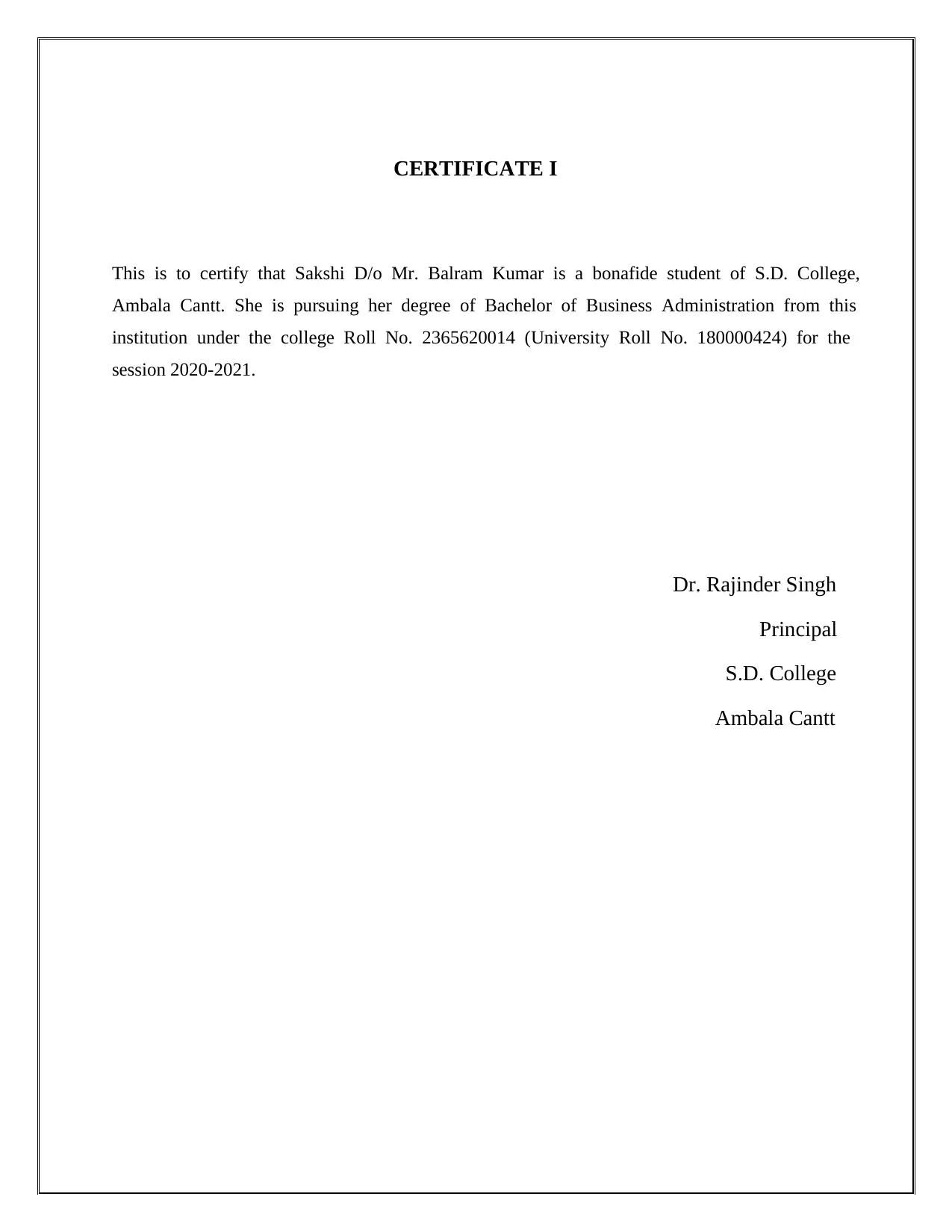
CERTIFICATE I
This is to certify that Sakshi D/o Mr. Balram Kumar is a bonafide student of S.D. College,
Ambala Cantt. She is pursuing her degree of Bachelor of Business Administration from this
institution under the college Roll No. 2365620014 (University Roll No. 180000424) for the
session 2020-2021.
Dr. Rajinder Singh
Principal
S.D. College
Ambala Cantt
This is to certify that Sakshi D/o Mr. Balram Kumar is a bonafide student of S.D. College,
Ambala Cantt. She is pursuing her degree of Bachelor of Business Administration from this
institution under the college Roll No. 2365620014 (University Roll No. 180000424) for the
session 2020-2021.
Dr. Rajinder Singh
Principal
S.D. College
Ambala Cantt
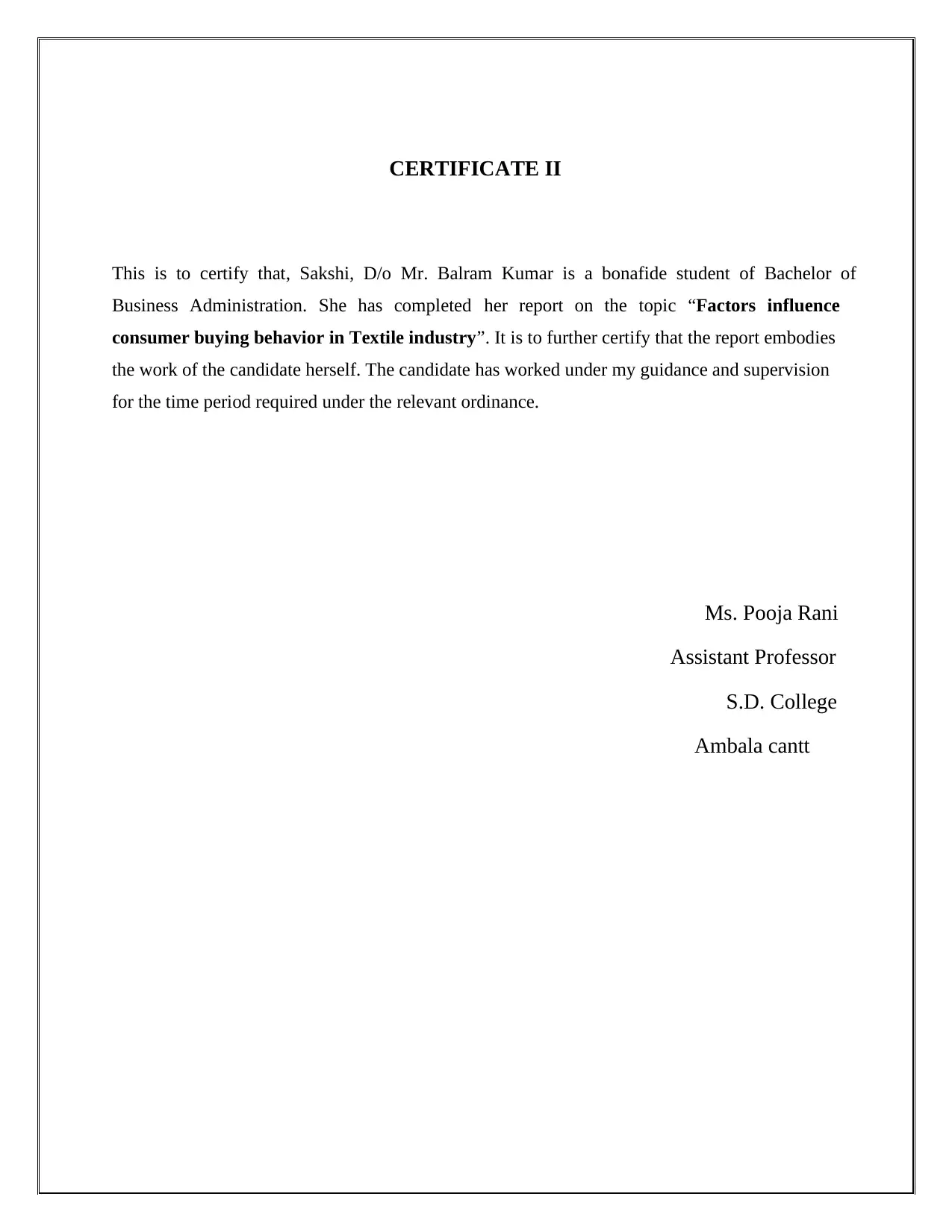
CERTIFICATE II
This is to certify that, Sakshi, D/o Mr. Balram Kumar is a bonafide student of Bachelor of
Business Administration. She has completed her report on the topic “Factors influence
consumer buying behavior in Textile industry”. It is to further certify that the report embodies
the work of the candidate herself. The candidate has worked under my guidance and supervision
for the time period required under the relevant ordinance.
Ms. Pooja Rani
Assistant Professor
S.D. College
Ambala cantt
This is to certify that, Sakshi, D/o Mr. Balram Kumar is a bonafide student of Bachelor of
Business Administration. She has completed her report on the topic “Factors influence
consumer buying behavior in Textile industry”. It is to further certify that the report embodies
the work of the candidate herself. The candidate has worked under my guidance and supervision
for the time period required under the relevant ordinance.
Ms. Pooja Rani
Assistant Professor
S.D. College
Ambala cantt
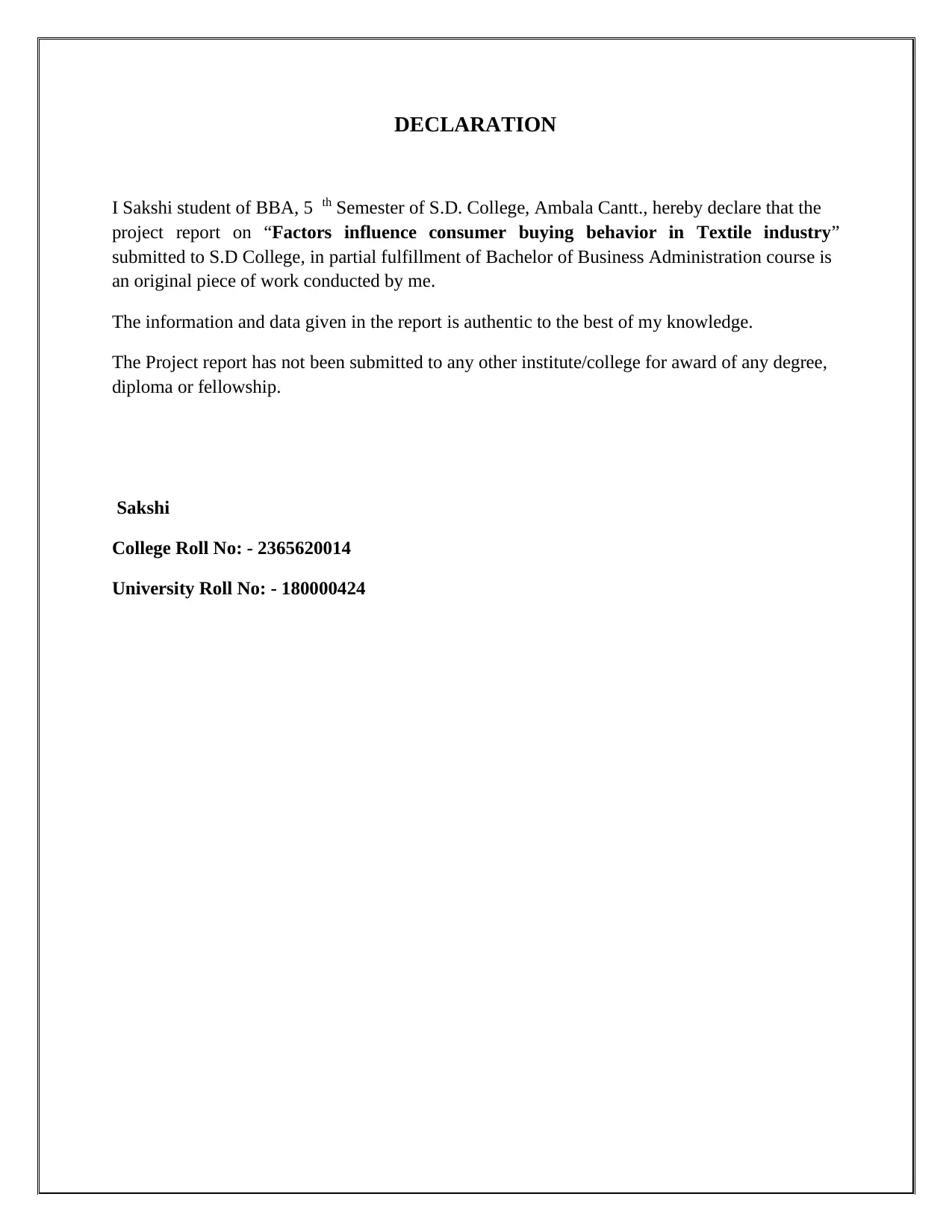
DECLARATION
I Sakshi student of BBA, 5 th Semester of S.D. College, Ambala Cantt., hereby declare that the
project report on “Factors influence consumer buying behavior in Textile industry”
submitted to S.D College, in partial fulfillment of Bachelor of Business Administration course is
an original piece of work conducted by me.
The information and data given in the report is authentic to the best of my knowledge.
The Project report has not been submitted to any other institute/college for award of any degree,
diploma or fellowship.
Sakshi
College Roll No: - 2365620014
University Roll No: - 180000424
I Sakshi student of BBA, 5 th Semester of S.D. College, Ambala Cantt., hereby declare that the
project report on “Factors influence consumer buying behavior in Textile industry”
submitted to S.D College, in partial fulfillment of Bachelor of Business Administration course is
an original piece of work conducted by me.
The information and data given in the report is authentic to the best of my knowledge.
The Project report has not been submitted to any other institute/college for award of any degree,
diploma or fellowship.
Sakshi
College Roll No: - 2365620014
University Roll No: - 180000424
Secure Best Marks with AI Grader
Need help grading? Try our AI Grader for instant feedback on your assignments.
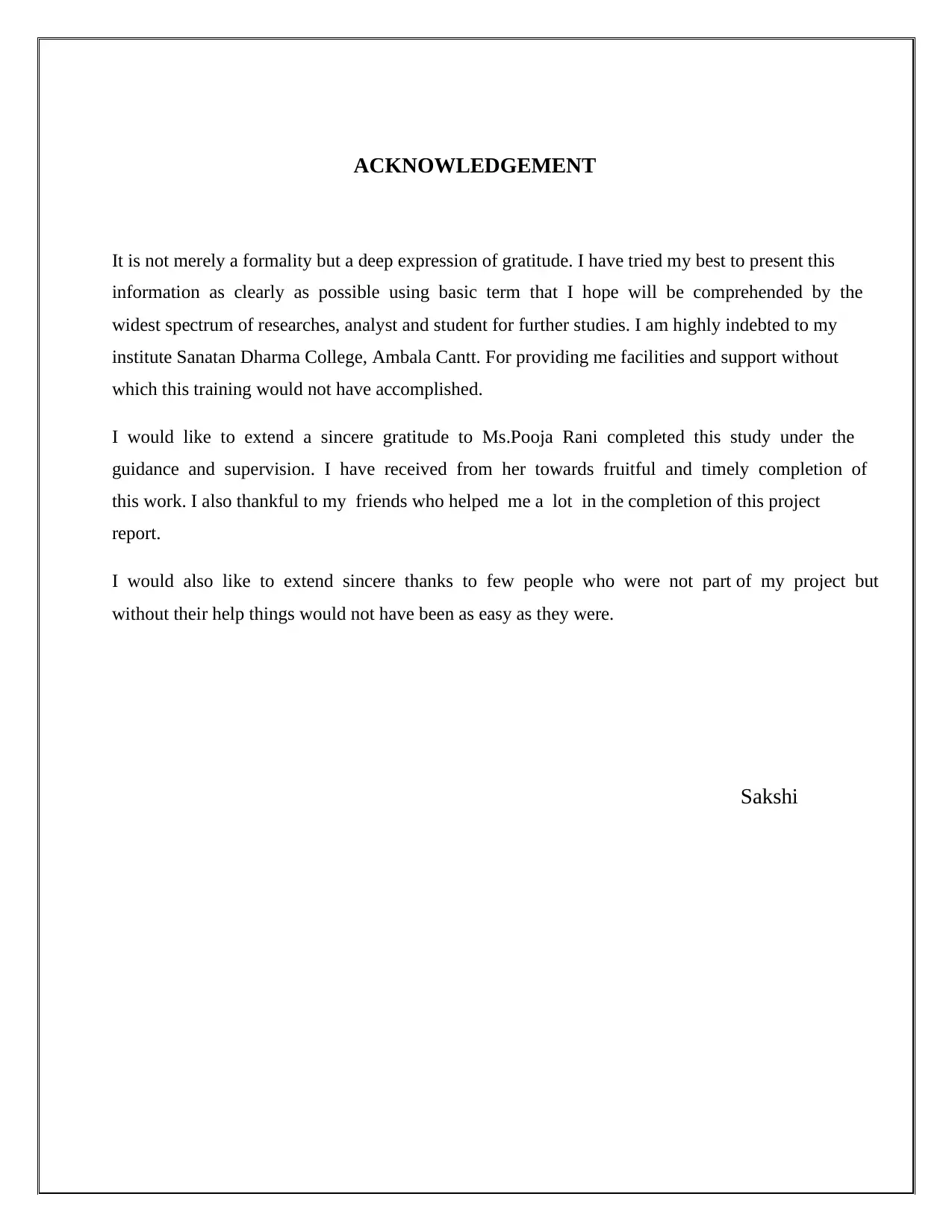
ACKNOWLEDGEMENT
It is not merely a formality but a deep expression of gratitude. I have tried my best to present this
information as clearly as possible using basic term that I hope will be comprehended by the
widest spectrum of researches, analyst and student for further studies. I am highly indebted to my
institute Sanatan Dharma College, Ambala Cantt. For providing me facilities and support without
which this training would not have accomplished.
I would like to extend a sincere gratitude to Ms.Pooja Rani completed this study under the
guidance and supervision. I have received from her towards fruitful and timely completion of
this work. I also thankful to my friends who helped me a lot in the completion of this project
report.
I would also like to extend sincere thanks to few people who were not part of my project but
without their help things would not have been as easy as they were.
Sakshi
It is not merely a formality but a deep expression of gratitude. I have tried my best to present this
information as clearly as possible using basic term that I hope will be comprehended by the
widest spectrum of researches, analyst and student for further studies. I am highly indebted to my
institute Sanatan Dharma College, Ambala Cantt. For providing me facilities and support without
which this training would not have accomplished.
I would like to extend a sincere gratitude to Ms.Pooja Rani completed this study under the
guidance and supervision. I have received from her towards fruitful and timely completion of
this work. I also thankful to my friends who helped me a lot in the completion of this project
report.
I would also like to extend sincere thanks to few people who were not part of my project but
without their help things would not have been as easy as they were.
Sakshi
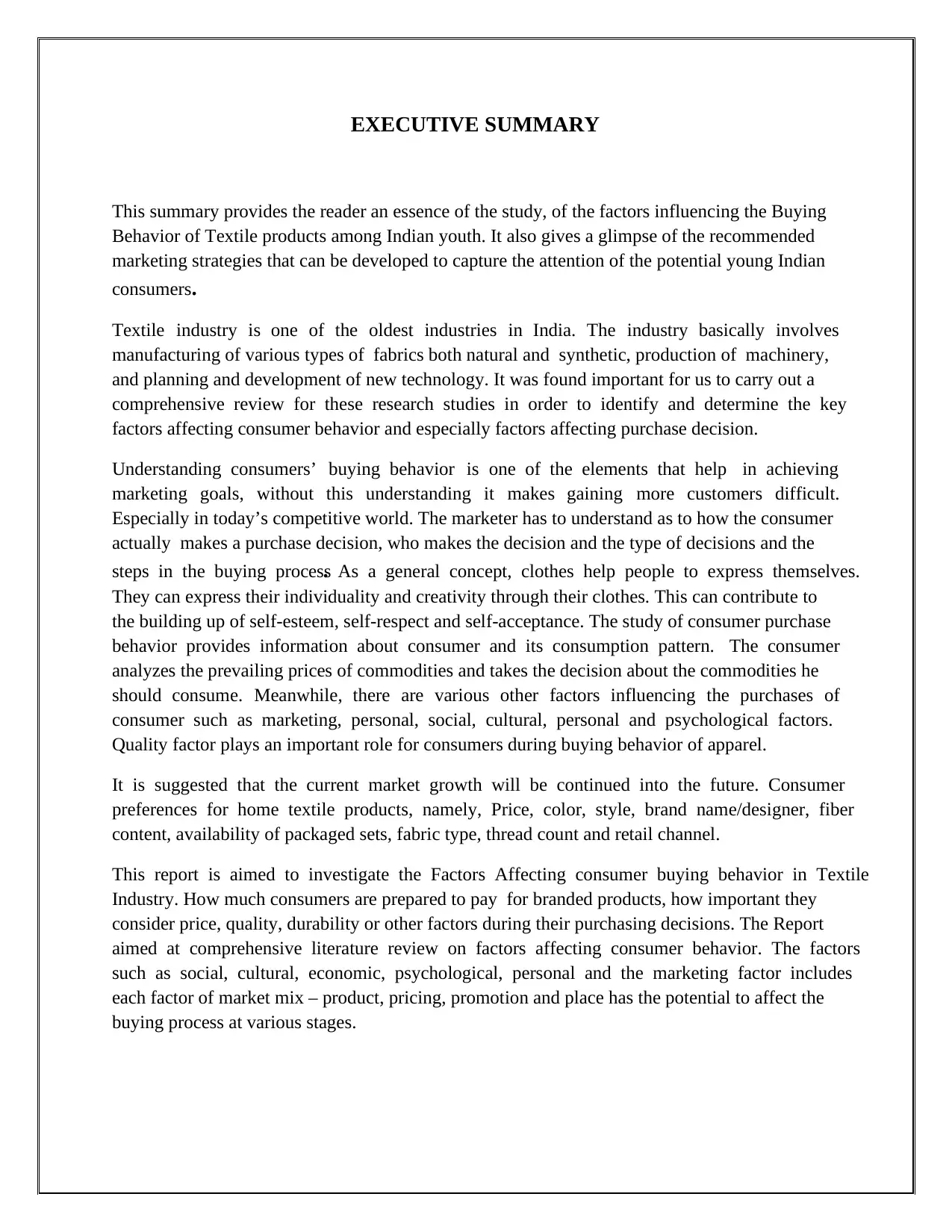
EXECUTIVE SUMMARY
This summary provides the reader an essence of the study, of the factors influencing the Buying
Behavior of Textile products among Indian youth. It also gives a glimpse of the recommended
marketing strategies that can be developed to capture the attention of the potential young Indian
consumers.
Textile industry is one of the oldest industries in India. The industry basically involves
manufacturing of various types of fabrics both natural and synthetic, production of machinery,
and planning and development of new technology. It was found important for us to carry out a
comprehensive review for these research studies in order to identify and determine the key
factors affecting consumer behavior and especially factors affecting purchase decision.
Understanding consumers’ buying behavior is one of the elements that help in achieving
marketing goals, without this understanding it makes gaining more customers difficult.
Especially in today’s competitive world. The marketer has to understand as to how the consumer
actually makes a purchase decision, who makes the decision and the type of decisions and the
steps in the buying process. As a general concept, clothes help people to express themselves.
They can express their individuality and creativity through their clothes. This can contribute to
the building up of self-esteem, self-respect and self-acceptance. The study of consumer purchase
behavior provides information about consumer and its consumption pattern. The consumer
analyzes the prevailing prices of commodities and takes the decision about the commodities he
should consume. Meanwhile, there are various other factors influencing the purchases of
consumer such as marketing, personal, social, cultural, personal and psychological factors.
Quality factor plays an important role for consumers during buying behavior of apparel.
It is suggested that the current market growth will be continued into the future. Consumer
preferences for home textile products, namely, Price, color, style, brand name/designer, fiber
content, availability of packaged sets, fabric type, thread count and retail channel.
This report is aimed to investigate the Factors Affecting consumer buying behavior in Textile
Industry. How much consumers are prepared to pay for branded products, how important they
consider price, quality, durability or other factors during their purchasing decisions. The Report
aimed at comprehensive literature review on factors affecting consumer behavior. The factors
such as social, cultural, economic, psychological, personal and the marketing factor includes
each factor of market mix – product, pricing, promotion and place has the potential to affect the
buying process at various stages.
This summary provides the reader an essence of the study, of the factors influencing the Buying
Behavior of Textile products among Indian youth. It also gives a glimpse of the recommended
marketing strategies that can be developed to capture the attention of the potential young Indian
consumers.
Textile industry is one of the oldest industries in India. The industry basically involves
manufacturing of various types of fabrics both natural and synthetic, production of machinery,
and planning and development of new technology. It was found important for us to carry out a
comprehensive review for these research studies in order to identify and determine the key
factors affecting consumer behavior and especially factors affecting purchase decision.
Understanding consumers’ buying behavior is one of the elements that help in achieving
marketing goals, without this understanding it makes gaining more customers difficult.
Especially in today’s competitive world. The marketer has to understand as to how the consumer
actually makes a purchase decision, who makes the decision and the type of decisions and the
steps in the buying process. As a general concept, clothes help people to express themselves.
They can express their individuality and creativity through their clothes. This can contribute to
the building up of self-esteem, self-respect and self-acceptance. The study of consumer purchase
behavior provides information about consumer and its consumption pattern. The consumer
analyzes the prevailing prices of commodities and takes the decision about the commodities he
should consume. Meanwhile, there are various other factors influencing the purchases of
consumer such as marketing, personal, social, cultural, personal and psychological factors.
Quality factor plays an important role for consumers during buying behavior of apparel.
It is suggested that the current market growth will be continued into the future. Consumer
preferences for home textile products, namely, Price, color, style, brand name/designer, fiber
content, availability of packaged sets, fabric type, thread count and retail channel.
This report is aimed to investigate the Factors Affecting consumer buying behavior in Textile
Industry. How much consumers are prepared to pay for branded products, how important they
consider price, quality, durability or other factors during their purchasing decisions. The Report
aimed at comprehensive literature review on factors affecting consumer behavior. The factors
such as social, cultural, economic, psychological, personal and the marketing factor includes
each factor of market mix – product, pricing, promotion and place has the potential to affect the
buying process at various stages.
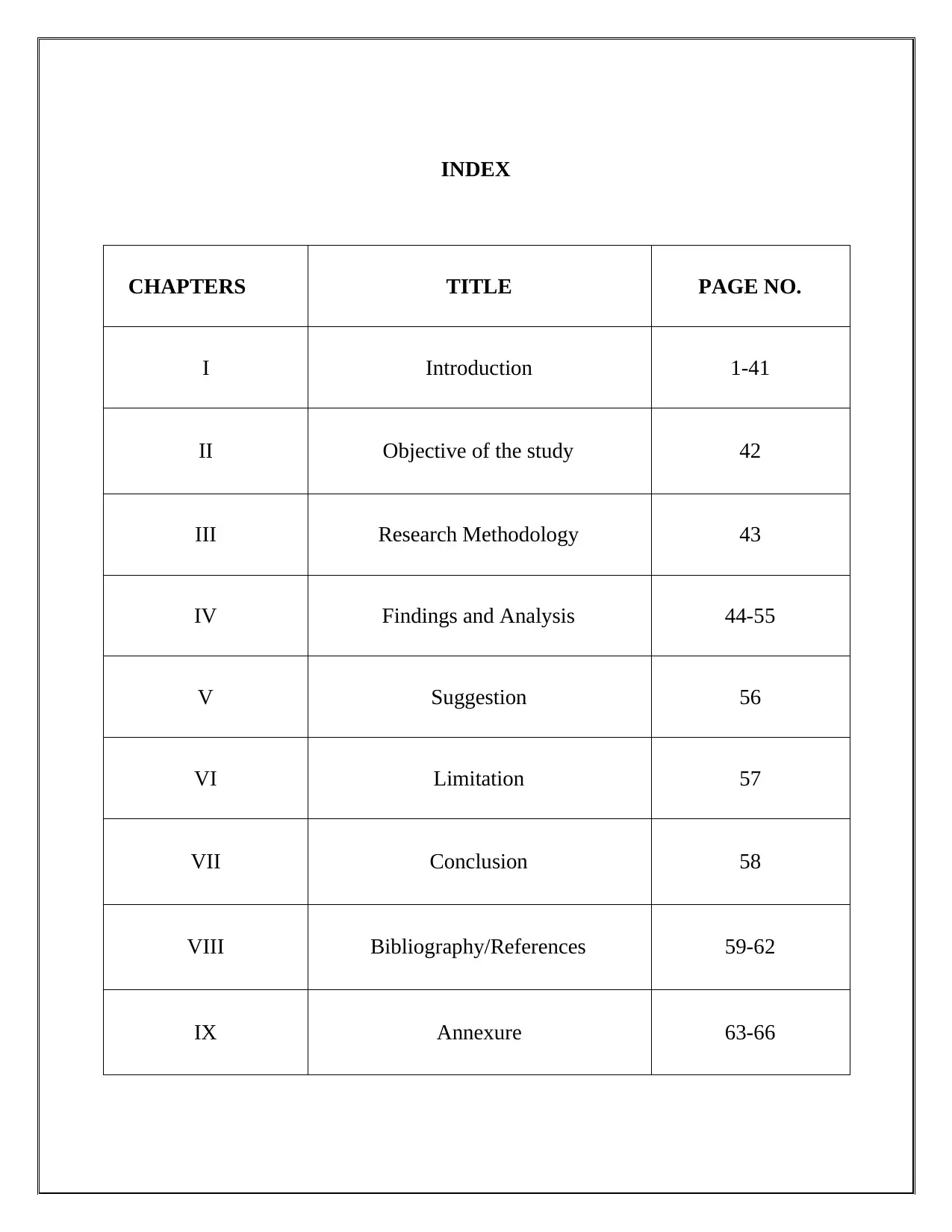
INDEX
CHAPTERS TITLE PAGE NO.
I Introduction 1-41
II Objective of the study 42
III Research Methodology 43
IV Findings and Analysis 44-55
V Suggestion 56
VI Limitation 57
VII Conclusion 58
VIII Bibliography/References 59-62
IX Annexure 63-66
CHAPTERS TITLE PAGE NO.
I Introduction 1-41
II Objective of the study 42
III Research Methodology 43
IV Findings and Analysis 44-55
V Suggestion 56
VI Limitation 57
VII Conclusion 58
VIII Bibliography/References 59-62
IX Annexure 63-66
Paraphrase This Document
Need a fresh take? Get an instant paraphrase of this document with our AI Paraphraser
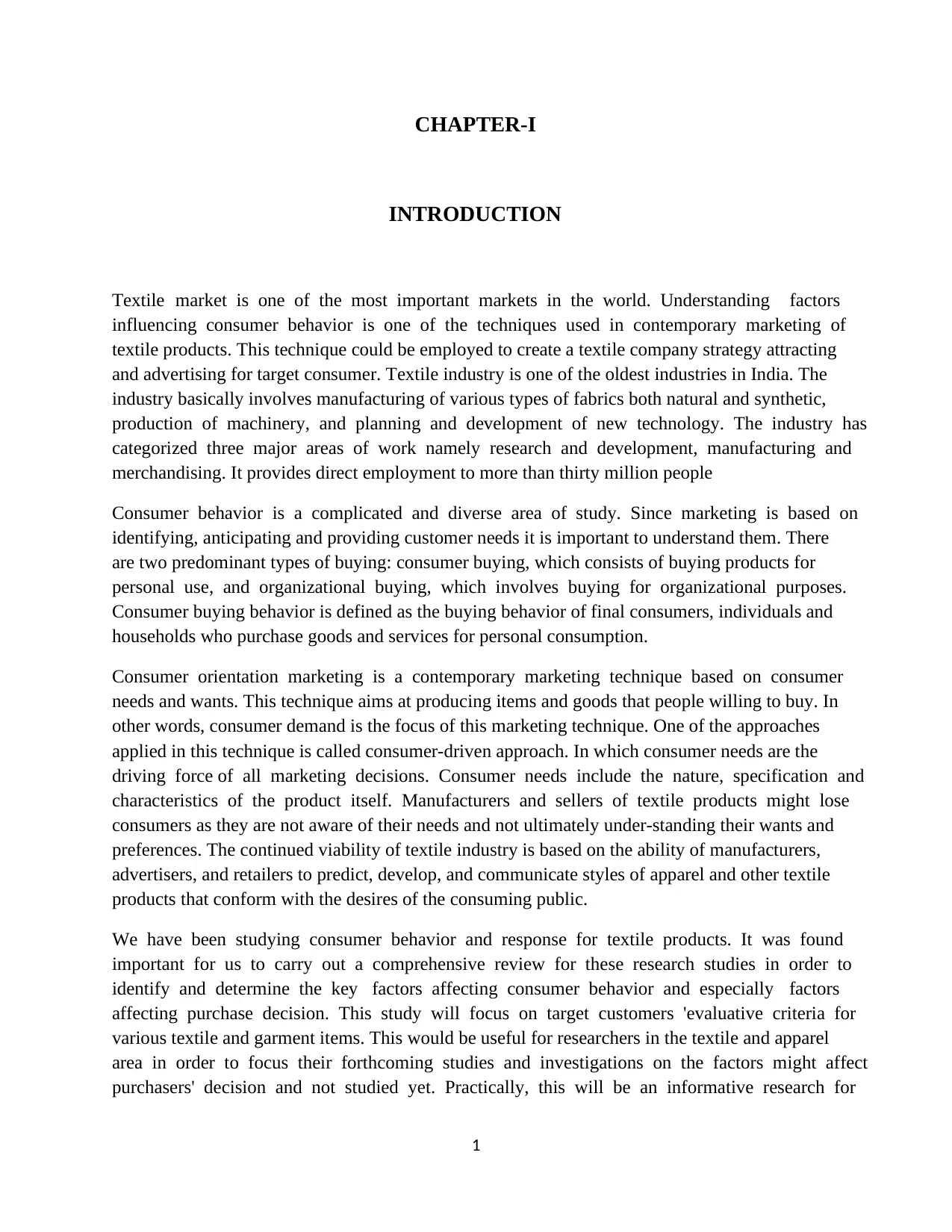
1
CHAPTER-I
INTRODUCTION
Textile market is one of the most important markets in the world. Understanding factors
influencing consumer behavior is one of the techniques used in contemporary marketing of
textile products. This technique could be employed to create a textile company strategy attracting
and advertising for target consumer. Textile industry is one of the oldest industries in India. The
industry basically involves manufacturing of various types of fabrics both natural and synthetic,
production of machinery, and planning and development of new technology. The industry has
categorized three major areas of work namely research and development, manufacturing and
merchandising. It provides direct employment to more than thirty million people
Consumer behavior is a complicated and diverse area of study. Since marketing is based on
identifying, anticipating and providing customer needs it is important to understand them. There
are two predominant types of buying: consumer buying, which consists of buying products for
personal use, and organizational buying, which involves buying for organizational purposes.
Consumer buying behavior is defined as the buying behavior of final consumers, individuals and
households who purchase goods and services for personal consumption.
Consumer orientation marketing is a contemporary marketing technique based on consumer
needs and wants. This technique aims at producing items and goods that people willing to buy. In
other words, consumer demand is the focus of this marketing technique. One of the approaches
applied in this technique is called consumer-driven approach. In which consumer needs are the
driving force of all marketing decisions. Consumer needs include the nature, specification and
characteristics of the product itself. Manufacturers and sellers of textile products might lose
consumers as they are not aware of their needs and not ultimately under-standing their wants and
preferences. The continued viability of textile industry is based on the ability of manufacturers,
advertisers, and retailers to predict, develop, and communicate styles of apparel and other textile
products that conform with the desires of the consuming public.
We have been studying consumer behavior and response for textile products. It was found
important for us to carry out a comprehensive review for these research studies in order to
identify and determine the key factors affecting consumer behavior and especially factors
affecting purchase decision. This study will focus on target customers 'evaluative criteria for
various textile and garment items. This would be useful for researchers in the textile and apparel
area in order to focus their forthcoming studies and investigations on the factors might affect
purchasers' decision and not studied yet. Practically, this will be an informative research for
CHAPTER-I
INTRODUCTION
Textile market is one of the most important markets in the world. Understanding factors
influencing consumer behavior is one of the techniques used in contemporary marketing of
textile products. This technique could be employed to create a textile company strategy attracting
and advertising for target consumer. Textile industry is one of the oldest industries in India. The
industry basically involves manufacturing of various types of fabrics both natural and synthetic,
production of machinery, and planning and development of new technology. The industry has
categorized three major areas of work namely research and development, manufacturing and
merchandising. It provides direct employment to more than thirty million people
Consumer behavior is a complicated and diverse area of study. Since marketing is based on
identifying, anticipating and providing customer needs it is important to understand them. There
are two predominant types of buying: consumer buying, which consists of buying products for
personal use, and organizational buying, which involves buying for organizational purposes.
Consumer buying behavior is defined as the buying behavior of final consumers, individuals and
households who purchase goods and services for personal consumption.
Consumer orientation marketing is a contemporary marketing technique based on consumer
needs and wants. This technique aims at producing items and goods that people willing to buy. In
other words, consumer demand is the focus of this marketing technique. One of the approaches
applied in this technique is called consumer-driven approach. In which consumer needs are the
driving force of all marketing decisions. Consumer needs include the nature, specification and
characteristics of the product itself. Manufacturers and sellers of textile products might lose
consumers as they are not aware of their needs and not ultimately under-standing their wants and
preferences. The continued viability of textile industry is based on the ability of manufacturers,
advertisers, and retailers to predict, develop, and communicate styles of apparel and other textile
products that conform with the desires of the consuming public.
We have been studying consumer behavior and response for textile products. It was found
important for us to carry out a comprehensive review for these research studies in order to
identify and determine the key factors affecting consumer behavior and especially factors
affecting purchase decision. This study will focus on target customers 'evaluative criteria for
various textile and garment items. This would be useful for researchers in the textile and apparel
area in order to focus their forthcoming studies and investigations on the factors might affect
purchasers' decision and not studied yet. Practically, this will be an informative research for
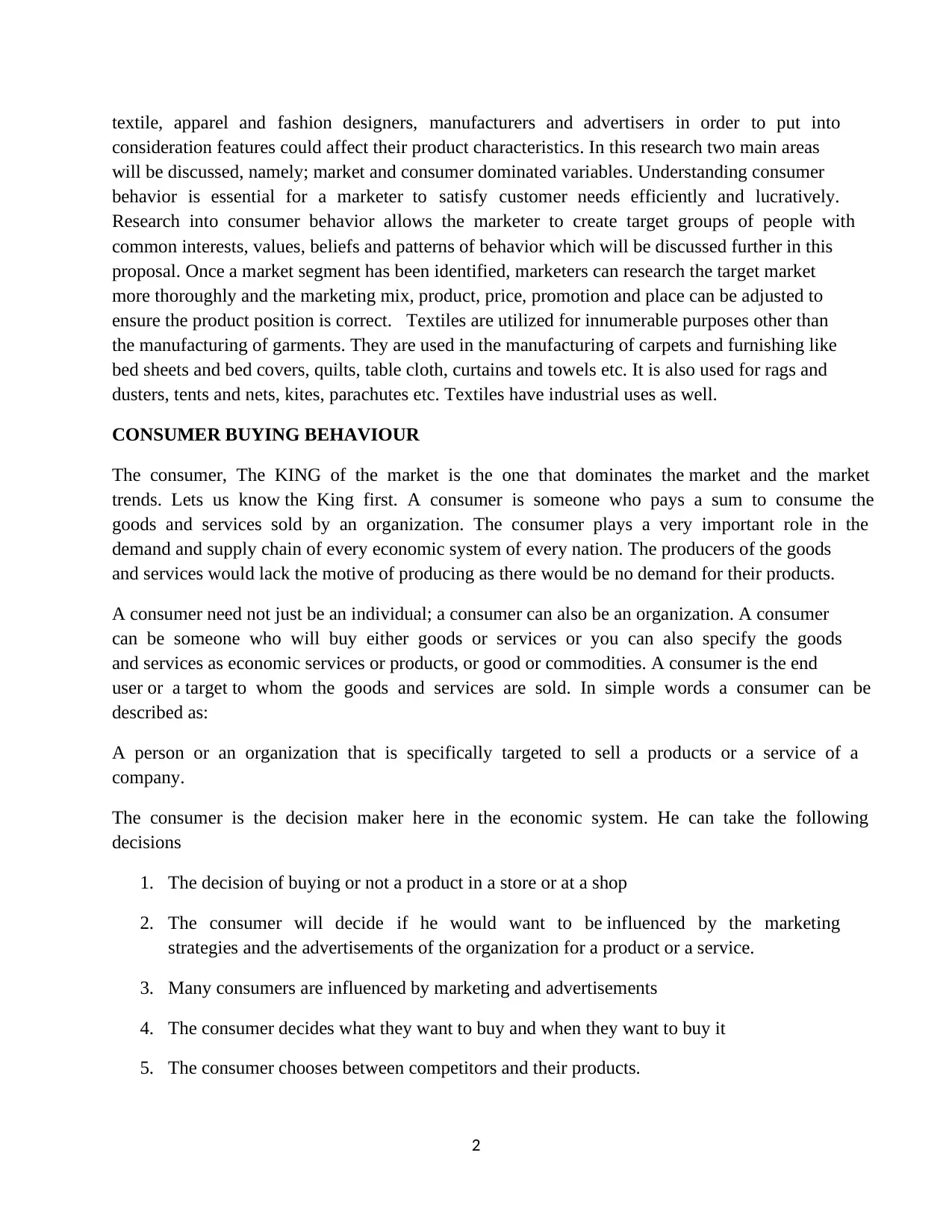
2
textile, apparel and fashion designers, manufacturers and advertisers in order to put into
consideration features could affect their product characteristics. In this research two main areas
will be discussed, namely; market and consumer dominated variables. Understanding consumer
behavior is essential for a marketer to satisfy customer needs efficiently and lucratively.
Research into consumer behavior allows the marketer to create target groups of people with
common interests, values, beliefs and patterns of behavior which will be discussed further in this
proposal. Once a market segment has been identified, marketers can research the target market
more thoroughly and the marketing mix, product, price, promotion and place can be adjusted to
ensure the product position is correct. Textiles are utilized for innumerable purposes other than
the manufacturing of garments. They are used in the manufacturing of carpets and furnishing like
bed sheets and bed covers, quilts, table cloth, curtains and towels etc. It is also used for rags and
dusters, tents and nets, kites, parachutes etc. Textiles have industrial uses as well.
CONSUMER BUYING BEHAVIOUR
The consumer, The KING of the market is the one that dominates the market and the market
trends. Lets us know the King first. A consumer is someone who pays a sum to consume the
goods and services sold by an organization. The consumer plays a very important role in the
demand and supply chain of every economic system of every nation. The producers of the goods
and services would lack the motive of producing as there would be no demand for their products.
A consumer need not just be an individual; a consumer can also be an organization. A consumer
can be someone who will buy either goods or services or you can also specify the goods
and services as economic services or products, or good or commodities. A consumer is the end
user or a target to whom the goods and services are sold. In simple words a consumer can be
described as:
A person or an organization that is specifically targeted to sell a products or a service of a
company.
The consumer is the decision maker here in the economic system. He can take the following
decisions
1. The decision of buying or not a product in a store or at a shop
2. The consumer will decide if he would want to be influenced by the marketing
strategies and the advertisements of the organization for a product or a service.
3. Many consumers are influenced by marketing and advertisements
4. The consumer decides what they want to buy and when they want to buy it
5. The consumer chooses between competitors and their products.
textile, apparel and fashion designers, manufacturers and advertisers in order to put into
consideration features could affect their product characteristics. In this research two main areas
will be discussed, namely; market and consumer dominated variables. Understanding consumer
behavior is essential for a marketer to satisfy customer needs efficiently and lucratively.
Research into consumer behavior allows the marketer to create target groups of people with
common interests, values, beliefs and patterns of behavior which will be discussed further in this
proposal. Once a market segment has been identified, marketers can research the target market
more thoroughly and the marketing mix, product, price, promotion and place can be adjusted to
ensure the product position is correct. Textiles are utilized for innumerable purposes other than
the manufacturing of garments. They are used in the manufacturing of carpets and furnishing like
bed sheets and bed covers, quilts, table cloth, curtains and towels etc. It is also used for rags and
dusters, tents and nets, kites, parachutes etc. Textiles have industrial uses as well.
CONSUMER BUYING BEHAVIOUR
The consumer, The KING of the market is the one that dominates the market and the market
trends. Lets us know the King first. A consumer is someone who pays a sum to consume the
goods and services sold by an organization. The consumer plays a very important role in the
demand and supply chain of every economic system of every nation. The producers of the goods
and services would lack the motive of producing as there would be no demand for their products.
A consumer need not just be an individual; a consumer can also be an organization. A consumer
can be someone who will buy either goods or services or you can also specify the goods
and services as economic services or products, or good or commodities. A consumer is the end
user or a target to whom the goods and services are sold. In simple words a consumer can be
described as:
A person or an organization that is specifically targeted to sell a products or a service of a
company.
The consumer is the decision maker here in the economic system. He can take the following
decisions
1. The decision of buying or not a product in a store or at a shop
2. The consumer will decide if he would want to be influenced by the marketing
strategies and the advertisements of the organization for a product or a service.
3. Many consumers are influenced by marketing and advertisements
4. The consumer decides what they want to buy and when they want to buy it
5. The consumer chooses between competitors and their products.
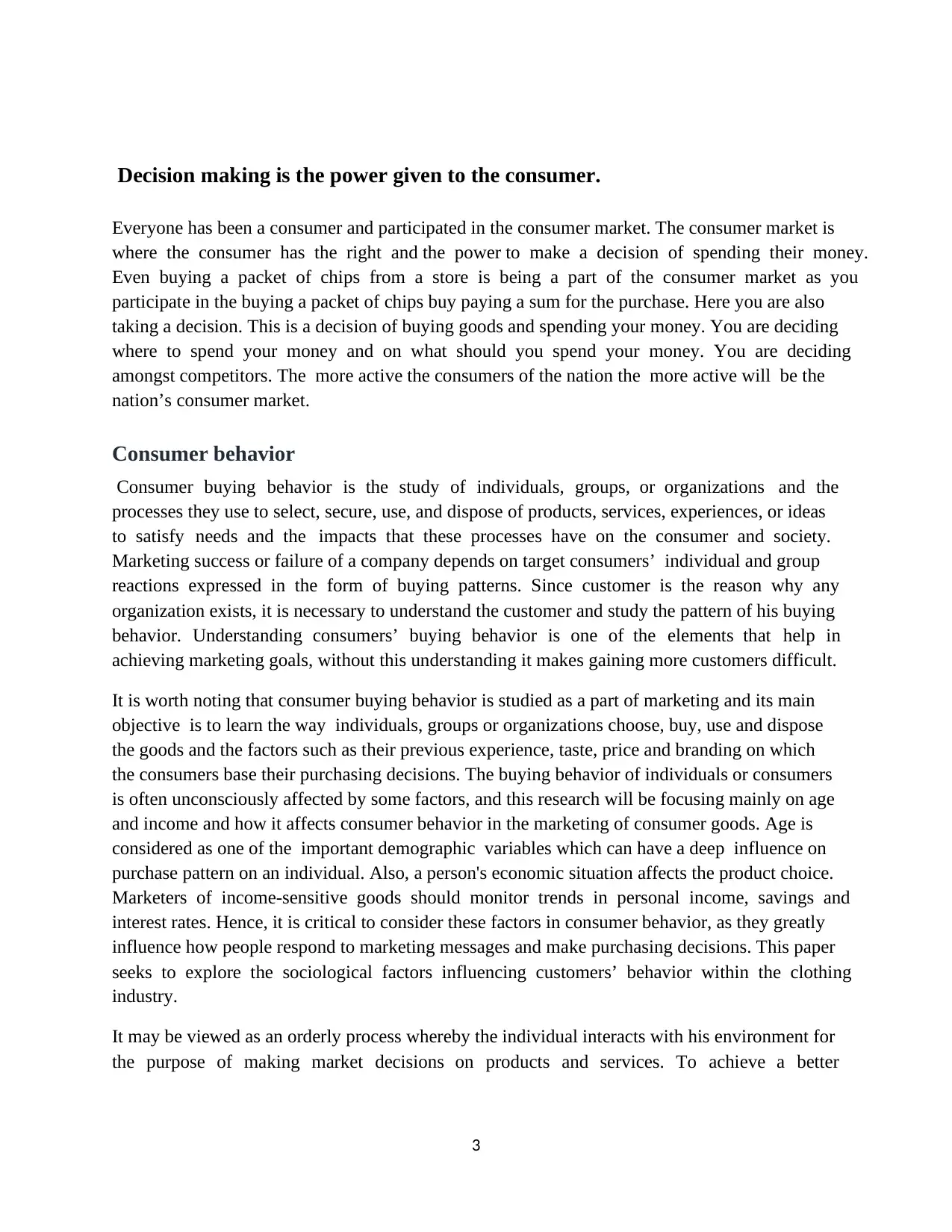
3
Decision making is the power given to the consumer.
Everyone has been a consumer and participated in the consumer market. The consumer market is
where the consumer has the right and the power to make a decision of spending their money.
Even buying a packet of chips from a store is being a part of the consumer market as you
participate in the buying a packet of chips buy paying a sum for the purchase. Here you are also
taking a decision. This is a decision of buying goods and spending your money. You are deciding
where to spend your money and on what should you spend your money. You are deciding
amongst competitors. The more active the consumers of the nation the more active will be the
nation’s consumer market.
Consumer behavior
Consumer buying behavior is the study of individuals, groups, or organizations and the
processes they use to select, secure, use, and dispose of products, services, experiences, or ideas
to satisfy needs and the impacts that these processes have on the consumer and society.
Marketing success or failure of a company depends on target consumers’ individual and group
reactions expressed in the form of buying patterns. Since customer is the reason why any
organization exists, it is necessary to understand the customer and study the pattern of his buying
behavior. Understanding consumers’ buying behavior is one of the elements that help in
achieving marketing goals, without this understanding it makes gaining more customers difficult.
It is worth noting that consumer buying behavior is studied as a part of marketing and its main
objective is to learn the way individuals, groups or organizations choose, buy, use and dispose
the goods and the factors such as their previous experience, taste, price and branding on which
the consumers base their purchasing decisions. The buying behavior of individuals or consumers
is often unconsciously affected by some factors, and this research will be focusing mainly on age
and income and how it affects consumer behavior in the marketing of consumer goods. Age is
considered as one of the important demographic variables which can have a deep influence on
purchase pattern on an individual. Also, a person's economic situation affects the product choice.
Marketers of income-sensitive goods should monitor trends in personal income, savings and
interest rates. Hence, it is critical to consider these factors in consumer behavior, as they greatly
influence how people respond to marketing messages and make purchasing decisions. This paper
seeks to explore the sociological factors influencing customers’ behavior within the clothing
industry.
It may be viewed as an orderly process whereby the individual interacts with his environment for
the purpose of making market decisions on products and services. To achieve a better
Decision making is the power given to the consumer.
Everyone has been a consumer and participated in the consumer market. The consumer market is
where the consumer has the right and the power to make a decision of spending their money.
Even buying a packet of chips from a store is being a part of the consumer market as you
participate in the buying a packet of chips buy paying a sum for the purchase. Here you are also
taking a decision. This is a decision of buying goods and spending your money. You are deciding
where to spend your money and on what should you spend your money. You are deciding
amongst competitors. The more active the consumers of the nation the more active will be the
nation’s consumer market.
Consumer behavior
Consumer buying behavior is the study of individuals, groups, or organizations and the
processes they use to select, secure, use, and dispose of products, services, experiences, or ideas
to satisfy needs and the impacts that these processes have on the consumer and society.
Marketing success or failure of a company depends on target consumers’ individual and group
reactions expressed in the form of buying patterns. Since customer is the reason why any
organization exists, it is necessary to understand the customer and study the pattern of his buying
behavior. Understanding consumers’ buying behavior is one of the elements that help in
achieving marketing goals, without this understanding it makes gaining more customers difficult.
It is worth noting that consumer buying behavior is studied as a part of marketing and its main
objective is to learn the way individuals, groups or organizations choose, buy, use and dispose
the goods and the factors such as their previous experience, taste, price and branding on which
the consumers base their purchasing decisions. The buying behavior of individuals or consumers
is often unconsciously affected by some factors, and this research will be focusing mainly on age
and income and how it affects consumer behavior in the marketing of consumer goods. Age is
considered as one of the important demographic variables which can have a deep influence on
purchase pattern on an individual. Also, a person's economic situation affects the product choice.
Marketers of income-sensitive goods should monitor trends in personal income, savings and
interest rates. Hence, it is critical to consider these factors in consumer behavior, as they greatly
influence how people respond to marketing messages and make purchasing decisions. This paper
seeks to explore the sociological factors influencing customers’ behavior within the clothing
industry.
It may be viewed as an orderly process whereby the individual interacts with his environment for
the purpose of making market decisions on products and services. To achieve a better
Secure Best Marks with AI Grader
Need help grading? Try our AI Grader for instant feedback on your assignments.
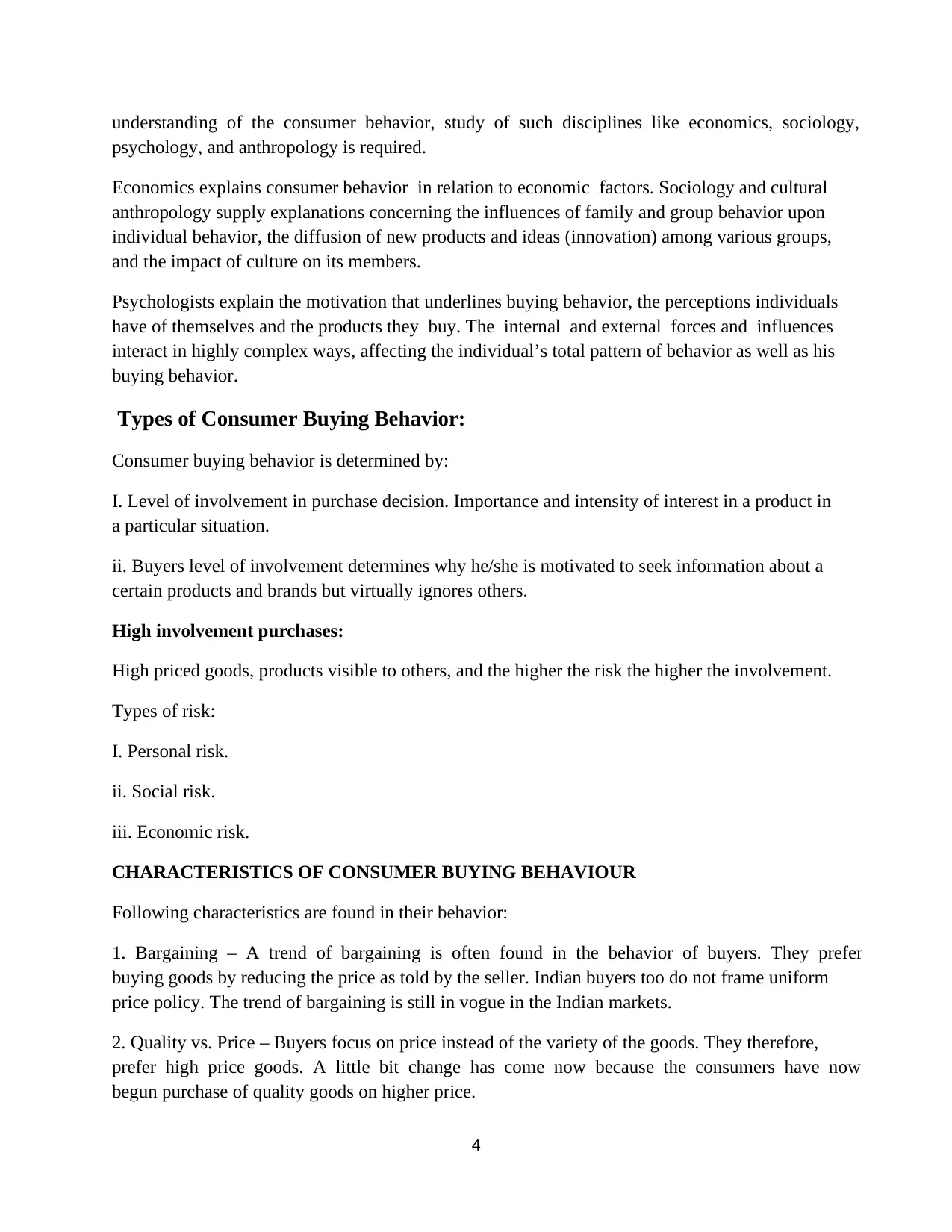
4
understanding of the consumer behavior, study of such disciplines like economics, sociology,
psychology, and anthropology is required.
Economics explains consumer behavior in relation to economic factors. Sociology and cultural
anthropology supply explanations concerning the influences of family and group behavior upon
individual behavior, the diffusion of new products and ideas (innovation) among various groups,
and the impact of culture on its members.
Psychologists explain the motivation that underlines buying behavior, the perceptions individuals
have of themselves and the products they buy. The internal and external forces and influences
interact in highly complex ways, affecting the individual’s total pattern of behavior as well as his
buying behavior.
Types of Consumer Buying Behavior:
Consumer buying behavior is determined by:
I. Level of involvement in purchase decision. Importance and intensity of interest in a product in
a particular situation.
ii. Buyers level of involvement determines why he/she is motivated to seek information about a
certain products and brands but virtually ignores others.
High involvement purchases:
High priced goods, products visible to others, and the higher the risk the higher the involvement.
Types of risk:
I. Personal risk.
ii. Social risk.
iii. Economic risk.
CHARACTERISTICS OF CONSUMER BUYING BEHAVIOUR
Following characteristics are found in their behavior:
1. Bargaining – A trend of bargaining is often found in the behavior of buyers. They prefer
buying goods by reducing the price as told by the seller. Indian buyers too do not frame uniform
price policy. The trend of bargaining is still in vogue in the Indian markets.
2. Quality vs. Price – Buyers focus on price instead of the variety of the goods. They therefore,
prefer high price goods. A little bit change has come now because the consumers have now
begun purchase of quality goods on higher price.
understanding of the consumer behavior, study of such disciplines like economics, sociology,
psychology, and anthropology is required.
Economics explains consumer behavior in relation to economic factors. Sociology and cultural
anthropology supply explanations concerning the influences of family and group behavior upon
individual behavior, the diffusion of new products and ideas (innovation) among various groups,
and the impact of culture on its members.
Psychologists explain the motivation that underlines buying behavior, the perceptions individuals
have of themselves and the products they buy. The internal and external forces and influences
interact in highly complex ways, affecting the individual’s total pattern of behavior as well as his
buying behavior.
Types of Consumer Buying Behavior:
Consumer buying behavior is determined by:
I. Level of involvement in purchase decision. Importance and intensity of interest in a product in
a particular situation.
ii. Buyers level of involvement determines why he/she is motivated to seek information about a
certain products and brands but virtually ignores others.
High involvement purchases:
High priced goods, products visible to others, and the higher the risk the higher the involvement.
Types of risk:
I. Personal risk.
ii. Social risk.
iii. Economic risk.
CHARACTERISTICS OF CONSUMER BUYING BEHAVIOUR
Following characteristics are found in their behavior:
1. Bargaining – A trend of bargaining is often found in the behavior of buyers. They prefer
buying goods by reducing the price as told by the seller. Indian buyers too do not frame uniform
price policy. The trend of bargaining is still in vogue in the Indian markets.
2. Quality vs. Price – Buyers focus on price instead of the variety of the goods. They therefore,
prefer high price goods. A little bit change has come now because the consumers have now
begun purchase of quality goods on higher price.
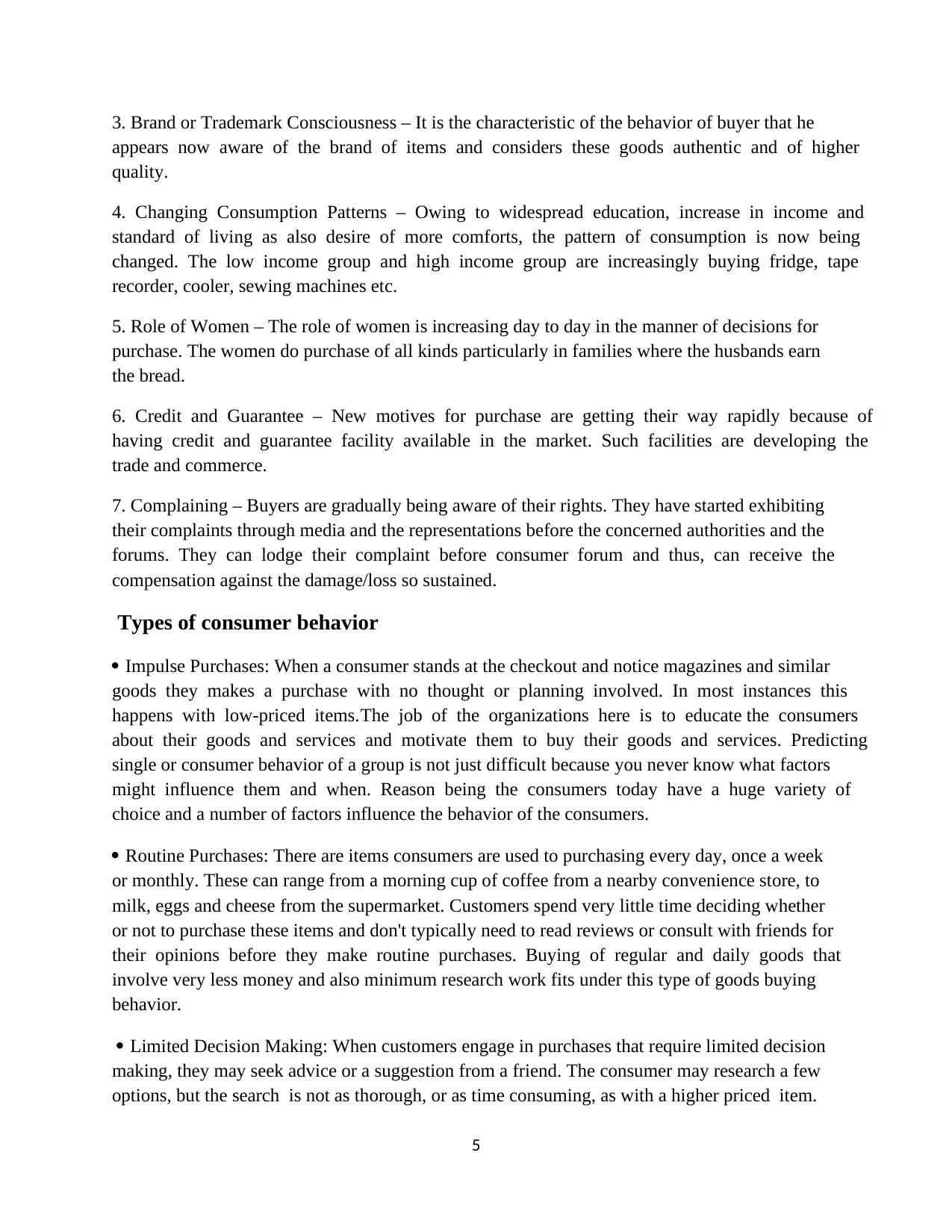
5
3. Brand or Trademark Consciousness – It is the characteristic of the behavior of buyer that he
appears now aware of the brand of items and considers these goods authentic and of higher
quality.
4. Changing Consumption Patterns – Owing to widespread education, increase in income and
standard of living as also desire of more comforts, the pattern of consumption is now being
changed. The low income group and high income group are increasingly buying fridge, tape
recorder, cooler, sewing machines etc.
5. Role of Women – The role of women is increasing day to day in the manner of decisions for
purchase. The women do purchase of all kinds particularly in families where the husbands earn
the bread.
6. Credit and Guarantee – New motives for purchase are getting their way rapidly because of
having credit and guarantee facility available in the market. Such facilities are developing the
trade and commerce.
7. Complaining – Buyers are gradually being aware of their rights. They have started exhibiting
their complaints through media and the representations before the concerned authorities and the
forums. They can lodge their complaint before consumer forum and thus, can receive the
compensation against the damage/loss so sustained.
Types of consumer behavior
Impulse Purchases: When a consumer stands at the checkout and notice magazines and similar
goods they makes a purchase with no thought or planning involved. In most instances this
happens with low-priced items. The job of the organizations here is to educate the consumers
about their goods and services and motivate them to buy their goods and services. Predicting
single or consumer behavior of a group is not just difficult because you never know what factors
might influence them and when. Reason being the consumers today have a huge variety of
choice and a number of factors influence the behavior of the consumers.
Routine Purchases: There are items consumers are used to purchasing every day, once a week
or monthly. These can range from a morning cup of coffee from a nearby convenience store, to
milk, eggs and cheese from the supermarket. Customers spend very little time deciding whether
or not to purchase these items and don't typically need to read reviews or consult with friends for
their opinions before they make routine purchases. Buying of regular and daily goods that
involve very less money and also minimum research work fits under this type of goods buying
behavior.
Limited Decision Making: When customers engage in purchases that require limited decision
making, they may seek advice or a suggestion from a friend. The consumer may research a few
options, but the search is not as thorough, or as time consuming, as with a higher priced item.
3. Brand or Trademark Consciousness – It is the characteristic of the behavior of buyer that he
appears now aware of the brand of items and considers these goods authentic and of higher
quality.
4. Changing Consumption Patterns – Owing to widespread education, increase in income and
standard of living as also desire of more comforts, the pattern of consumption is now being
changed. The low income group and high income group are increasingly buying fridge, tape
recorder, cooler, sewing machines etc.
5. Role of Women – The role of women is increasing day to day in the manner of decisions for
purchase. The women do purchase of all kinds particularly in families where the husbands earn
the bread.
6. Credit and Guarantee – New motives for purchase are getting their way rapidly because of
having credit and guarantee facility available in the market. Such facilities are developing the
trade and commerce.
7. Complaining – Buyers are gradually being aware of their rights. They have started exhibiting
their complaints through media and the representations before the concerned authorities and the
forums. They can lodge their complaint before consumer forum and thus, can receive the
compensation against the damage/loss so sustained.
Types of consumer behavior
Impulse Purchases: When a consumer stands at the checkout and notice magazines and similar
goods they makes a purchase with no thought or planning involved. In most instances this
happens with low-priced items. The job of the organizations here is to educate the consumers
about their goods and services and motivate them to buy their goods and services. Predicting
single or consumer behavior of a group is not just difficult because you never know what factors
might influence them and when. Reason being the consumers today have a huge variety of
choice and a number of factors influence the behavior of the consumers.
Routine Purchases: There are items consumers are used to purchasing every day, once a week
or monthly. These can range from a morning cup of coffee from a nearby convenience store, to
milk, eggs and cheese from the supermarket. Customers spend very little time deciding whether
or not to purchase these items and don't typically need to read reviews or consult with friends for
their opinions before they make routine purchases. Buying of regular and daily goods that
involve very less money and also minimum research work fits under this type of goods buying
behavior.
Limited Decision Making: When customers engage in purchases that require limited decision
making, they may seek advice or a suggestion from a friend. The consumer may research a few
options, but the search is not as thorough, or as time consuming, as with a higher priced item.

6
When a consumer tries to gain information about unfamiliar brands of familiar products of not
very high value goods this is when a consumer makes a decision however occasionally. The time
required to gather such information is quite moderate for example buying of goods like clothes
and cosmetics.
Extensive Decision Making: Purchases for high priced electronics, such as a television,
computer or camera, or major purchases such as a home or car require consumers to use
extensive decision making. Consumers spend substantial amounts of time researching a high
number of potential options before they buy. The decision making process lasts longer, as the
consumer is investing a substantial amount of money.Buying of products such as computers,
laptops, property, cars, education, etc which requires a huge amount of research and economic
involvement comes under this category or type. This decision take time as it needs too much of
research work as the consumer will study almost all the options available in his economic range,
the research is prolonged as the customer would want to buy the best option available for the
price he is paying.
Consumer Buying Behavior – Importance of Understanding Buyer Behavior
Understanding consumers’ buying behavior is one of the elements that help in achieving
marketing goals, without this understanding it makes gaining more customers difficult.
Especially in today’s competitive world. It also helps when customers will buy more from
business. Their buying behavior is one of the elements which must be understood for a better
view about the customer profile. Customers base their buying decisions on both rational and
emotional reasons. Due to the changing fashion, technology, trends, living style, disposable
income, and similar other factors, consumer behavior also changes. A marketer has to understand
the factors that are changing so that the marketing efforts can be aligned accordingly. Study of
consumer buying behavior is most important for marketers as they can understand the
expectation of the consumers. It helps to understand what makes a consumer to buy a product. It
is important to assess the kind of products liked by consumers so that they can release it to the
market. Marketers can understand the likes and dislikes of consumers and design base their
marketing efforts based on the findings. Understanding consumer behavior is essential for a
company to find success for its current products as well as new product launches. Every
consumer has a different thought process and attitude towards buying a particular product. If a
company fails to understand the reaction of a consumer towards a product, there are high chances
of product failure.
Consumer buying behavior studies about the various situations such as what do consumers buy,
why do they buy, when do they buy, how often do consumers buy, for what reason do they buy,
and much more.
When a consumer tries to gain information about unfamiliar brands of familiar products of not
very high value goods this is when a consumer makes a decision however occasionally. The time
required to gather such information is quite moderate for example buying of goods like clothes
and cosmetics.
Extensive Decision Making: Purchases for high priced electronics, such as a television,
computer or camera, or major purchases such as a home or car require consumers to use
extensive decision making. Consumers spend substantial amounts of time researching a high
number of potential options before they buy. The decision making process lasts longer, as the
consumer is investing a substantial amount of money.Buying of products such as computers,
laptops, property, cars, education, etc which requires a huge amount of research and economic
involvement comes under this category or type. This decision take time as it needs too much of
research work as the consumer will study almost all the options available in his economic range,
the research is prolonged as the customer would want to buy the best option available for the
price he is paying.
Consumer Buying Behavior – Importance of Understanding Buyer Behavior
Understanding consumers’ buying behavior is one of the elements that help in achieving
marketing goals, without this understanding it makes gaining more customers difficult.
Especially in today’s competitive world. It also helps when customers will buy more from
business. Their buying behavior is one of the elements which must be understood for a better
view about the customer profile. Customers base their buying decisions on both rational and
emotional reasons. Due to the changing fashion, technology, trends, living style, disposable
income, and similar other factors, consumer behavior also changes. A marketer has to understand
the factors that are changing so that the marketing efforts can be aligned accordingly. Study of
consumer buying behavior is most important for marketers as they can understand the
expectation of the consumers. It helps to understand what makes a consumer to buy a product. It
is important to assess the kind of products liked by consumers so that they can release it to the
market. Marketers can understand the likes and dislikes of consumers and design base their
marketing efforts based on the findings. Understanding consumer behavior is essential for a
company to find success for its current products as well as new product launches. Every
consumer has a different thought process and attitude towards buying a particular product. If a
company fails to understand the reaction of a consumer towards a product, there are high chances
of product failure.
Consumer buying behavior studies about the various situations such as what do consumers buy,
why do they buy, when do they buy, how often do consumers buy, for what reason do they buy,
and much more.
Paraphrase This Document
Need a fresh take? Get an instant paraphrase of this document with our AI Paraphraser
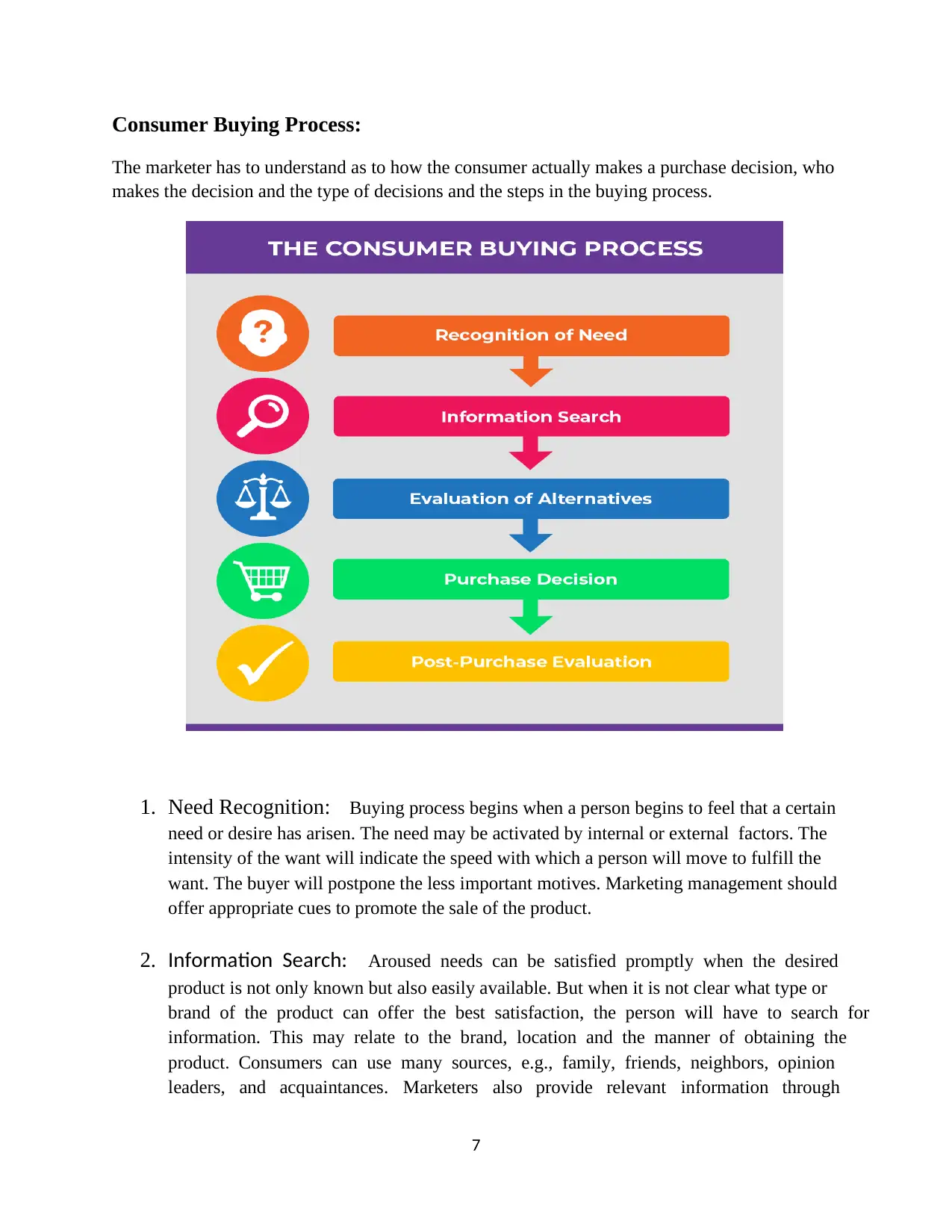
7
Consumer Buying Process:
The marketer has to understand as to how the consumer actually makes a purchase decision, who
makes the decision and the type of decisions and the steps in the buying process.
1. Need Recognition: Buying process begins when a person begins to feel that a certain
need or desire has arisen. The need may be activated by internal or external factors. The
intensity of the want will indicate the speed with which a person will move to fulfill the
want. The buyer will postpone the less important motives. Marketing management should
offer appropriate cues to promote the sale of the product.
2. Information Search: Aroused needs can be satisfied promptly when the desired
product is not only known but also easily available. But when it is not clear what type or
brand of the product can offer the best satisfaction, the person will have to search for
information. This may relate to the brand, location and the manner of obtaining the
product. Consumers can use many sources, e.g., family, friends, neighbors, opinion
leaders, and acquaintances. Marketers also provide relevant information through
Consumer Buying Process:
The marketer has to understand as to how the consumer actually makes a purchase decision, who
makes the decision and the type of decisions and the steps in the buying process.
1. Need Recognition: Buying process begins when a person begins to feel that a certain
need or desire has arisen. The need may be activated by internal or external factors. The
intensity of the want will indicate the speed with which a person will move to fulfill the
want. The buyer will postpone the less important motives. Marketing management should
offer appropriate cues to promote the sale of the product.
2. Information Search: Aroused needs can be satisfied promptly when the desired
product is not only known but also easily available. But when it is not clear what type or
brand of the product can offer the best satisfaction, the person will have to search for
information. This may relate to the brand, location and the manner of obtaining the
product. Consumers can use many sources, e.g., family, friends, neighbors, opinion
leaders, and acquaintances. Marketers also provide relevant information through
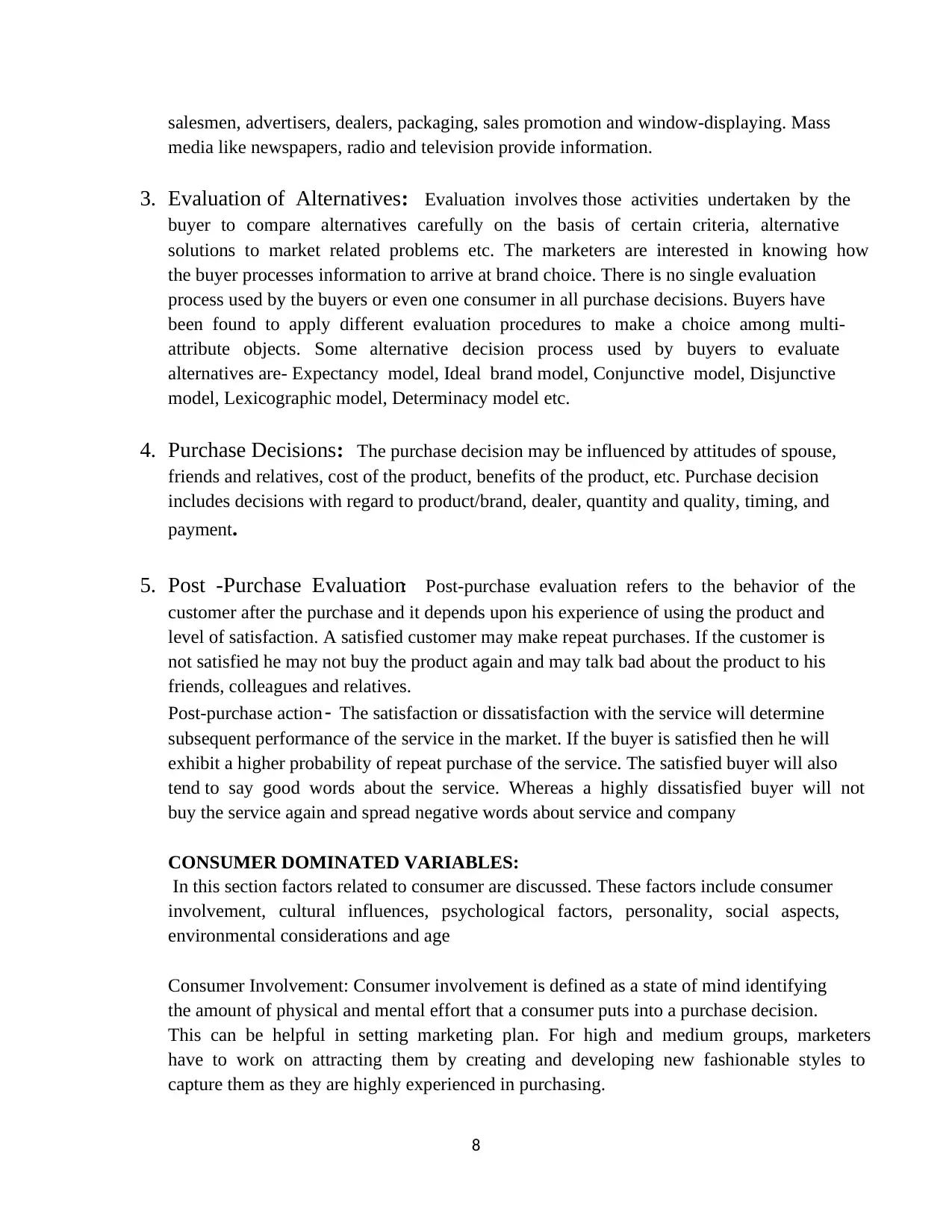
8
salesmen, advertisers, dealers, packaging, sales promotion and window-displaying. Mass
media like newspapers, radio and television provide information.
3. Evaluation of Alternatives: Evaluation involves those activities undertaken by the
buyer to compare alternatives carefully on the basis of certain criteria, alternative
solutions to market related problems etc. The marketers are interested in knowing how
the buyer processes information to arrive at brand choice. There is no single evaluation
process used by the buyers or even one consumer in all purchase decisions. Buyers have
been found to apply different evaluation procedures to make a choice among multi-
attribute objects. Some alternative decision process used by buyers to evaluate
alternatives are- Expectancy model, Ideal brand model, Conjunctive model, Disjunctive
model, Lexicographic model, Determinacy model etc.
4. Purchase Decisions: The purchase decision may be influenced by attitudes of spouse,
friends and relatives, cost of the product, benefits of the product, etc. Purchase decision
includes decisions with regard to product/brand, dealer, quantity and quality, timing, and
payment.
5. Post -Purchase Evaluation: Post-purchase evaluation refers to the behavior of the
customer after the purchase and it depends upon his experience of using the product and
level of satisfaction. A satisfied customer may make repeat purchases. If the customer is
not satisfied he may not buy the product again and may talk bad about the product to his
friends, colleagues and relatives.
Post-purchase action- The satisfaction or dissatisfaction with the service will determine
subsequent performance of the service in the market. If the buyer is satisfied then he will
exhibit a higher probability of repeat purchase of the service. The satisfied buyer will also
tend to say good words about the service. Whereas a highly dissatisfied buyer will not
buy the service again and spread negative words about service and company
CONSUMER DOMINATED VARIABLES:
In this section factors related to consumer are discussed. These factors include consumer
involvement, cultural influences, psychological factors, personality, social aspects,
environmental considerations and age
Consumer Involvement: Consumer involvement is defined as a state of mind identifying
the amount of physical and mental effort that a consumer puts into a purchase decision.
This can be helpful in setting marketing plan. For high and medium groups, marketers
have to work on attracting them by creating and developing new fashionable styles to
capture them as they are highly experienced in purchasing.
salesmen, advertisers, dealers, packaging, sales promotion and window-displaying. Mass
media like newspapers, radio and television provide information.
3. Evaluation of Alternatives: Evaluation involves those activities undertaken by the
buyer to compare alternatives carefully on the basis of certain criteria, alternative
solutions to market related problems etc. The marketers are interested in knowing how
the buyer processes information to arrive at brand choice. There is no single evaluation
process used by the buyers or even one consumer in all purchase decisions. Buyers have
been found to apply different evaluation procedures to make a choice among multi-
attribute objects. Some alternative decision process used by buyers to evaluate
alternatives are- Expectancy model, Ideal brand model, Conjunctive model, Disjunctive
model, Lexicographic model, Determinacy model etc.
4. Purchase Decisions: The purchase decision may be influenced by attitudes of spouse,
friends and relatives, cost of the product, benefits of the product, etc. Purchase decision
includes decisions with regard to product/brand, dealer, quantity and quality, timing, and
payment.
5. Post -Purchase Evaluation: Post-purchase evaluation refers to the behavior of the
customer after the purchase and it depends upon his experience of using the product and
level of satisfaction. A satisfied customer may make repeat purchases. If the customer is
not satisfied he may not buy the product again and may talk bad about the product to his
friends, colleagues and relatives.
Post-purchase action- The satisfaction or dissatisfaction with the service will determine
subsequent performance of the service in the market. If the buyer is satisfied then he will
exhibit a higher probability of repeat purchase of the service. The satisfied buyer will also
tend to say good words about the service. Whereas a highly dissatisfied buyer will not
buy the service again and spread negative words about service and company
CONSUMER DOMINATED VARIABLES:
In this section factors related to consumer are discussed. These factors include consumer
involvement, cultural influences, psychological factors, personality, social aspects,
environmental considerations and age
Consumer Involvement: Consumer involvement is defined as a state of mind identifying
the amount of physical and mental effort that a consumer puts into a purchase decision.
This can be helpful in setting marketing plan. For high and medium groups, marketers
have to work on attracting them by creating and developing new fashionable styles to
capture them as they are highly experienced in purchasing.
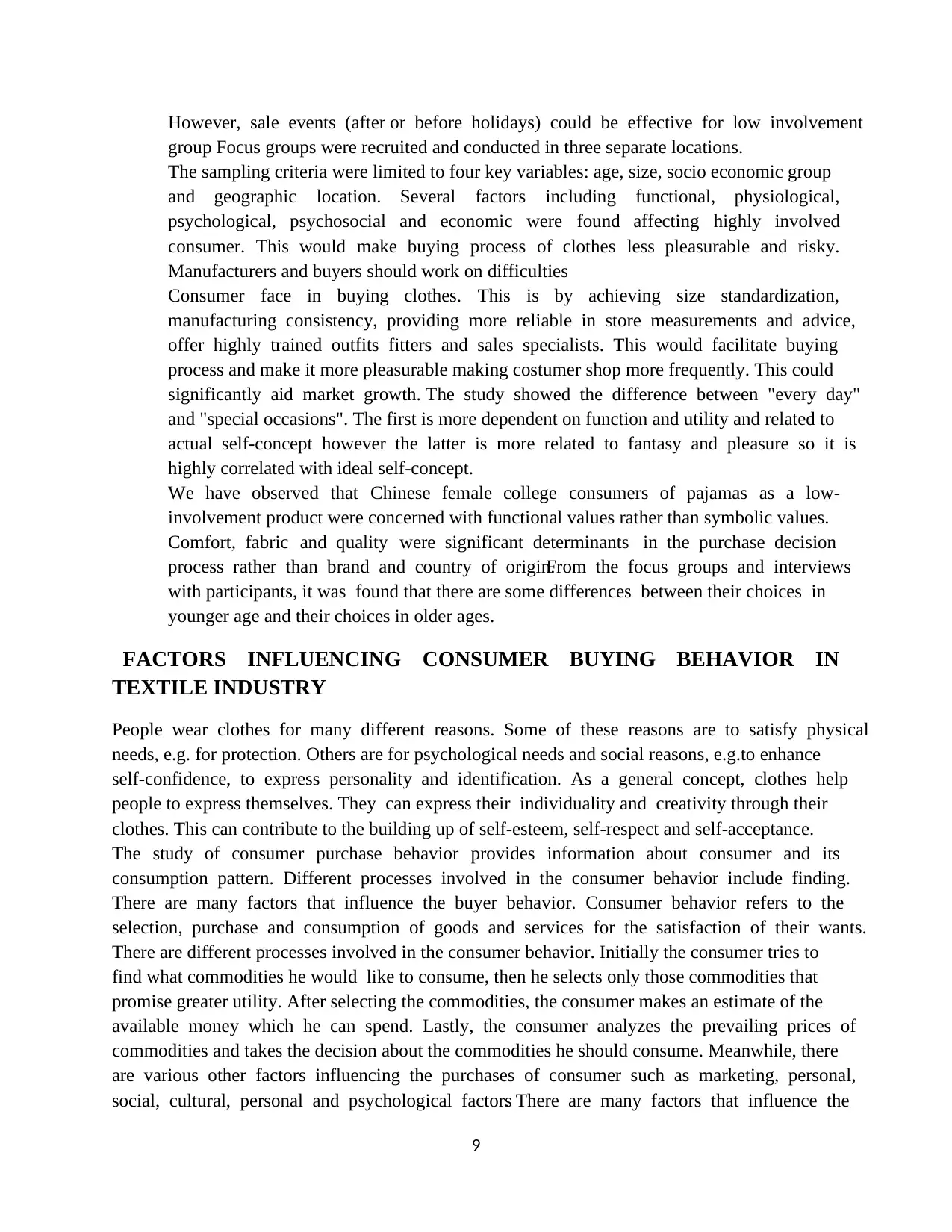
9
However, sale events (after or before holidays) could be effective for low involvement
group Focus groups were recruited and conducted in three separate locations.
The sampling criteria were limited to four key variables: age, size, socio economic group
and geographic location. Several factors including functional, physiological,
psychological, psychosocial and economic were found affecting highly involved
consumer. This would make buying process of clothes less pleasurable and risky.
Manufacturers and buyers should work on difficulties
Consumer face in buying clothes. This is by achieving size standardization,
manufacturing consistency, providing more reliable in store measurements and advice,
offer highly trained outfits fitters and sales specialists. This would facilitate buying
process and make it more pleasurable making costumer shop more frequently. This could
significantly aid market growth. The study showed the difference between "every day"
and "special occasions". The first is more dependent on function and utility and related to
actual self-concept however the latter is more related to fantasy and pleasure so it is
highly correlated with ideal self-concept.
We have observed that Chinese female college consumers of pajamas as a low-
involvement product were concerned with functional values rather than symbolic values.
Comfort, fabric and quality were significant determinants in the purchase decision
process rather than brand and country of origin.From the focus groups and interviews
with participants, it was found that there are some differences between their choices in
younger age and their choices in older ages.
FACTORS INFLUENCING CONSUMER BUYING BEHAVIOR IN
TEXTILE INDUSTRY
People wear clothes for many different reasons. Some of these reasons are to satisfy physical
needs, e.g. for protection. Others are for psychological needs and social reasons, e.g.to enhance
self-confidence, to express personality and identification. As a general concept, clothes help
people to express themselves. They can express their individuality and creativity through their
clothes. This can contribute to the building up of self-esteem, self-respect and self-acceptance.
The study of consumer purchase behavior provides information about consumer and its
consumption pattern. Different processes involved in the consumer behavior include finding.
There are many factors that influence the buyer behavior. Consumer behavior refers to the
selection, purchase and consumption of goods and services for the satisfaction of their wants.
There are different processes involved in the consumer behavior. Initially the consumer tries to
find what commodities he would like to consume, then he selects only those commodities that
promise greater utility. After selecting the commodities, the consumer makes an estimate of the
available money which he can spend. Lastly, the consumer analyzes the prevailing prices of
commodities and takes the decision about the commodities he should consume. Meanwhile, there
are various other factors influencing the purchases of consumer such as marketing, personal,
social, cultural, personal and psychological factors. There are many factors that influence the
However, sale events (after or before holidays) could be effective for low involvement
group Focus groups were recruited and conducted in three separate locations.
The sampling criteria were limited to four key variables: age, size, socio economic group
and geographic location. Several factors including functional, physiological,
psychological, psychosocial and economic were found affecting highly involved
consumer. This would make buying process of clothes less pleasurable and risky.
Manufacturers and buyers should work on difficulties
Consumer face in buying clothes. This is by achieving size standardization,
manufacturing consistency, providing more reliable in store measurements and advice,
offer highly trained outfits fitters and sales specialists. This would facilitate buying
process and make it more pleasurable making costumer shop more frequently. This could
significantly aid market growth. The study showed the difference between "every day"
and "special occasions". The first is more dependent on function and utility and related to
actual self-concept however the latter is more related to fantasy and pleasure so it is
highly correlated with ideal self-concept.
We have observed that Chinese female college consumers of pajamas as a low-
involvement product were concerned with functional values rather than symbolic values.
Comfort, fabric and quality were significant determinants in the purchase decision
process rather than brand and country of origin.From the focus groups and interviews
with participants, it was found that there are some differences between their choices in
younger age and their choices in older ages.
FACTORS INFLUENCING CONSUMER BUYING BEHAVIOR IN
TEXTILE INDUSTRY
People wear clothes for many different reasons. Some of these reasons are to satisfy physical
needs, e.g. for protection. Others are for psychological needs and social reasons, e.g.to enhance
self-confidence, to express personality and identification. As a general concept, clothes help
people to express themselves. They can express their individuality and creativity through their
clothes. This can contribute to the building up of self-esteem, self-respect and self-acceptance.
The study of consumer purchase behavior provides information about consumer and its
consumption pattern. Different processes involved in the consumer behavior include finding.
There are many factors that influence the buyer behavior. Consumer behavior refers to the
selection, purchase and consumption of goods and services for the satisfaction of their wants.
There are different processes involved in the consumer behavior. Initially the consumer tries to
find what commodities he would like to consume, then he selects only those commodities that
promise greater utility. After selecting the commodities, the consumer makes an estimate of the
available money which he can spend. Lastly, the consumer analyzes the prevailing prices of
commodities and takes the decision about the commodities he should consume. Meanwhile, there
are various other factors influencing the purchases of consumer such as marketing, personal,
social, cultural, personal and psychological factors. There are many factors that influence the
Secure Best Marks with AI Grader
Need help grading? Try our AI Grader for instant feedback on your assignments.

10
buyer behavior. Consumer behavior refers to the selection, purchase and consumption of goods
and services for the satisfaction of their wants. There are different processes involved in the
consumer behavior. Initially the consumer tries to find what commodities he would like to
consume, then he selects only those commodities that promise greater utility. After selecting the
commodities, the consumer makes an estimate of the available money which he can spend.
Lastly, the consumer analyzes the prevailing prices of commodities and takes the decision about
the commodities he should consume. Meanwhile, there are various other factors influencing the
purchases of consumer such as marketing, personal, social, cultural, personal and psychological
factors.
What commodities the consumers would like to buy. Marketers study consumers buying patterns
in order to decide where they buy, and what they buy and why they buy.
buyer behavior. Consumer behavior refers to the selection, purchase and consumption of goods
and services for the satisfaction of their wants. There are different processes involved in the
consumer behavior. Initially the consumer tries to find what commodities he would like to
consume, then he selects only those commodities that promise greater utility. After selecting the
commodities, the consumer makes an estimate of the available money which he can spend.
Lastly, the consumer analyzes the prevailing prices of commodities and takes the decision about
the commodities he should consume. Meanwhile, there are various other factors influencing the
purchases of consumer such as marketing, personal, social, cultural, personal and psychological
factors.
What commodities the consumers would like to buy. Marketers study consumers buying patterns
in order to decide where they buy, and what they buy and why they buy.
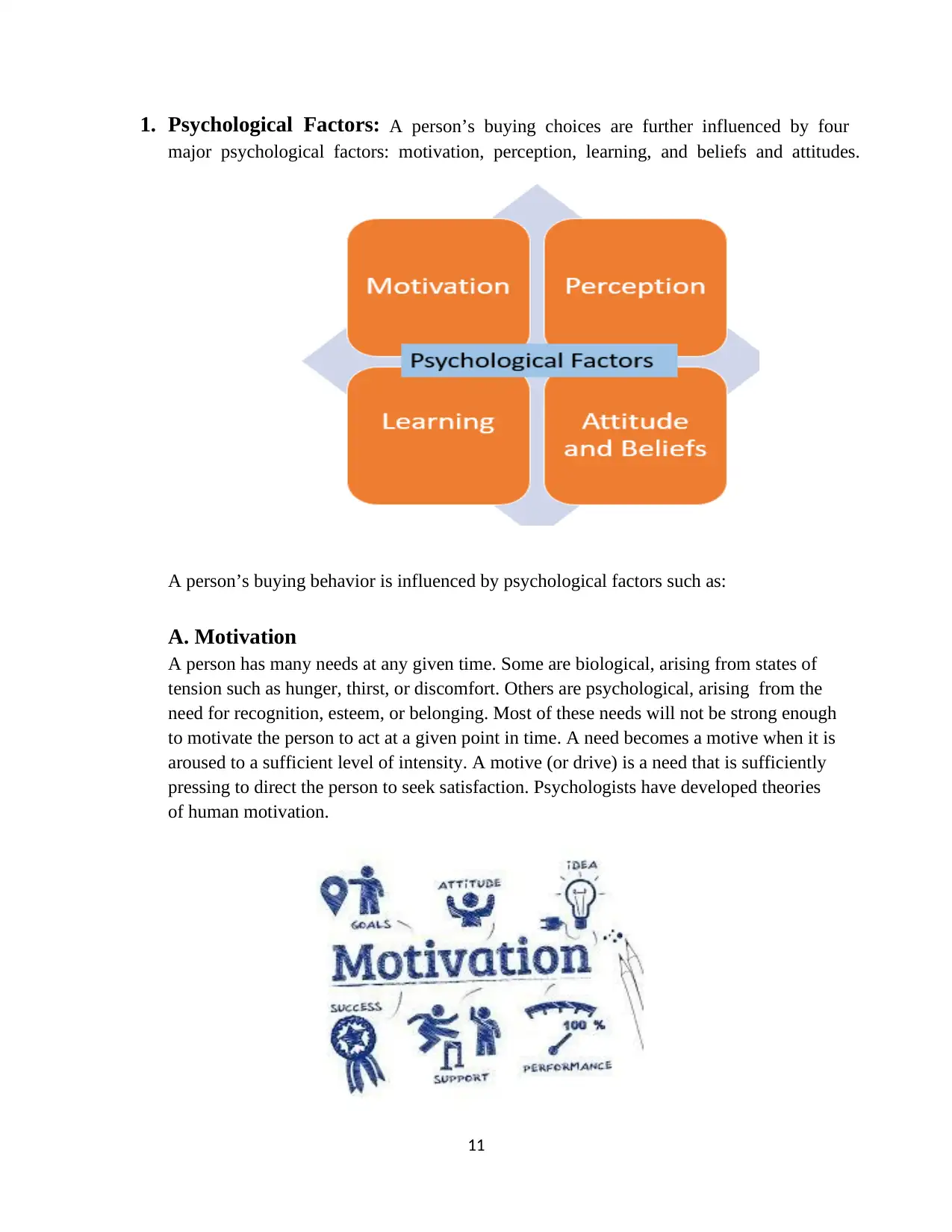
11
1. Psychological Factors: A person’s buying choices are further influenced by four
major psychological factors: motivation, perception, learning, and beliefs and attitudes.
A person’s buying behavior is influenced by psychological factors such as:
A. Motivation
A person has many needs at any given time. Some are biological, arising from states of
tension such as hunger, thirst, or discomfort. Others are psychological, arising from the
need for recognition, esteem, or belonging. Most of these needs will not be strong enough
to motivate the person to act at a given point in time. A need becomes a motive when it is
aroused to a sufficient level of intensity. A motive (or drive) is a need that is sufficiently
pressing to direct the person to seek satisfaction. Psychologists have developed theories
of human motivation.
1. Psychological Factors: A person’s buying choices are further influenced by four
major psychological factors: motivation, perception, learning, and beliefs and attitudes.
A person’s buying behavior is influenced by psychological factors such as:
A. Motivation
A person has many needs at any given time. Some are biological, arising from states of
tension such as hunger, thirst, or discomfort. Others are psychological, arising from the
need for recognition, esteem, or belonging. Most of these needs will not be strong enough
to motivate the person to act at a given point in time. A need becomes a motive when it is
aroused to a sufficient level of intensity. A motive (or drive) is a need that is sufficiently
pressing to direct the person to seek satisfaction. Psychologists have developed theories
of human motivation.
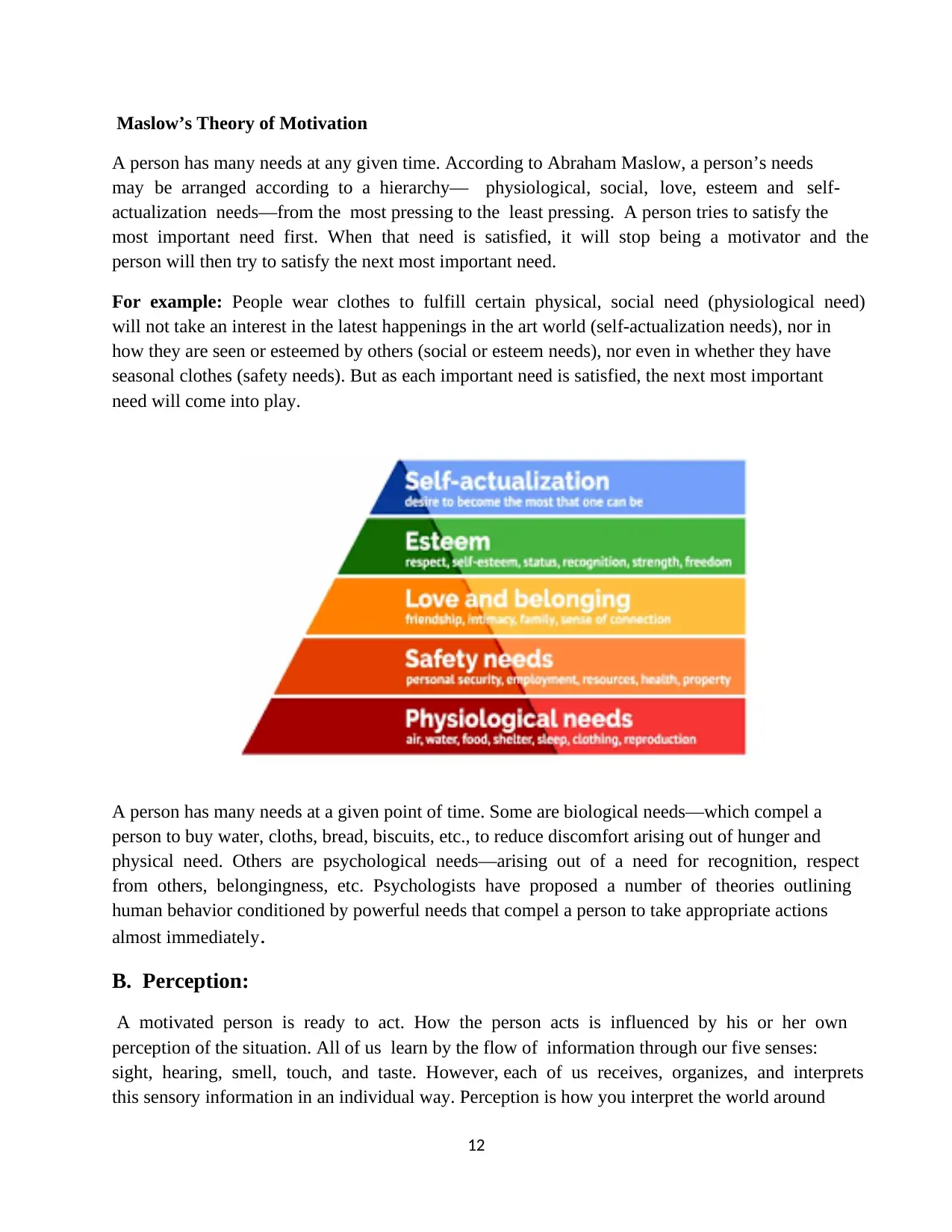
12
Maslow’s Theory of Motivation
A person has many needs at any given time. According to Abraham Maslow, a person’s needs
may be arranged according to a hierarchy— physiological, social, love, esteem and self-
actualization needs—from the most pressing to the least pressing. A person tries to satisfy the
most important need first. When that need is satisfied, it will stop being a motivator and the
person will then try to satisfy the next most important need.
For example: People wear clothes to fulfill certain physical, social need (physiological need)
will not take an interest in the latest happenings in the art world (self-actualization needs), nor in
how they are seen or esteemed by others (social or esteem needs), nor even in whether they have
seasonal clothes (safety needs). But as each important need is satisfied, the next most important
need will come into play.
A person has many needs at a given point of time. Some are biological needs—which compel a
person to buy water, cloths, bread, biscuits, etc., to reduce discomfort arising out of hunger and
physical need. Others are psychological needs—arising out of a need for recognition, respect
from others, belongingness, etc. Psychologists have proposed a number of theories outlining
human behavior conditioned by powerful needs that compel a person to take appropriate actions
almost immediately.
B. Perception:
A motivated person is ready to act. How the person acts is influenced by his or her own
perception of the situation. All of us learn by the flow of information through our five senses:
sight, hearing, smell, touch, and taste. However, each of us receives, organizes, and interprets
this sensory information in an individual way. Perception is how you interpret the world around
Maslow’s Theory of Motivation
A person has many needs at any given time. According to Abraham Maslow, a person’s needs
may be arranged according to a hierarchy— physiological, social, love, esteem and self-
actualization needs—from the most pressing to the least pressing. A person tries to satisfy the
most important need first. When that need is satisfied, it will stop being a motivator and the
person will then try to satisfy the next most important need.
For example: People wear clothes to fulfill certain physical, social need (physiological need)
will not take an interest in the latest happenings in the art world (self-actualization needs), nor in
how they are seen or esteemed by others (social or esteem needs), nor even in whether they have
seasonal clothes (safety needs). But as each important need is satisfied, the next most important
need will come into play.
A person has many needs at a given point of time. Some are biological needs—which compel a
person to buy water, cloths, bread, biscuits, etc., to reduce discomfort arising out of hunger and
physical need. Others are psychological needs—arising out of a need for recognition, respect
from others, belongingness, etc. Psychologists have proposed a number of theories outlining
human behavior conditioned by powerful needs that compel a person to take appropriate actions
almost immediately.
B. Perception:
A motivated person is ready to act. How the person acts is influenced by his or her own
perception of the situation. All of us learn by the flow of information through our five senses:
sight, hearing, smell, touch, and taste. However, each of us receives, organizes, and interprets
this sensory information in an individual way. Perception is how you interpret the world around
Paraphrase This Document
Need a fresh take? Get an instant paraphrase of this document with our AI Paraphraser
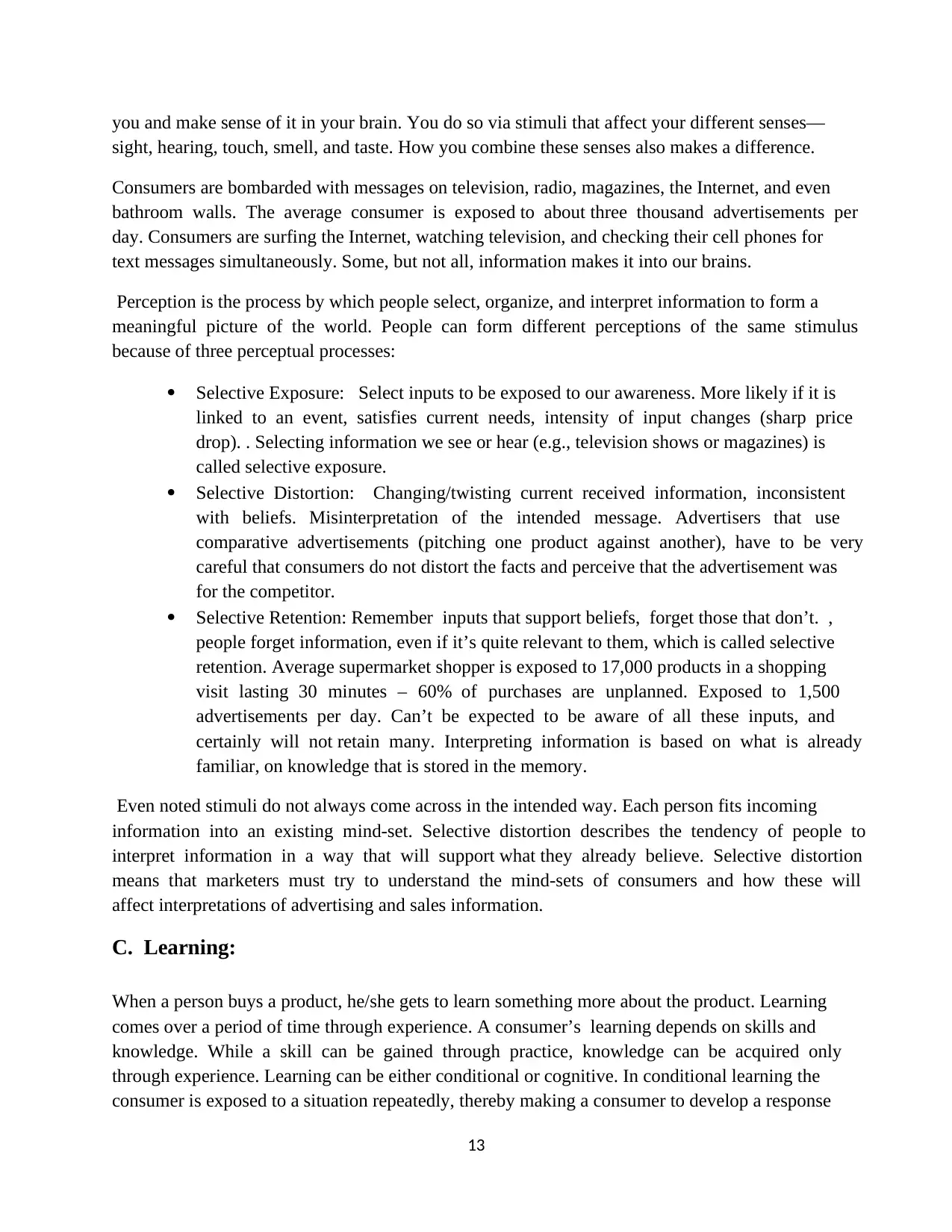
13
you and make sense of it in your brain. You do so via stimuli that affect your different senses—
sight, hearing, touch, smell, and taste. How you combine these senses also makes a difference.
Consumers are bombarded with messages on television, radio, magazines, the Internet, and even
bathroom walls. The average consumer is exposed to about three thousand advertisements per
day. Consumers are surfing the Internet, watching television, and checking their cell phones for
text messages simultaneously. Some, but not all, information makes it into our brains.
Perception is the process by which people select, organize, and interpret information to form a
meaningful picture of the world. People can form different perceptions of the same stimulus
because of three perceptual processes:
Selective Exposure: Select inputs to be exposed to our awareness. More likely if it is
linked to an event, satisfies current needs, intensity of input changes (sharp price
drop). . Selecting information we see or hear (e.g., television shows or magazines) is
called selective exposure.
Selective Distortion: Changing/twisting current received information, inconsistent
with beliefs. Misinterpretation of the intended message. Advertisers that use
comparative advertisements (pitching one product against another), have to be very
careful that consumers do not distort the facts and perceive that the advertisement was
for the competitor.
Selective Retention: Remember inputs that support beliefs, forget those that don’t. ,
people forget information, even if it’s quite relevant to them, which is called selective
retention. Average supermarket shopper is exposed to 17,000 products in a shopping
visit lasting 30 minutes – 60% of purchases are unplanned. Exposed to 1,500
advertisements per day. Can’t be expected to be aware of all these inputs, and
certainly will not retain many. Interpreting information is based on what is already
familiar, on knowledge that is stored in the memory.
Even noted stimuli do not always come across in the intended way. Each person fits incoming
information into an existing mind-set. Selective distortion describes the tendency of people to
interpret information in a way that will support what they already believe. Selective distortion
means that marketers must try to understand the mind-sets of consumers and how these will
affect interpretations of advertising and sales information.
C. Learning:
When a person buys a product, he/she gets to learn something more about the product. Learning
comes over a period of time through experience. A consumer’s learning depends on skills and
knowledge. While a skill can be gained through practice, knowledge can be acquired only
through experience. Learning can be either conditional or cognitive. In conditional learning the
consumer is exposed to a situation repeatedly, thereby making a consumer to develop a response
you and make sense of it in your brain. You do so via stimuli that affect your different senses—
sight, hearing, touch, smell, and taste. How you combine these senses also makes a difference.
Consumers are bombarded with messages on television, radio, magazines, the Internet, and even
bathroom walls. The average consumer is exposed to about three thousand advertisements per
day. Consumers are surfing the Internet, watching television, and checking their cell phones for
text messages simultaneously. Some, but not all, information makes it into our brains.
Perception is the process by which people select, organize, and interpret information to form a
meaningful picture of the world. People can form different perceptions of the same stimulus
because of three perceptual processes:
Selective Exposure: Select inputs to be exposed to our awareness. More likely if it is
linked to an event, satisfies current needs, intensity of input changes (sharp price
drop). . Selecting information we see or hear (e.g., television shows or magazines) is
called selective exposure.
Selective Distortion: Changing/twisting current received information, inconsistent
with beliefs. Misinterpretation of the intended message. Advertisers that use
comparative advertisements (pitching one product against another), have to be very
careful that consumers do not distort the facts and perceive that the advertisement was
for the competitor.
Selective Retention: Remember inputs that support beliefs, forget those that don’t. ,
people forget information, even if it’s quite relevant to them, which is called selective
retention. Average supermarket shopper is exposed to 17,000 products in a shopping
visit lasting 30 minutes – 60% of purchases are unplanned. Exposed to 1,500
advertisements per day. Can’t be expected to be aware of all these inputs, and
certainly will not retain many. Interpreting information is based on what is already
familiar, on knowledge that is stored in the memory.
Even noted stimuli do not always come across in the intended way. Each person fits incoming
information into an existing mind-set. Selective distortion describes the tendency of people to
interpret information in a way that will support what they already believe. Selective distortion
means that marketers must try to understand the mind-sets of consumers and how these will
affect interpretations of advertising and sales information.
C. Learning:
When a person buys a product, he/she gets to learn something more about the product. Learning
comes over a period of time through experience. A consumer’s learning depends on skills and
knowledge. While a skill can be gained through practice, knowledge can be acquired only
through experience. Learning can be either conditional or cognitive. In conditional learning the
consumer is exposed to a situation repeatedly, thereby making a consumer to develop a response
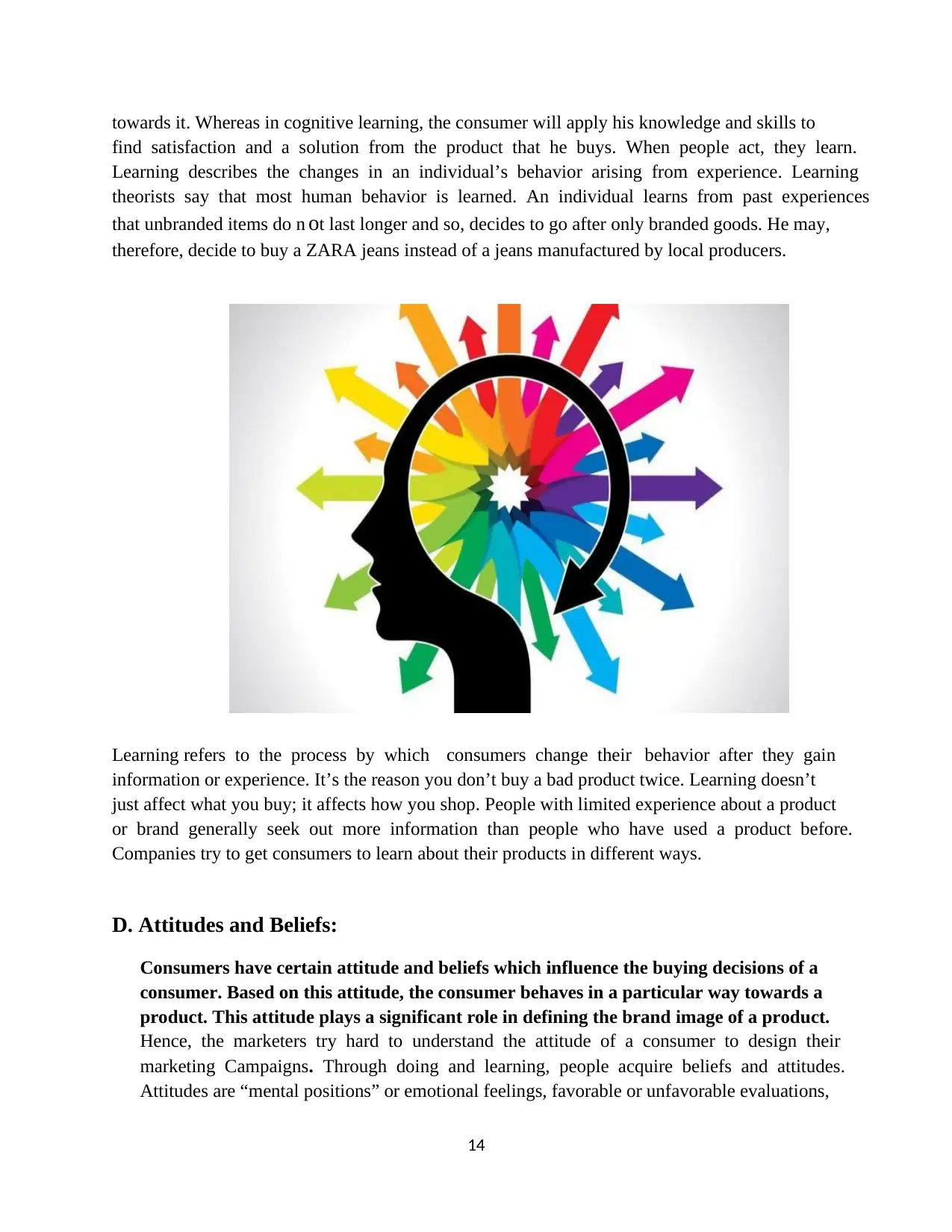
14
towards it. Whereas in cognitive learning, the consumer will apply his knowledge and skills to
find satisfaction and a solution from the product that he buys. When people act, they learn.
Learning describes the changes in an individual’s behavior arising from experience. Learning
theorists say that most human behavior is learned. An individual learns from past experiences
that unbranded items do n ot last longer and so, decides to go after only branded goods. He may,
therefore, decide to buy a ZARA jeans instead of a jeans manufactured by local producers.
Learning refers to the process by which consumers change their behavior after they gain
information or experience. It’s the reason you don’t buy a bad product twice. Learning doesn’t
just affect what you buy; it affects how you shop. People with limited experience about a product
or brand generally seek out more information than people who have used a product before.
Companies try to get consumers to learn about their products in different ways.
D. Attitudes and Beliefs:
Consumers have certain attitude and beliefs which influence the buying decisions of a
consumer. Based on this attitude, the consumer behaves in a particular way towards a
product. This attitude plays a significant role in defining the brand image of a product.
Hence, the marketers try hard to understand the attitude of a consumer to design their
marketing Campaigns. Through doing and learning, people acquire beliefs and attitudes.
Attitudes are “mental positions” or emotional feelings, favorable or unfavorable evaluations,
towards it. Whereas in cognitive learning, the consumer will apply his knowledge and skills to
find satisfaction and a solution from the product that he buys. When people act, they learn.
Learning describes the changes in an individual’s behavior arising from experience. Learning
theorists say that most human behavior is learned. An individual learns from past experiences
that unbranded items do n ot last longer and so, decides to go after only branded goods. He may,
therefore, decide to buy a ZARA jeans instead of a jeans manufactured by local producers.
Learning refers to the process by which consumers change their behavior after they gain
information or experience. It’s the reason you don’t buy a bad product twice. Learning doesn’t
just affect what you buy; it affects how you shop. People with limited experience about a product
or brand generally seek out more information than people who have used a product before.
Companies try to get consumers to learn about their products in different ways.
D. Attitudes and Beliefs:
Consumers have certain attitude and beliefs which influence the buying decisions of a
consumer. Based on this attitude, the consumer behaves in a particular way towards a
product. This attitude plays a significant role in defining the brand image of a product.
Hence, the marketers try hard to understand the attitude of a consumer to design their
marketing Campaigns. Through doing and learning, people acquire beliefs and attitudes.
Attitudes are “mental positions” or emotional feelings, favorable or unfavorable evaluations,
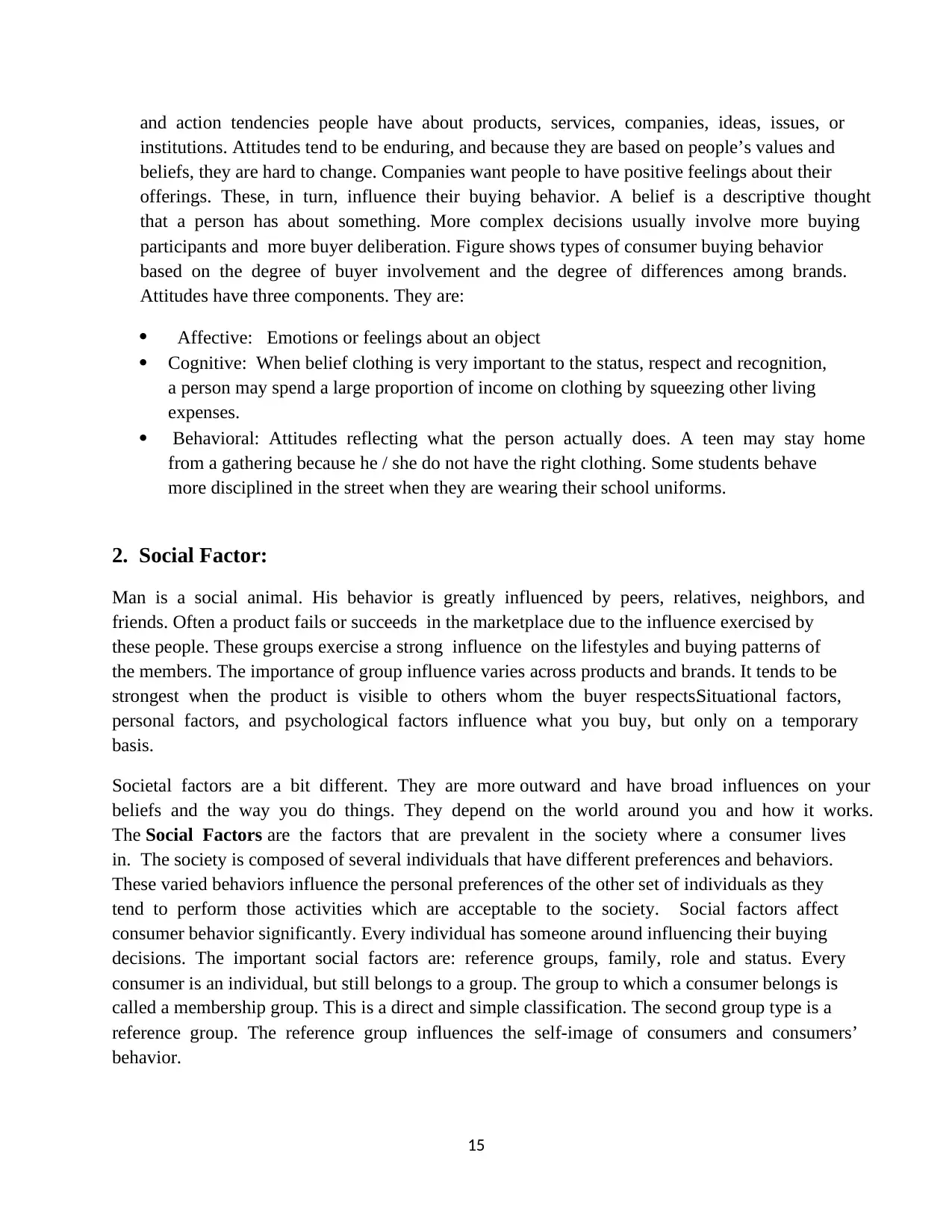
15
and action tendencies people have about products, services, companies, ideas, issues, or
institutions. Attitudes tend to be enduring, and because they are based on people’s values and
beliefs, they are hard to change. Companies want people to have positive feelings about their
offerings. These, in turn, influence their buying behavior. A belief is a descriptive thought
that a person has about something. More complex decisions usually involve more buying
participants and more buyer deliberation. Figure shows types of consumer buying behavior
based on the degree of buyer involvement and the degree of differences among brands.
Attitudes have three components. They are:
Affective: Emotions or feelings about an object
Cognitive: When belief clothing is very important to the status, respect and recognition,
a person may spend a large proportion of income on clothing by squeezing other living
expenses.
Behavioral: Attitudes reflecting what the person actually does. A teen may stay home
from a gathering because he / she do not have the right clothing. Some students behave
more disciplined in the street when they are wearing their school uniforms.
2. Social Factor:
Man is a social animal. His behavior is greatly influenced by peers, relatives, neighbors, and
friends. Often a product fails or succeeds in the marketplace due to the influence exercised by
these people. These groups exercise a strong influence on the lifestyles and buying patterns of
the members. The importance of group influence varies across products and brands. It tends to be
strongest when the product is visible to others whom the buyer respects.Situational factors,
personal factors, and psychological factors influence what you buy, but only on a temporary
basis.
Societal factors are a bit different. They are more outward and have broad influences on your
beliefs and the way you do things. They depend on the world around you and how it works.
The Social Factors are the factors that are prevalent in the society where a consumer lives
in. The society is composed of several individuals that have different preferences and behaviors.
These varied behaviors influence the personal preferences of the other set of individuals as they
tend to perform those activities which are acceptable to the society. Social factors affect
consumer behavior significantly. Every individual has someone around influencing their buying
decisions. The important social factors are: reference groups, family, role and status. Every
consumer is an individual, but still belongs to a group. The group to which a consumer belongs is
called a membership group. This is a direct and simple classification. The second group type is a
reference group. The reference group influences the self-image of consumers and consumers’
behavior.
and action tendencies people have about products, services, companies, ideas, issues, or
institutions. Attitudes tend to be enduring, and because they are based on people’s values and
beliefs, they are hard to change. Companies want people to have positive feelings about their
offerings. These, in turn, influence their buying behavior. A belief is a descriptive thought
that a person has about something. More complex decisions usually involve more buying
participants and more buyer deliberation. Figure shows types of consumer buying behavior
based on the degree of buyer involvement and the degree of differences among brands.
Attitudes have three components. They are:
Affective: Emotions or feelings about an object
Cognitive: When belief clothing is very important to the status, respect and recognition,
a person may spend a large proportion of income on clothing by squeezing other living
expenses.
Behavioral: Attitudes reflecting what the person actually does. A teen may stay home
from a gathering because he / she do not have the right clothing. Some students behave
more disciplined in the street when they are wearing their school uniforms.
2. Social Factor:
Man is a social animal. His behavior is greatly influenced by peers, relatives, neighbors, and
friends. Often a product fails or succeeds in the marketplace due to the influence exercised by
these people. These groups exercise a strong influence on the lifestyles and buying patterns of
the members. The importance of group influence varies across products and brands. It tends to be
strongest when the product is visible to others whom the buyer respects.Situational factors,
personal factors, and psychological factors influence what you buy, but only on a temporary
basis.
Societal factors are a bit different. They are more outward and have broad influences on your
beliefs and the way you do things. They depend on the world around you and how it works.
The Social Factors are the factors that are prevalent in the society where a consumer lives
in. The society is composed of several individuals that have different preferences and behaviors.
These varied behaviors influence the personal preferences of the other set of individuals as they
tend to perform those activities which are acceptable to the society. Social factors affect
consumer behavior significantly. Every individual has someone around influencing their buying
decisions. The important social factors are: reference groups, family, role and status. Every
consumer is an individual, but still belongs to a group. The group to which a consumer belongs is
called a membership group. This is a direct and simple classification. The second group type is a
reference group. The reference group influences the self-image of consumers and consumers’
behavior.
Secure Best Marks with AI Grader
Need help grading? Try our AI Grader for instant feedback on your assignments.
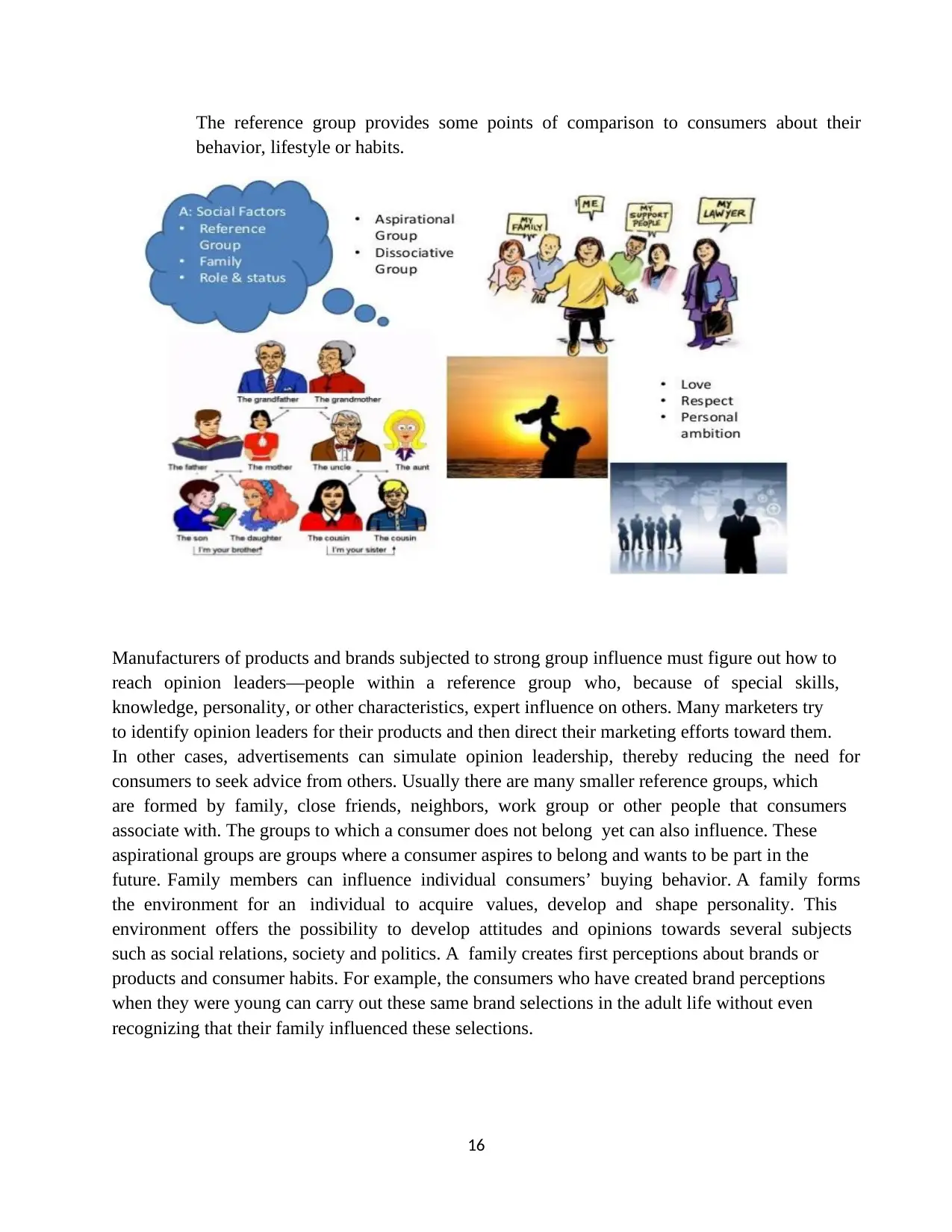
16
The reference group provides some points of comparison to consumers about their
behavior, lifestyle or habits.
Manufacturers of products and brands subjected to strong group influence must figure out how to
reach opinion leaders—people within a reference group who, because of special skills,
knowledge, personality, or other characteristics, expert influence on others. Many marketers try
to identify opinion leaders for their products and then direct their marketing efforts toward them.
In other cases, advertisements can simulate opinion leadership, thereby reducing the need for
consumers to seek advice from others. Usually there are many smaller reference groups, which
are formed by family, close friends, neighbors, work group or other people that consumers
associate with. The groups to which a consumer does not belong yet can also influence. These
aspirational groups are groups where a consumer aspires to belong and wants to be part in the
future. Family members can influence individual consumers’ buying behavior. A family forms
the environment for an individual to acquire values, develop and shape personality. This
environment offers the possibility to develop attitudes and opinions towards several subjects
such as social relations, society and politics. A family creates first perceptions about brands or
products and consumer habits. For example, the consumers who have created brand perceptions
when they were young can carry out these same brand selections in the adult life without even
recognizing that their family influenced these selections.
The reference group provides some points of comparison to consumers about their
behavior, lifestyle or habits.
Manufacturers of products and brands subjected to strong group influence must figure out how to
reach opinion leaders—people within a reference group who, because of special skills,
knowledge, personality, or other characteristics, expert influence on others. Many marketers try
to identify opinion leaders for their products and then direct their marketing efforts toward them.
In other cases, advertisements can simulate opinion leadership, thereby reducing the need for
consumers to seek advice from others. Usually there are many smaller reference groups, which
are formed by family, close friends, neighbors, work group or other people that consumers
associate with. The groups to which a consumer does not belong yet can also influence. These
aspirational groups are groups where a consumer aspires to belong and wants to be part in the
future. Family members can influence individual consumers’ buying behavior. A family forms
the environment for an individual to acquire values, develop and shape personality. This
environment offers the possibility to develop attitudes and opinions towards several subjects
such as social relations, society and politics. A family creates first perceptions about brands or
products and consumer habits. For example, the consumers who have created brand perceptions
when they were young can carry out these same brand selections in the adult life without even
recognizing that their family influenced these selections.
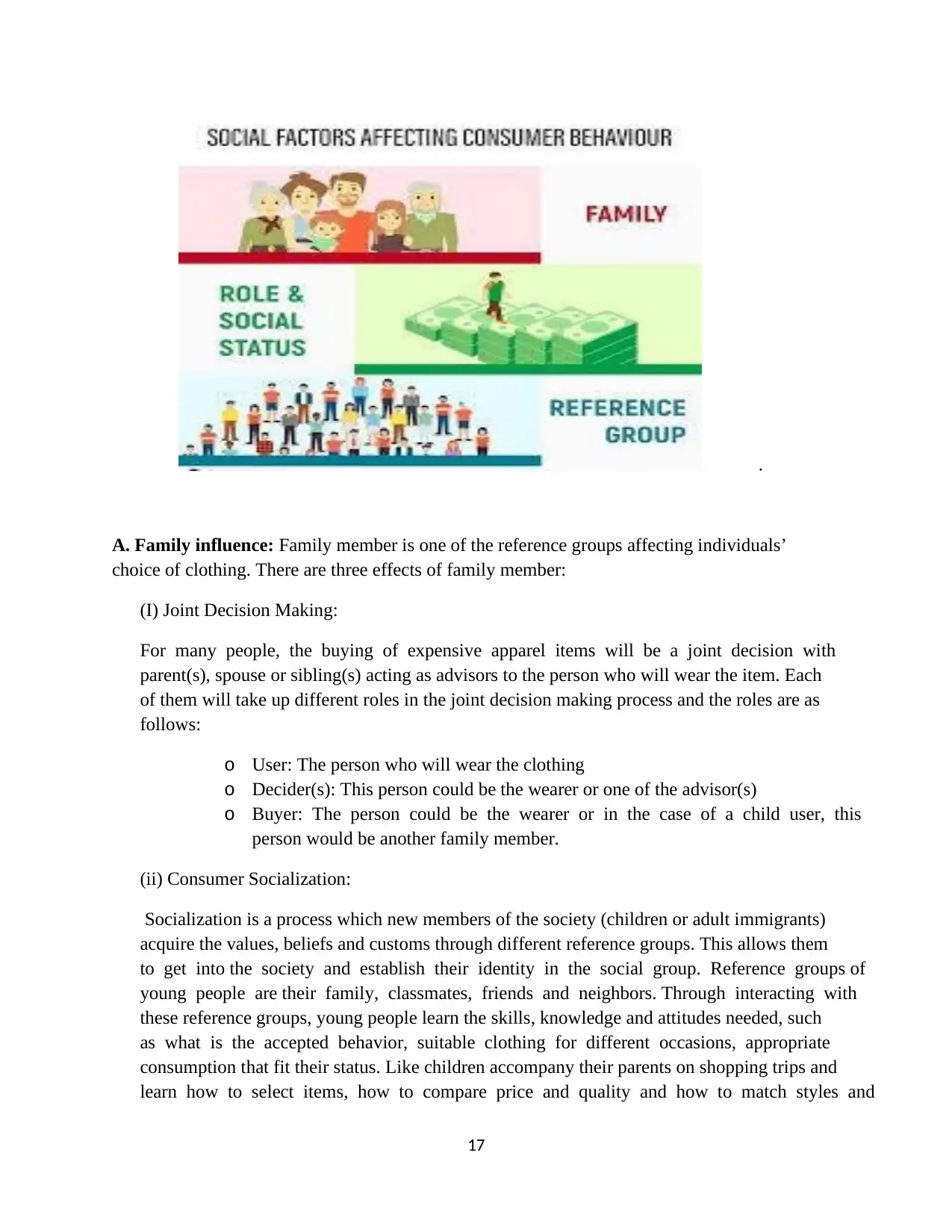
17
.
A. Family influence: Family member is one of the reference groups affecting individuals’
choice of clothing. There are three effects of family member:
(I) Joint Decision Making:
For many people, the buying of expensive apparel items will be a joint decision with
parent(s), spouse or sibling(s) acting as advisors to the person who will wear the item. Each
of them will take up different roles in the joint decision making process and the roles are as
follows:
o User: The person who will wear the clothing
o Decider(s): This person could be the wearer or one of the advisor(s)
o Buyer: The person could be the wearer or in the case of a child user, this
person would be another family member.
(ii) Consumer Socialization:
Socialization is a process which new members of the society (children or adult immigrants)
acquire the values, beliefs and customs through different reference groups. This allows them
to get into the society and establish their identity in the social group. Reference groups of
young people are their family, classmates, friends and neighbors. Through interacting with
these reference groups, young people learn the skills, knowledge and attitudes needed, such
as what is the accepted behavior, suitable clothing for different occasions, appropriate
consumption that fit their status. Like children accompany their parents on shopping trips and
learn how to select items, how to compare price and quality and how to match styles and
.
A. Family influence: Family member is one of the reference groups affecting individuals’
choice of clothing. There are three effects of family member:
(I) Joint Decision Making:
For many people, the buying of expensive apparel items will be a joint decision with
parent(s), spouse or sibling(s) acting as advisors to the person who will wear the item. Each
of them will take up different roles in the joint decision making process and the roles are as
follows:
o User: The person who will wear the clothing
o Decider(s): This person could be the wearer or one of the advisor(s)
o Buyer: The person could be the wearer or in the case of a child user, this
person would be another family member.
(ii) Consumer Socialization:
Socialization is a process which new members of the society (children or adult immigrants)
acquire the values, beliefs and customs through different reference groups. This allows them
to get into the society and establish their identity in the social group. Reference groups of
young people are their family, classmates, friends and neighbors. Through interacting with
these reference groups, young people learn the skills, knowledge and attitudes needed, such
as what is the accepted behavior, suitable clothing for different occasions, appropriate
consumption that fit their status. Like children accompany their parents on shopping trips and
learn how to select items, how to compare price and quality and how to match styles and
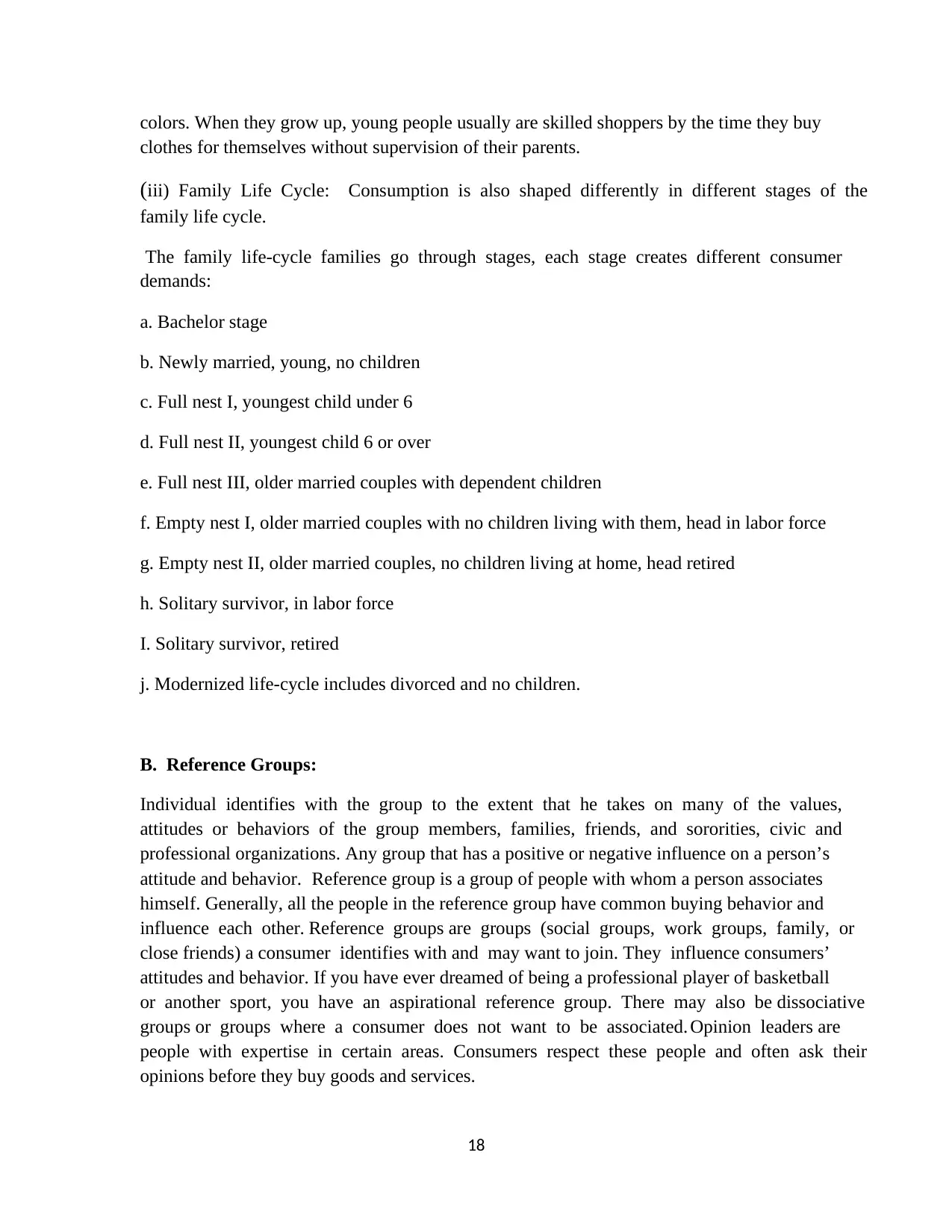
18
colors. When they grow up, young people usually are skilled shoppers by the time they buy
clothes for themselves without supervision of their parents.
(iii) Family Life Cycle: Consumption is also shaped differently in different stages of the
family life cycle.
The family life-cycle families go through stages, each stage creates different consumer
demands:
a. Bachelor stage
b. Newly married, young, no children
c. Full nest I, youngest child under 6
d. Full nest II, youngest child 6 or over
e. Full nest III, older married couples with dependent children
f. Empty nest I, older married couples with no children living with them, head in labor force
g. Empty nest II, older married couples, no children living at home, head retired
h. Solitary survivor, in labor force
I. Solitary survivor, retired
j. Modernized life-cycle includes divorced and no children.
B. Reference Groups:
Individual identifies with the group to the extent that he takes on many of the values,
attitudes or behaviors of the group members, families, friends, and sororities, civic and
professional organizations. Any group that has a positive or negative influence on a person’s
attitude and behavior. Reference group is a group of people with whom a person associates
himself. Generally, all the people in the reference group have common buying behavior and
influence each other. Reference groups are groups (social groups, work groups, family, or
close friends) a consumer identifies with and may want to join. They influence consumers’
attitudes and behavior. If you have ever dreamed of being a professional player of basketball
or another sport, you have an aspirational reference group. There may also be dissociative
groups or groups where a consumer does not want to be associated. Opinion leaders are
people with expertise in certain areas. Consumers respect these people and often ask their
opinions before they buy goods and services.
colors. When they grow up, young people usually are skilled shoppers by the time they buy
clothes for themselves without supervision of their parents.
(iii) Family Life Cycle: Consumption is also shaped differently in different stages of the
family life cycle.
The family life-cycle families go through stages, each stage creates different consumer
demands:
a. Bachelor stage
b. Newly married, young, no children
c. Full nest I, youngest child under 6
d. Full nest II, youngest child 6 or over
e. Full nest III, older married couples with dependent children
f. Empty nest I, older married couples with no children living with them, head in labor force
g. Empty nest II, older married couples, no children living at home, head retired
h. Solitary survivor, in labor force
I. Solitary survivor, retired
j. Modernized life-cycle includes divorced and no children.
B. Reference Groups:
Individual identifies with the group to the extent that he takes on many of the values,
attitudes or behaviors of the group members, families, friends, and sororities, civic and
professional organizations. Any group that has a positive or negative influence on a person’s
attitude and behavior. Reference group is a group of people with whom a person associates
himself. Generally, all the people in the reference group have common buying behavior and
influence each other. Reference groups are groups (social groups, work groups, family, or
close friends) a consumer identifies with and may want to join. They influence consumers’
attitudes and behavior. If you have ever dreamed of being a professional player of basketball
or another sport, you have an aspirational reference group. There may also be dissociative
groups or groups where a consumer does not want to be associated. Opinion leaders are
people with expertise in certain areas. Consumers respect these people and often ask their
opinions before they buy goods and services.
Paraphrase This Document
Need a fresh take? Get an instant paraphrase of this document with our AI Paraphraser
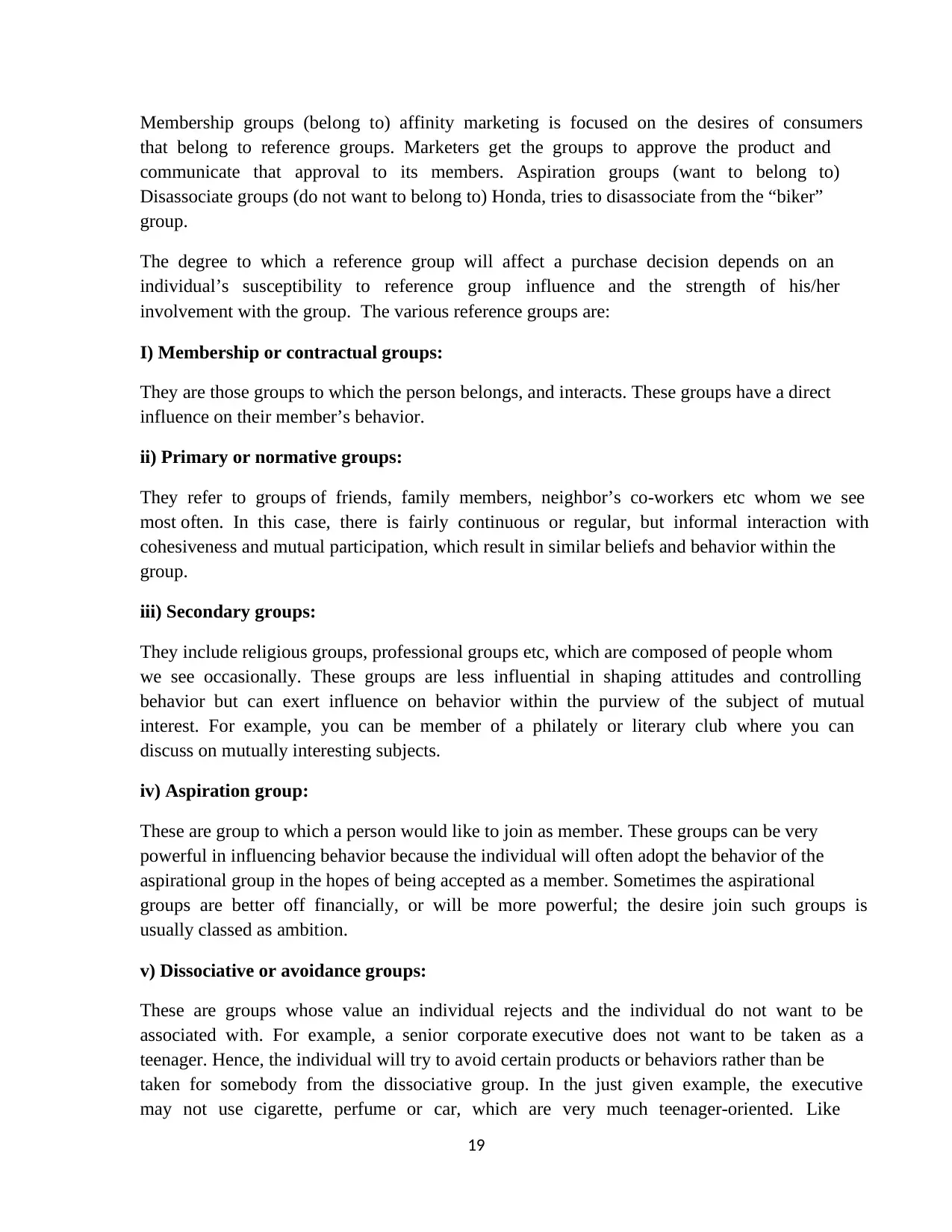
19
Membership groups (belong to) affinity marketing is focused on the desires of consumers
that belong to reference groups. Marketers get the groups to approve the product and
communicate that approval to its members. Aspiration groups (want to belong to)
Disassociate groups (do not want to belong to) Honda, tries to disassociate from the “biker”
group.
The degree to which a reference group will affect a purchase decision depends on an
individual’s susceptibility to reference group influence and the strength of his/her
involvement with the group. The various reference groups are:
I) Membership or contractual groups:
They are those groups to which the person belongs, and interacts. These groups have a direct
influence on their member’s behavior.
ii) Primary or normative groups:
They refer to groups of friends, family members, neighbor’s co-workers etc whom we see
most often. In this case, there is fairly continuous or regular, but informal interaction with
cohesiveness and mutual participation, which result in similar beliefs and behavior within the
group.
iii) Secondary groups:
They include religious groups, professional groups etc, which are composed of people whom
we see occasionally. These groups are less influential in shaping attitudes and controlling
behavior but can exert influence on behavior within the purview of the subject of mutual
interest. For example, you can be member of a philately or literary club where you can
discuss on mutually interesting subjects.
iv) Aspiration group:
These are group to which a person would like to join as member. These groups can be very
powerful in influencing behavior because the individual will often adopt the behavior of the
aspirational group in the hopes of being accepted as a member. Sometimes the aspirational
groups are better off financially, or will be more powerful; the desire join such groups is
usually classed as ambition.
v) Dissociative or avoidance groups:
These are groups whose value an individual rejects and the individual do not want to be
associated with. For example, a senior corporate executive does not want to be taken as a
teenager. Hence, the individual will try to avoid certain products or behaviors rather than be
taken for somebody from the dissociative group. In the just given example, the executive
may not use cigarette, perfume or car, which are very much teenager-oriented. Like
Membership groups (belong to) affinity marketing is focused on the desires of consumers
that belong to reference groups. Marketers get the groups to approve the product and
communicate that approval to its members. Aspiration groups (want to belong to)
Disassociate groups (do not want to belong to) Honda, tries to disassociate from the “biker”
group.
The degree to which a reference group will affect a purchase decision depends on an
individual’s susceptibility to reference group influence and the strength of his/her
involvement with the group. The various reference groups are:
I) Membership or contractual groups:
They are those groups to which the person belongs, and interacts. These groups have a direct
influence on their member’s behavior.
ii) Primary or normative groups:
They refer to groups of friends, family members, neighbor’s co-workers etc whom we see
most often. In this case, there is fairly continuous or regular, but informal interaction with
cohesiveness and mutual participation, which result in similar beliefs and behavior within the
group.
iii) Secondary groups:
They include religious groups, professional groups etc, which are composed of people whom
we see occasionally. These groups are less influential in shaping attitudes and controlling
behavior but can exert influence on behavior within the purview of the subject of mutual
interest. For example, you can be member of a philately or literary club where you can
discuss on mutually interesting subjects.
iv) Aspiration group:
These are group to which a person would like to join as member. These groups can be very
powerful in influencing behavior because the individual will often adopt the behavior of the
aspirational group in the hopes of being accepted as a member. Sometimes the aspirational
groups are better off financially, or will be more powerful; the desire join such groups is
usually classed as ambition.
v) Dissociative or avoidance groups:
These are groups whose value an individual rejects and the individual do not want to be
associated with. For example, a senior corporate executive does not want to be taken as a
teenager. Hence, the individual will try to avoid certain products or behaviors rather than be
taken for somebody from the dissociative group. In the just given example, the executive
may not use cigarette, perfume or car, which are very much teenager-oriented. Like
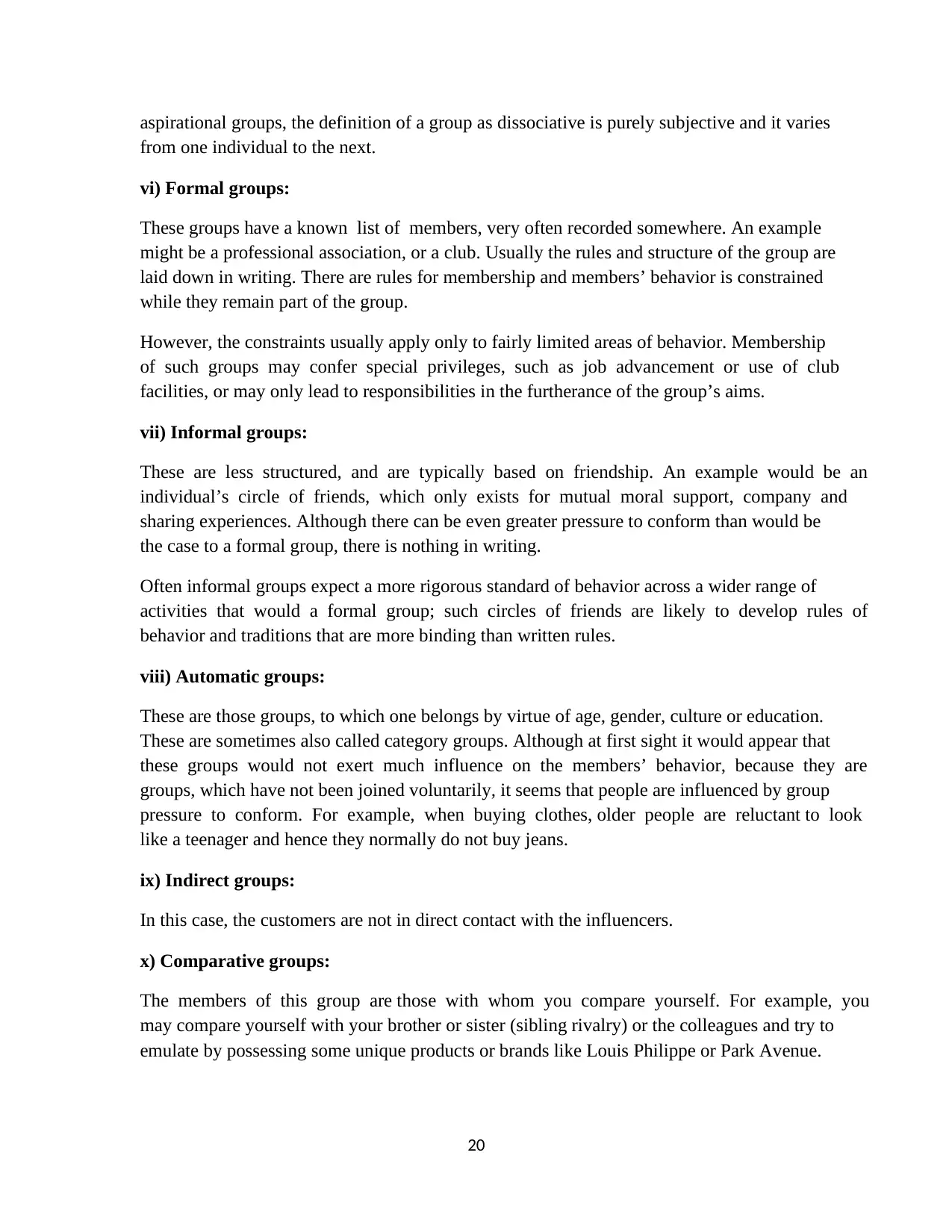
20
aspirational groups, the definition of a group as dissociative is purely subjective and it varies
from one individual to the next.
vi) Formal groups:
These groups have a known list of members, very often recorded somewhere. An example
might be a professional association, or a club. Usually the rules and structure of the group are
laid down in writing. There are rules for membership and members’ behavior is constrained
while they remain part of the group.
However, the constraints usually apply only to fairly limited areas of behavior. Membership
of such groups may confer special privileges, such as job advancement or use of club
facilities, or may only lead to responsibilities in the furtherance of the group’s aims.
vii) Informal groups:
These are less structured, and are typically based on friendship. An example would be an
individual’s circle of friends, which only exists for mutual moral support, company and
sharing experiences. Although there can be even greater pressure to conform than would be
the case to a formal group, there is nothing in writing.
Often informal groups expect a more rigorous standard of behavior across a wider range of
activities that would a formal group; such circles of friends are likely to develop rules of
behavior and traditions that are more binding than written rules.
viii) Automatic groups:
These are those groups, to which one belongs by virtue of age, gender, culture or education.
These are sometimes also called category groups. Although at first sight it would appear that
these groups would not exert much influence on the members’ behavior, because they are
groups, which have not been joined voluntarily, it seems that people are influenced by group
pressure to conform. For example, when buying clothes, older people are reluctant to look
like a teenager and hence they normally do not buy jeans.
ix) Indirect groups:
In this case, the customers are not in direct contact with the influencers.
x) Comparative groups:
The members of this group are those with whom you compare yourself. For example, you
may compare yourself with your brother or sister (sibling rivalry) or the colleagues and try to
emulate by possessing some unique products or brands like Louis Philippe or Park Avenue.
aspirational groups, the definition of a group as dissociative is purely subjective and it varies
from one individual to the next.
vi) Formal groups:
These groups have a known list of members, very often recorded somewhere. An example
might be a professional association, or a club. Usually the rules and structure of the group are
laid down in writing. There are rules for membership and members’ behavior is constrained
while they remain part of the group.
However, the constraints usually apply only to fairly limited areas of behavior. Membership
of such groups may confer special privileges, such as job advancement or use of club
facilities, or may only lead to responsibilities in the furtherance of the group’s aims.
vii) Informal groups:
These are less structured, and are typically based on friendship. An example would be an
individual’s circle of friends, which only exists for mutual moral support, company and
sharing experiences. Although there can be even greater pressure to conform than would be
the case to a formal group, there is nothing in writing.
Often informal groups expect a more rigorous standard of behavior across a wider range of
activities that would a formal group; such circles of friends are likely to develop rules of
behavior and traditions that are more binding than written rules.
viii) Automatic groups:
These are those groups, to which one belongs by virtue of age, gender, culture or education.
These are sometimes also called category groups. Although at first sight it would appear that
these groups would not exert much influence on the members’ behavior, because they are
groups, which have not been joined voluntarily, it seems that people are influenced by group
pressure to conform. For example, when buying clothes, older people are reluctant to look
like a teenager and hence they normally do not buy jeans.
ix) Indirect groups:
In this case, the customers are not in direct contact with the influencers.
x) Comparative groups:
The members of this group are those with whom you compare yourself. For example, you
may compare yourself with your brother or sister (sibling rivalry) or the colleagues and try to
emulate by possessing some unique products or brands like Louis Philippe or Park Avenue.
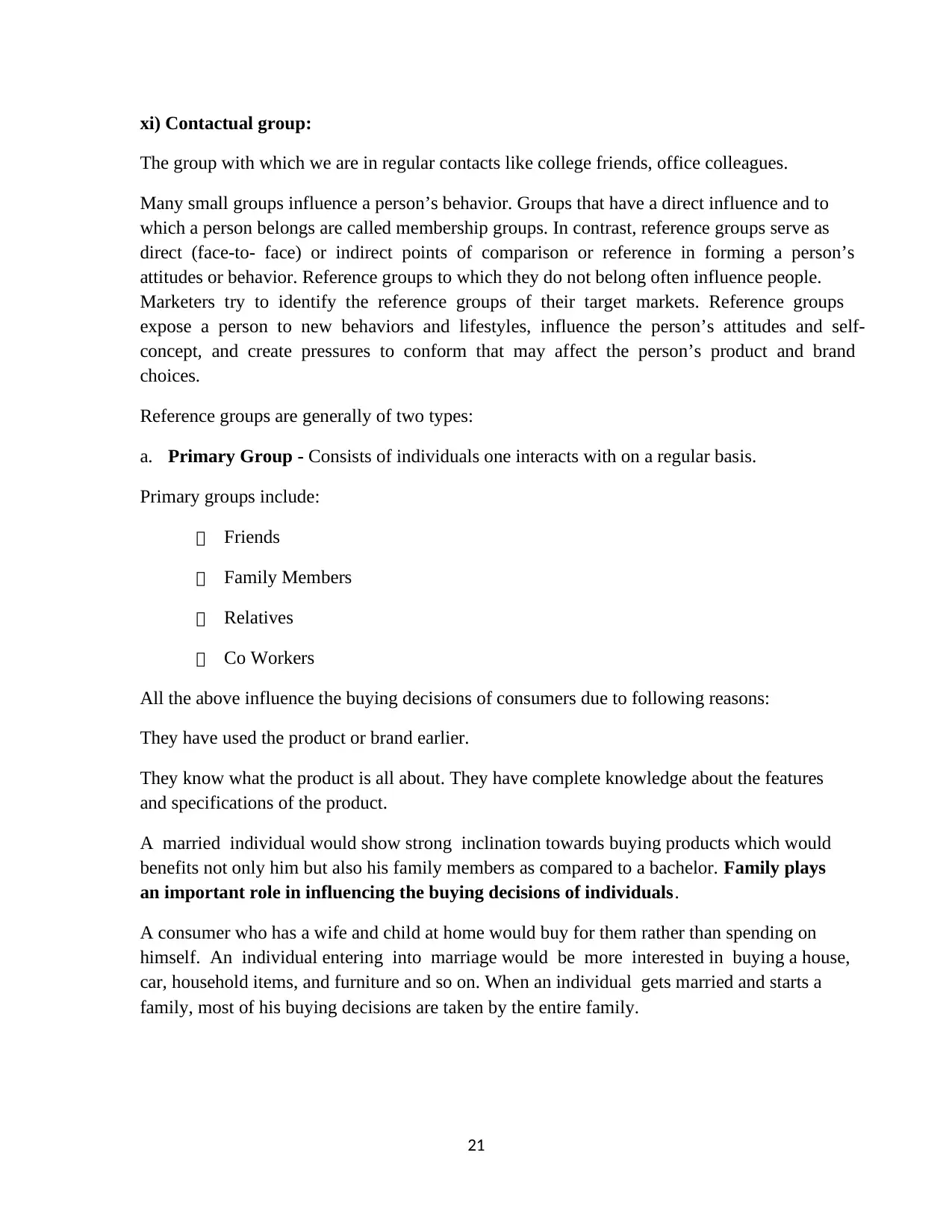
21
xi) Contactual group:
The group with which we are in regular contacts like college friends, office colleagues.
Many small groups influence a person’s behavior. Groups that have a direct influence and to
which a person belongs are called membership groups. In contrast, reference groups serve as
direct (face-to- face) or indirect points of comparison or reference in forming a person’s
attitudes or behavior. Reference groups to which they do not belong often influence people.
Marketers try to identify the reference groups of their target markets. Reference groups
expose a person to new behaviors and lifestyles, influence the person’s attitudes and self-
concept, and create pressures to conform that may affect the person’s product and brand
choices.
Reference groups are generally of two types:
a. Primary Group - Consists of individuals one interacts with on a regular basis.
Primary groups include:
Friends
Family Members
Relatives
Co Workers
All the above influence the buying decisions of consumers due to following reasons:
They have used the product or brand earlier.
They know what the product is all about. They have complete knowledge about the features
and specifications of the product.
A married individual would show strong inclination towards buying products which would
benefits not only him but also his family members as compared to a bachelor. Family plays
an important role in influencing the buying decisions of individuals.
A consumer who has a wife and child at home would buy for them rather than spending on
himself. An individual entering into marriage would be more interested in buying a house,
car, household items, and furniture and so on. When an individual gets married and starts a
family, most of his buying decisions are taken by the entire family.
xi) Contactual group:
The group with which we are in regular contacts like college friends, office colleagues.
Many small groups influence a person’s behavior. Groups that have a direct influence and to
which a person belongs are called membership groups. In contrast, reference groups serve as
direct (face-to- face) or indirect points of comparison or reference in forming a person’s
attitudes or behavior. Reference groups to which they do not belong often influence people.
Marketers try to identify the reference groups of their target markets. Reference groups
expose a person to new behaviors and lifestyles, influence the person’s attitudes and self-
concept, and create pressures to conform that may affect the person’s product and brand
choices.
Reference groups are generally of two types:
a. Primary Group - Consists of individuals one interacts with on a regular basis.
Primary groups include:
Friends
Family Members
Relatives
Co Workers
All the above influence the buying decisions of consumers due to following reasons:
They have used the product or brand earlier.
They know what the product is all about. They have complete knowledge about the features
and specifications of the product.
A married individual would show strong inclination towards buying products which would
benefits not only him but also his family members as compared to a bachelor. Family plays
an important role in influencing the buying decisions of individuals.
A consumer who has a wife and child at home would buy for them rather than spending on
himself. An individual entering into marriage would be more interested in buying a house,
car, household items, and furniture and so on. When an individual gets married and starts a
family, most of his buying decisions are taken by the entire family.
Secure Best Marks with AI Grader
Need help grading? Try our AI Grader for instant feedback on your assignments.
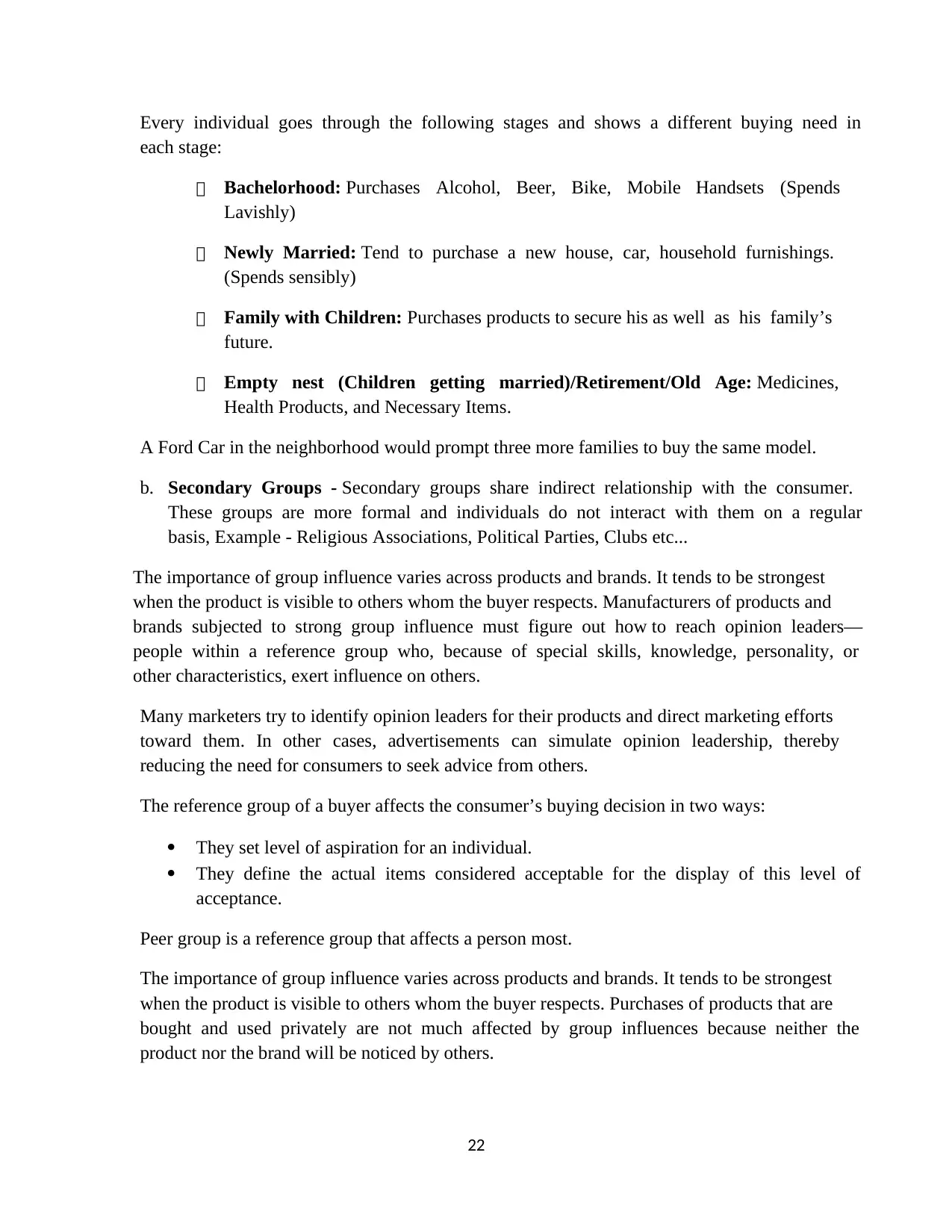
22
Every individual goes through the following stages and shows a different buying need in
each stage:
Bachelorhood: Purchases Alcohol, Beer, Bike, Mobile Handsets (Spends
Lavishly)
Newly Married: Tend to purchase a new house, car, household furnishings.
(Spends sensibly)
Family with Children: Purchases products to secure his as well as his family’s
future.
Empty nest (Children getting married)/Retirement/Old Age: Medicines,
Health Products, and Necessary Items.
A Ford Car in the neighborhood would prompt three more families to buy the same model.
b. Secondary Groups - Secondary groups share indirect relationship with the consumer.
These groups are more formal and individuals do not interact with them on a regular
basis, Example - Religious Associations, Political Parties, Clubs etc...
The importance of group influence varies across products and brands. It tends to be strongest
when the product is visible to others whom the buyer respects. Manufacturers of products and
brands subjected to strong group influence must figure out how to reach opinion leaders—
people within a reference group who, because of special skills, knowledge, personality, or
other characteristics, exert influence on others.
Many marketers try to identify opinion leaders for their products and direct marketing efforts
toward them. In other cases, advertisements can simulate opinion leadership, thereby
reducing the need for consumers to seek advice from others.
The reference group of a buyer affects the consumer’s buying decision in two ways:
They set level of aspiration for an individual.
They define the actual items considered acceptable for the display of this level of
acceptance.
Peer group is a reference group that affects a person most.
The importance of group influence varies across products and brands. It tends to be strongest
when the product is visible to others whom the buyer respects. Purchases of products that are
bought and used privately are not much affected by group influences because neither the
product nor the brand will be noticed by others.
Every individual goes through the following stages and shows a different buying need in
each stage:
Bachelorhood: Purchases Alcohol, Beer, Bike, Mobile Handsets (Spends
Lavishly)
Newly Married: Tend to purchase a new house, car, household furnishings.
(Spends sensibly)
Family with Children: Purchases products to secure his as well as his family’s
future.
Empty nest (Children getting married)/Retirement/Old Age: Medicines,
Health Products, and Necessary Items.
A Ford Car in the neighborhood would prompt three more families to buy the same model.
b. Secondary Groups - Secondary groups share indirect relationship with the consumer.
These groups are more formal and individuals do not interact with them on a regular
basis, Example - Religious Associations, Political Parties, Clubs etc...
The importance of group influence varies across products and brands. It tends to be strongest
when the product is visible to others whom the buyer respects. Manufacturers of products and
brands subjected to strong group influence must figure out how to reach opinion leaders—
people within a reference group who, because of special skills, knowledge, personality, or
other characteristics, exert influence on others.
Many marketers try to identify opinion leaders for their products and direct marketing efforts
toward them. In other cases, advertisements can simulate opinion leadership, thereby
reducing the need for consumers to seek advice from others.
The reference group of a buyer affects the consumer’s buying decision in two ways:
They set level of aspiration for an individual.
They define the actual items considered acceptable for the display of this level of
acceptance.
Peer group is a reference group that affects a person most.
The importance of group influence varies across products and brands. It tends to be strongest
when the product is visible to others whom the buyer respects. Purchases of products that are
bought and used privately are not much affected by group influences because neither the
product nor the brand will be noticed by others.

23
C. Roles and Status:
A person belongs to many groups—family, clubs, organizations. The person’s position in each
group can be defined in terms of both role and status. A role consists of the activities people are
expected to perform according to the persons around them. A person performs certain roles in a
particular group such as family, club, organization, and so on. For instance, a person may
perform the role of senior executive in a firm and another person may perform the role of a
junior executive. The senior executive may enjoy higher status in the organization, as compared
to junior executive. An individual from an upper middle class would spend on luxurious items
whereas an individual from middle to lower income group would buy items required for his/her
survival.
People may purchase the products that conform to their roles and status, especially in the case
of branded clothes, luxury watches, luxury cars, and so on.
A person is influenced by the role that he holds in the society. If a person is in a high
position, his buying behavior will be influenced largely by his status. A person who is a
Chief Executive Officer in a company will buy according to his status while a staff or an
employee of the same company will have different buying pattern.
Purchases of products that are bought and used privately are not much affected by group
influences because neither the product nor the brand will be noticed by others. Family
members can strongly influence buyer behavior. The family is found to be the most
important buying organization in society, and it has been researched extensively. Marketers
are interested in the roles and influence of the husband, wife, and children on the purchase of
different products and services.
Social class determines to some extent, the types, quality, and quantity of products that a
person buys or uses. Lower class people tend to stay close to home when shopping and they
do not engage in much pre-purchase information gathering. Stores project definite class
images. Family, reference groups and social classes are all social influences on consumer
behavior. All operate within a larger culture.
3. Cultural Factors:
A group of people are associated with a set of values and ideologies that belong to a
particular community. When a person comes from a particular community, his/her behavior
is highly influenced by the culture relating to that particular community. Cultural factors
comprise of set of values and ideologies of a particular community or group of individuals. It
is the culture of an individual which decides the way he/she behaves. In simpler words,
culture is nothing but values of an individual. What an individual learns from his parents and
relatives as a child becomes his culture.
C. Roles and Status:
A person belongs to many groups—family, clubs, organizations. The person’s position in each
group can be defined in terms of both role and status. A role consists of the activities people are
expected to perform according to the persons around them. A person performs certain roles in a
particular group such as family, club, organization, and so on. For instance, a person may
perform the role of senior executive in a firm and another person may perform the role of a
junior executive. The senior executive may enjoy higher status in the organization, as compared
to junior executive. An individual from an upper middle class would spend on luxurious items
whereas an individual from middle to lower income group would buy items required for his/her
survival.
People may purchase the products that conform to their roles and status, especially in the case
of branded clothes, luxury watches, luxury cars, and so on.
A person is influenced by the role that he holds in the society. If a person is in a high
position, his buying behavior will be influenced largely by his status. A person who is a
Chief Executive Officer in a company will buy according to his status while a staff or an
employee of the same company will have different buying pattern.
Purchases of products that are bought and used privately are not much affected by group
influences because neither the product nor the brand will be noticed by others. Family
members can strongly influence buyer behavior. The family is found to be the most
important buying organization in society, and it has been researched extensively. Marketers
are interested in the roles and influence of the husband, wife, and children on the purchase of
different products and services.
Social class determines to some extent, the types, quality, and quantity of products that a
person buys or uses. Lower class people tend to stay close to home when shopping and they
do not engage in much pre-purchase information gathering. Stores project definite class
images. Family, reference groups and social classes are all social influences on consumer
behavior. All operate within a larger culture.
3. Cultural Factors:
A group of people are associated with a set of values and ideologies that belong to a
particular community. When a person comes from a particular community, his/her behavior
is highly influenced by the culture relating to that particular community. Cultural factors
comprise of set of values and ideologies of a particular community or group of individuals. It
is the culture of an individual which decides the way he/she behaves. In simpler words,
culture is nothing but values of an individual. What an individual learns from his parents and
relatives as a child becomes his culture.
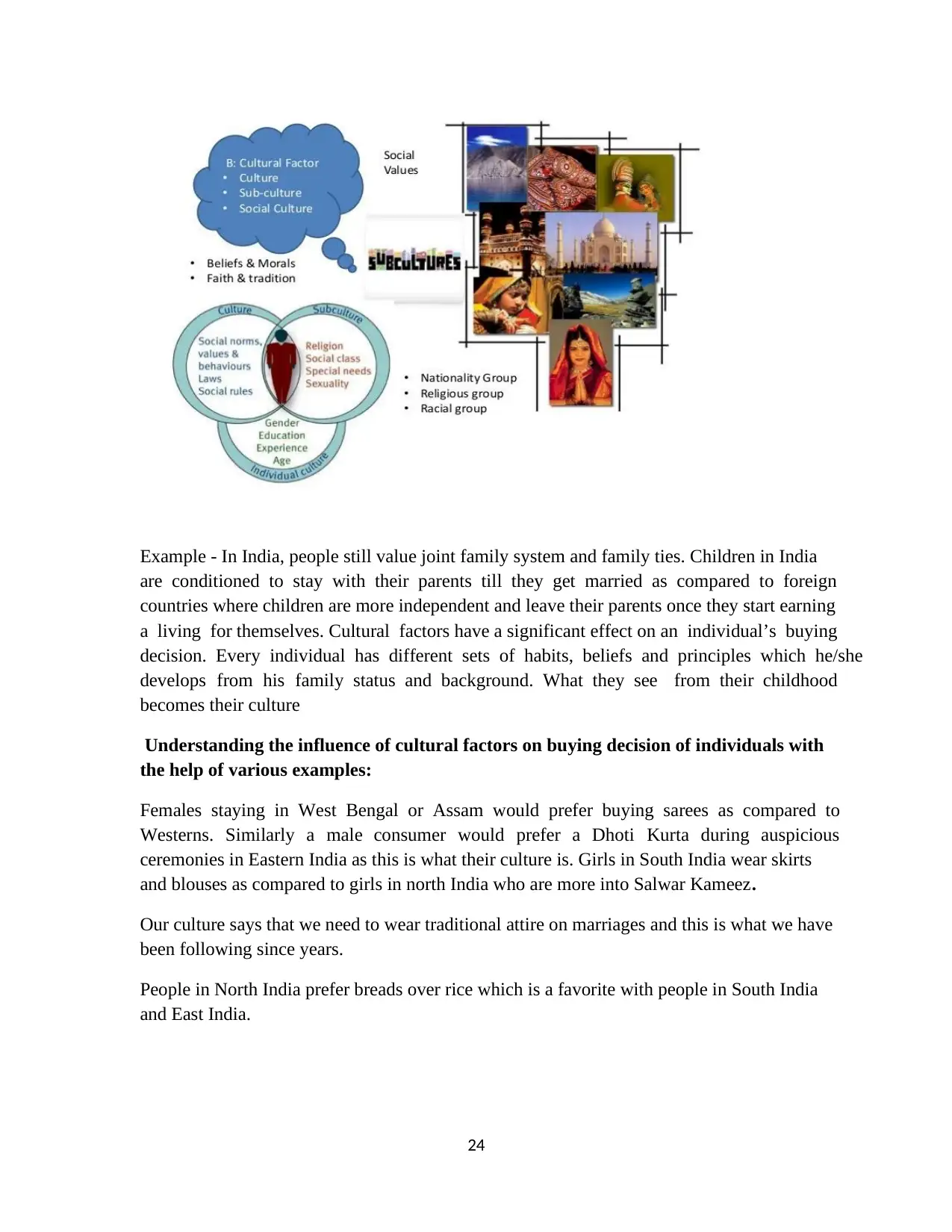
24
Example - In India, people still value joint family system and family ties. Children in India
are conditioned to stay with their parents till they get married as compared to foreign
countries where children are more independent and leave their parents once they start earning
a living for themselves. Cultural factors have a significant effect on an individual’s buying
decision. Every individual has different sets of habits, beliefs and principles which he/she
develops from his family status and background. What they see from their childhood
becomes their culture
Understanding the influence of cultural factors on buying decision of individuals with
the help of various examples:
Females staying in West Bengal or Assam would prefer buying sarees as compared to
Westerns. Similarly a male consumer would prefer a Dhoti Kurta during auspicious
ceremonies in Eastern India as this is what their culture is. Girls in South India wear skirts
and blouses as compared to girls in north India who are more into Salwar Kameez.
Our culture says that we need to wear traditional attire on marriages and this is what we have
been following since years.
People in North India prefer breads over rice which is a favorite with people in South India
and East India.
Example - In India, people still value joint family system and family ties. Children in India
are conditioned to stay with their parents till they get married as compared to foreign
countries where children are more independent and leave their parents once they start earning
a living for themselves. Cultural factors have a significant effect on an individual’s buying
decision. Every individual has different sets of habits, beliefs and principles which he/she
develops from his family status and background. What they see from their childhood
becomes their culture
Understanding the influence of cultural factors on buying decision of individuals with
the help of various examples:
Females staying in West Bengal or Assam would prefer buying sarees as compared to
Westerns. Similarly a male consumer would prefer a Dhoti Kurta during auspicious
ceremonies in Eastern India as this is what their culture is. Girls in South India wear skirts
and blouses as compared to girls in north India who are more into Salwar Kameez.
Our culture says that we need to wear traditional attire on marriages and this is what we have
been following since years.
People in North India prefer breads over rice which is a favorite with people in South India
and East India.
Paraphrase This Document
Need a fresh take? Get an instant paraphrase of this document with our AI Paraphraser
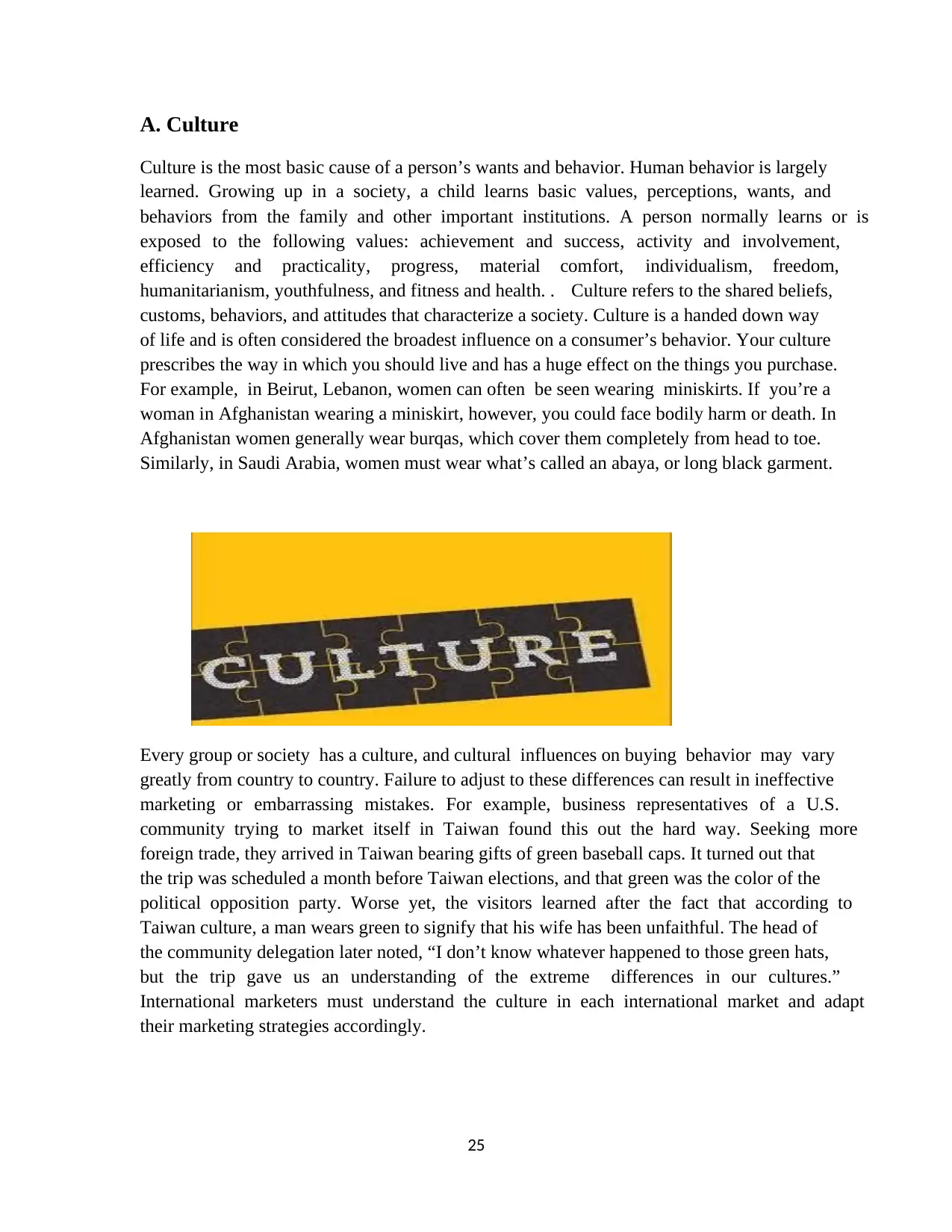
25
A. Culture
Culture is the most basic cause of a person’s wants and behavior. Human behavior is largely
learned. Growing up in a society, a child learns basic values, perceptions, wants, and
behaviors from the family and other important institutions. A person normally learns or is
exposed to the following values: achievement and success, activity and involvement,
efficiency and practicality, progress, material comfort, individualism, freedom,
humanitarianism, youthfulness, and fitness and health. . Culture refers to the shared beliefs,
customs, behaviors, and attitudes that characterize a society. Culture is a handed down way
of life and is often considered the broadest influence on a consumer’s behavior. Your culture
prescribes the way in which you should live and has a huge effect on the things you purchase.
For example, in Beirut, Lebanon, women can often be seen wearing miniskirts. If you’re a
woman in Afghanistan wearing a miniskirt, however, you could face bodily harm or death. In
Afghanistan women generally wear burqas, which cover them completely from head to toe.
Similarly, in Saudi Arabia, women must wear what’s called an abaya, or long black garment.
Every group or society has a culture, and cultural influences on buying behavior may vary
greatly from country to country. Failure to adjust to these differences can result in ineffective
marketing or embarrassing mistakes. For example, business representatives of a U.S.
community trying to market itself in Taiwan found this out the hard way. Seeking more
foreign trade, they arrived in Taiwan bearing gifts of green baseball caps. It turned out that
the trip was scheduled a month before Taiwan elections, and that green was the color of the
political opposition party. Worse yet, the visitors learned after the fact that according to
Taiwan culture, a man wears green to signify that his wife has been unfaithful. The head of
the community delegation later noted, “I don’t know whatever happened to those green hats,
but the trip gave us an understanding of the extreme differences in our cultures.”
International marketers must understand the culture in each international market and adapt
their marketing strategies accordingly.
A. Culture
Culture is the most basic cause of a person’s wants and behavior. Human behavior is largely
learned. Growing up in a society, a child learns basic values, perceptions, wants, and
behaviors from the family and other important institutions. A person normally learns or is
exposed to the following values: achievement and success, activity and involvement,
efficiency and practicality, progress, material comfort, individualism, freedom,
humanitarianism, youthfulness, and fitness and health. . Culture refers to the shared beliefs,
customs, behaviors, and attitudes that characterize a society. Culture is a handed down way
of life and is often considered the broadest influence on a consumer’s behavior. Your culture
prescribes the way in which you should live and has a huge effect on the things you purchase.
For example, in Beirut, Lebanon, women can often be seen wearing miniskirts. If you’re a
woman in Afghanistan wearing a miniskirt, however, you could face bodily harm or death. In
Afghanistan women generally wear burqas, which cover them completely from head to toe.
Similarly, in Saudi Arabia, women must wear what’s called an abaya, or long black garment.
Every group or society has a culture, and cultural influences on buying behavior may vary
greatly from country to country. Failure to adjust to these differences can result in ineffective
marketing or embarrassing mistakes. For example, business representatives of a U.S.
community trying to market itself in Taiwan found this out the hard way. Seeking more
foreign trade, they arrived in Taiwan bearing gifts of green baseball caps. It turned out that
the trip was scheduled a month before Taiwan elections, and that green was the color of the
political opposition party. Worse yet, the visitors learned after the fact that according to
Taiwan culture, a man wears green to signify that his wife has been unfaithful. The head of
the community delegation later noted, “I don’t know whatever happened to those green hats,
but the trip gave us an understanding of the extreme differences in our cultures.”
International marketers must understand the culture in each international market and adapt
their marketing strategies accordingly.

26
The Indian Culture as It Stands Today:
The Indian society is known to follow conformity to traditions, spiritualism, respect for
elders, education etc., but following change has been experienced in the recent past –
I. Women have joined work force in a big way.
ii. This has led to increased use of luxury and time saving gadgets etc.
iii. Health and fitness consciousness has been observed, which has led to large number of
gym and fitness chains.
iv. There has been a shift from spiritualism to materialism and back to spiritualism and yoga.
v. There are more nuclear families than joint families.
B. Subcultures
Each culture contains smaller subcultures or groups of people with shared value systems
based on common life experiences and situations. Subcultures include nationalities, religions,
racial groups, and geographic regions. Many subcultures make up important market
segments, and marketers often design products and marketing programs tailored to their
needs. Here are examples of four such important subculture groups. Within a cultural group,
there exist many subcultures. These sub-cultural groups share the same set of beliefs and
values. Subcultures can consist of people from different religion, caste, geographies and
nationalities. These subcultures by itself form a customer segment. Each culture further
comprises of various subcultures such as religion, age, geographical location, gender
(male/female), status etc. we will look at gender, age, and stage of life and how they
influence purchase decisions. Men and women need and buy different products. They also
shop differently and in general, have different attitudes about shopping. You know the old
stereotypes. Men see what they want and buy it, but women “try on everything and shop ‘til
they drop.” There’s some truth to the stereotypes. That’s why you see so many
advertisements directed at one sex or the other—beer commercials that air on ESPN and
commercials for household products that air on Lifetime. Women influence fully two-thirds
of all household product purchases, whereas men buy about three-quarters of all alcoholic
beverages. The shopping differences between men and women seem to be changing, though.
Younger, well-educated men are less likely to believe grocery shopping is a woman’s job and
would be more inclined to bargain shop and use coupons if the coupons were properly
targeted at them. A subculture is a group of people within a culture who are different from
the dominant culture but have something in common with one another such as common
interests, vocations or jobs, religions, ethnic backgrounds, and geographic locations.
The Indian Culture as It Stands Today:
The Indian society is known to follow conformity to traditions, spiritualism, respect for
elders, education etc., but following change has been experienced in the recent past –
I. Women have joined work force in a big way.
ii. This has led to increased use of luxury and time saving gadgets etc.
iii. Health and fitness consciousness has been observed, which has led to large number of
gym and fitness chains.
iv. There has been a shift from spiritualism to materialism and back to spiritualism and yoga.
v. There are more nuclear families than joint families.
B. Subcultures
Each culture contains smaller subcultures or groups of people with shared value systems
based on common life experiences and situations. Subcultures include nationalities, religions,
racial groups, and geographic regions. Many subcultures make up important market
segments, and marketers often design products and marketing programs tailored to their
needs. Here are examples of four such important subculture groups. Within a cultural group,
there exist many subcultures. These sub-cultural groups share the same set of beliefs and
values. Subcultures can consist of people from different religion, caste, geographies and
nationalities. These subcultures by itself form a customer segment. Each culture further
comprises of various subcultures such as religion, age, geographical location, gender
(male/female), status etc. we will look at gender, age, and stage of life and how they
influence purchase decisions. Men and women need and buy different products. They also
shop differently and in general, have different attitudes about shopping. You know the old
stereotypes. Men see what they want and buy it, but women “try on everything and shop ‘til
they drop.” There’s some truth to the stereotypes. That’s why you see so many
advertisements directed at one sex or the other—beer commercials that air on ESPN and
commercials for household products that air on Lifetime. Women influence fully two-thirds
of all household product purchases, whereas men buy about three-quarters of all alcoholic
beverages. The shopping differences between men and women seem to be changing, though.
Younger, well-educated men are less likely to believe grocery shopping is a woman’s job and
would be more inclined to bargain shop and use coupons if the coupons were properly
targeted at them. A subculture is a group of people within a culture who are different from
the dominant culture but have something in common with one another such as common
interests, vocations or jobs, religions, ethnic backgrounds, and geographic locations.
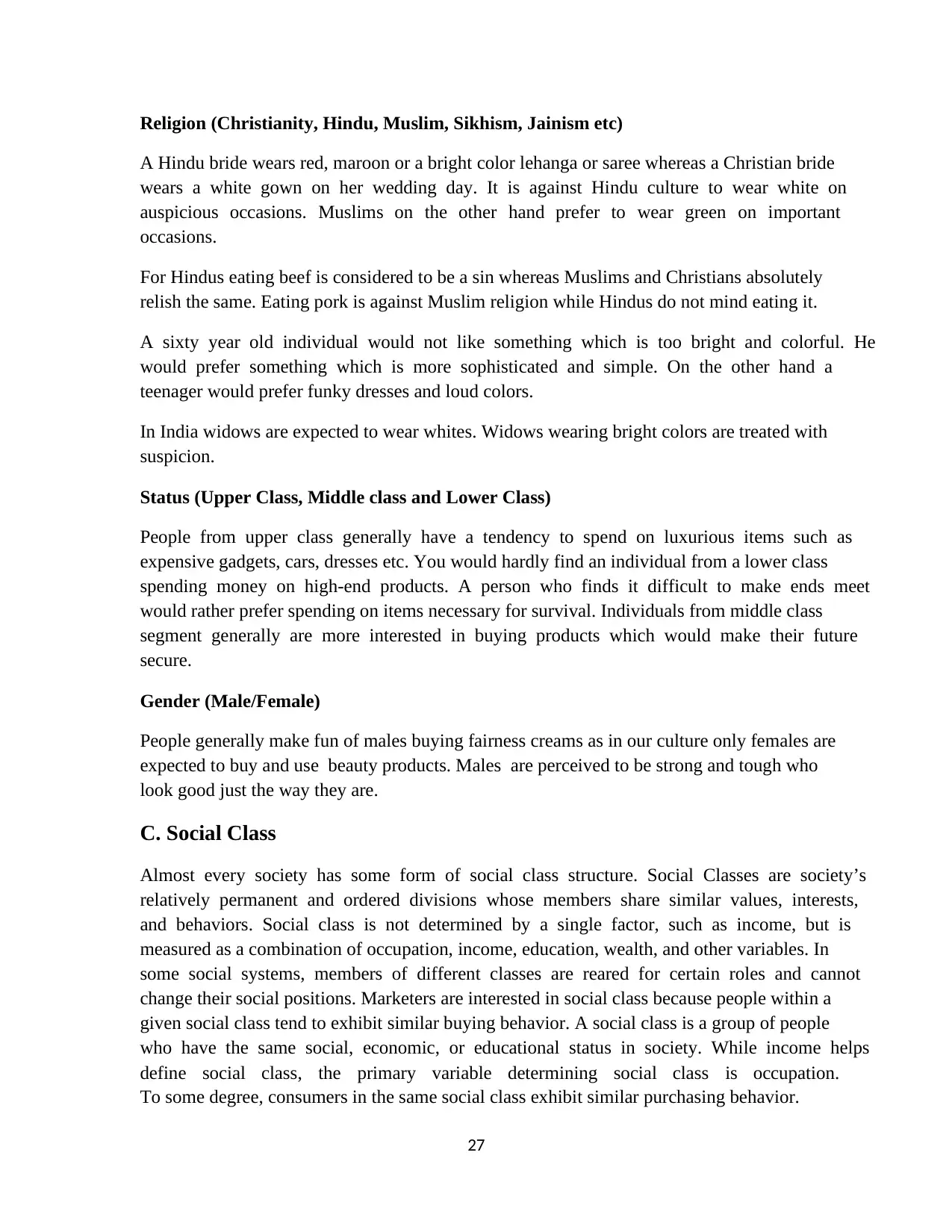
27
Religion (Christianity, Hindu, Muslim, Sikhism, Jainism etc)
A Hindu bride wears red, maroon or a bright color lehanga or saree whereas a Christian bride
wears a white gown on her wedding day. It is against Hindu culture to wear white on
auspicious occasions. Muslims on the other hand prefer to wear green on important
occasions.
For Hindus eating beef is considered to be a sin whereas Muslims and Christians absolutely
relish the same. Eating pork is against Muslim religion while Hindus do not mind eating it.
A sixty year old individual would not like something which is too bright and colorful. He
would prefer something which is more sophisticated and simple. On the other hand a
teenager would prefer funky dresses and loud colors.
In India widows are expected to wear whites. Widows wearing bright colors are treated with
suspicion.
Status (Upper Class, Middle class and Lower Class)
People from upper class generally have a tendency to spend on luxurious items such as
expensive gadgets, cars, dresses etc. You would hardly find an individual from a lower class
spending money on high-end products. A person who finds it difficult to make ends meet
would rather prefer spending on items necessary for survival. Individuals from middle class
segment generally are more interested in buying products which would make their future
secure.
Gender (Male/Female)
People generally make fun of males buying fairness creams as in our culture only females are
expected to buy and use beauty products. Males are perceived to be strong and tough who
look good just the way they are.
C. Social Class
Almost every society has some form of social class structure. Social Classes are society’s
relatively permanent and ordered divisions whose members share similar values, interests,
and behaviors. Social class is not determined by a single factor, such as income, but is
measured as a combination of occupation, income, education, wealth, and other variables. In
some social systems, members of different classes are reared for certain roles and cannot
change their social positions. Marketers are interested in social class because people within a
given social class tend to exhibit similar buying behavior. A social class is a group of people
who have the same social, economic, or educational status in society. While income helps
define social class, the primary variable determining social class is occupation.
To some degree, consumers in the same social class exhibit similar purchasing behavior.
Religion (Christianity, Hindu, Muslim, Sikhism, Jainism etc)
A Hindu bride wears red, maroon or a bright color lehanga or saree whereas a Christian bride
wears a white gown on her wedding day. It is against Hindu culture to wear white on
auspicious occasions. Muslims on the other hand prefer to wear green on important
occasions.
For Hindus eating beef is considered to be a sin whereas Muslims and Christians absolutely
relish the same. Eating pork is against Muslim religion while Hindus do not mind eating it.
A sixty year old individual would not like something which is too bright and colorful. He
would prefer something which is more sophisticated and simple. On the other hand a
teenager would prefer funky dresses and loud colors.
In India widows are expected to wear whites. Widows wearing bright colors are treated with
suspicion.
Status (Upper Class, Middle class and Lower Class)
People from upper class generally have a tendency to spend on luxurious items such as
expensive gadgets, cars, dresses etc. You would hardly find an individual from a lower class
spending money on high-end products. A person who finds it difficult to make ends meet
would rather prefer spending on items necessary for survival. Individuals from middle class
segment generally are more interested in buying products which would make their future
secure.
Gender (Male/Female)
People generally make fun of males buying fairness creams as in our culture only females are
expected to buy and use beauty products. Males are perceived to be strong and tough who
look good just the way they are.
C. Social Class
Almost every society has some form of social class structure. Social Classes are society’s
relatively permanent and ordered divisions whose members share similar values, interests,
and behaviors. Social class is not determined by a single factor, such as income, but is
measured as a combination of occupation, income, education, wealth, and other variables. In
some social systems, members of different classes are reared for certain roles and cannot
change their social positions. Marketers are interested in social class because people within a
given social class tend to exhibit similar buying behavior. A social class is a group of people
who have the same social, economic, or educational status in society. While income helps
define social class, the primary variable determining social class is occupation.
To some degree, consumers in the same social class exhibit similar purchasing behavior.
Secure Best Marks with AI Grader
Need help grading? Try our AI Grader for instant feedback on your assignments.
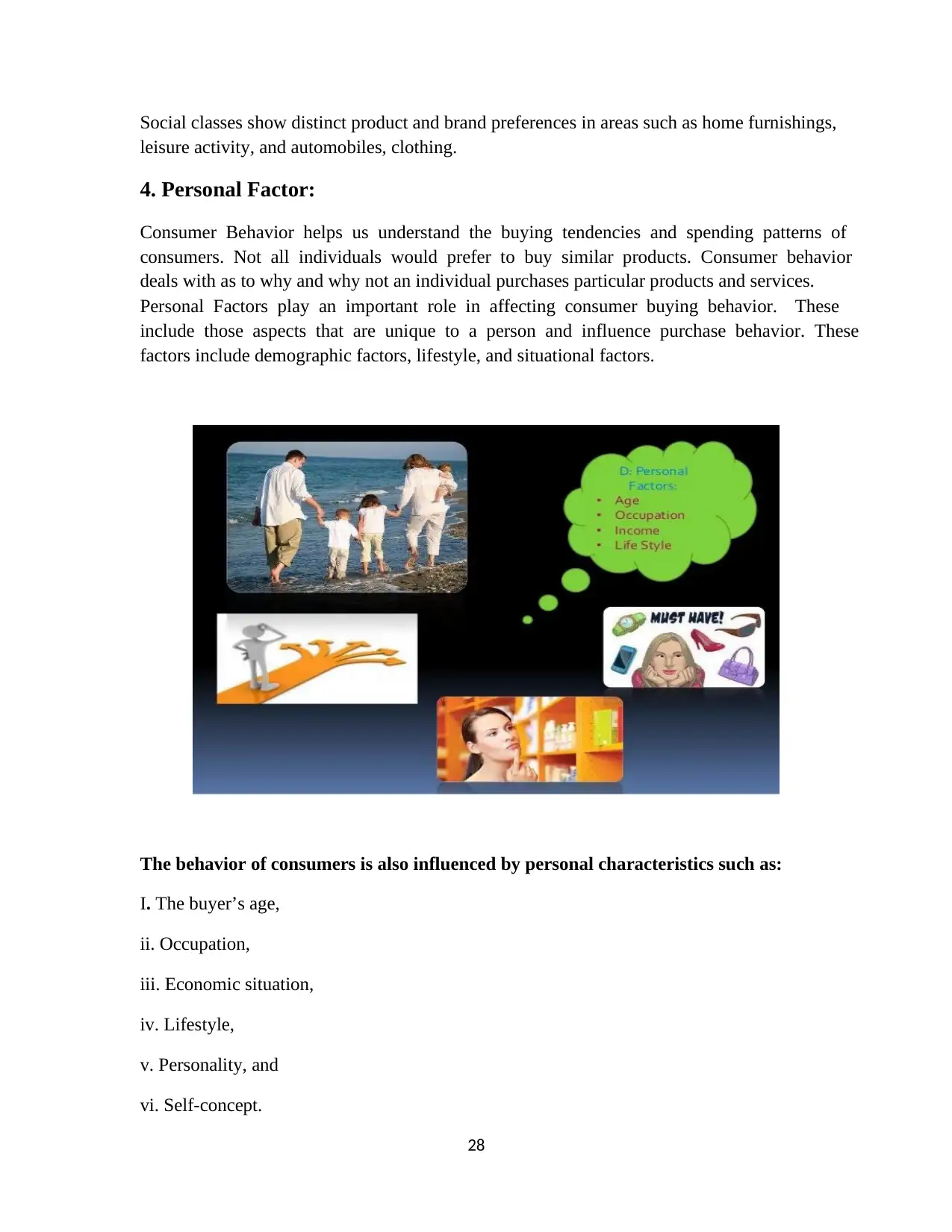
28
Social classes show distinct product and brand preferences in areas such as home furnishings,
leisure activity, and automobiles, clothing.
4. Personal Factor:
Consumer Behavior helps us understand the buying tendencies and spending patterns of
consumers. Not all individuals would prefer to buy similar products. Consumer behavior
deals with as to why and why not an individual purchases particular products and services.
Personal Factors play an important role in affecting consumer buying behavior. These
include those aspects that are unique to a person and influence purchase behavior. These
factors include demographic factors, lifestyle, and situational factors.
The behavior of consumers is also influenced by personal characteristics such as:
I. The buyer’s age,
ii. Occupation,
iii. Economic situation,
iv. Lifestyle,
v. Personality, and
vi. Self-concept.
Social classes show distinct product and brand preferences in areas such as home furnishings,
leisure activity, and automobiles, clothing.
4. Personal Factor:
Consumer Behavior helps us understand the buying tendencies and spending patterns of
consumers. Not all individuals would prefer to buy similar products. Consumer behavior
deals with as to why and why not an individual purchases particular products and services.
Personal Factors play an important role in affecting consumer buying behavior. These
include those aspects that are unique to a person and influence purchase behavior. These
factors include demographic factors, lifestyle, and situational factors.
The behavior of consumers is also influenced by personal characteristics such as:
I. The buyer’s age,
ii. Occupation,
iii. Economic situation,
iv. Lifestyle,
v. Personality, and
vi. Self-concept.
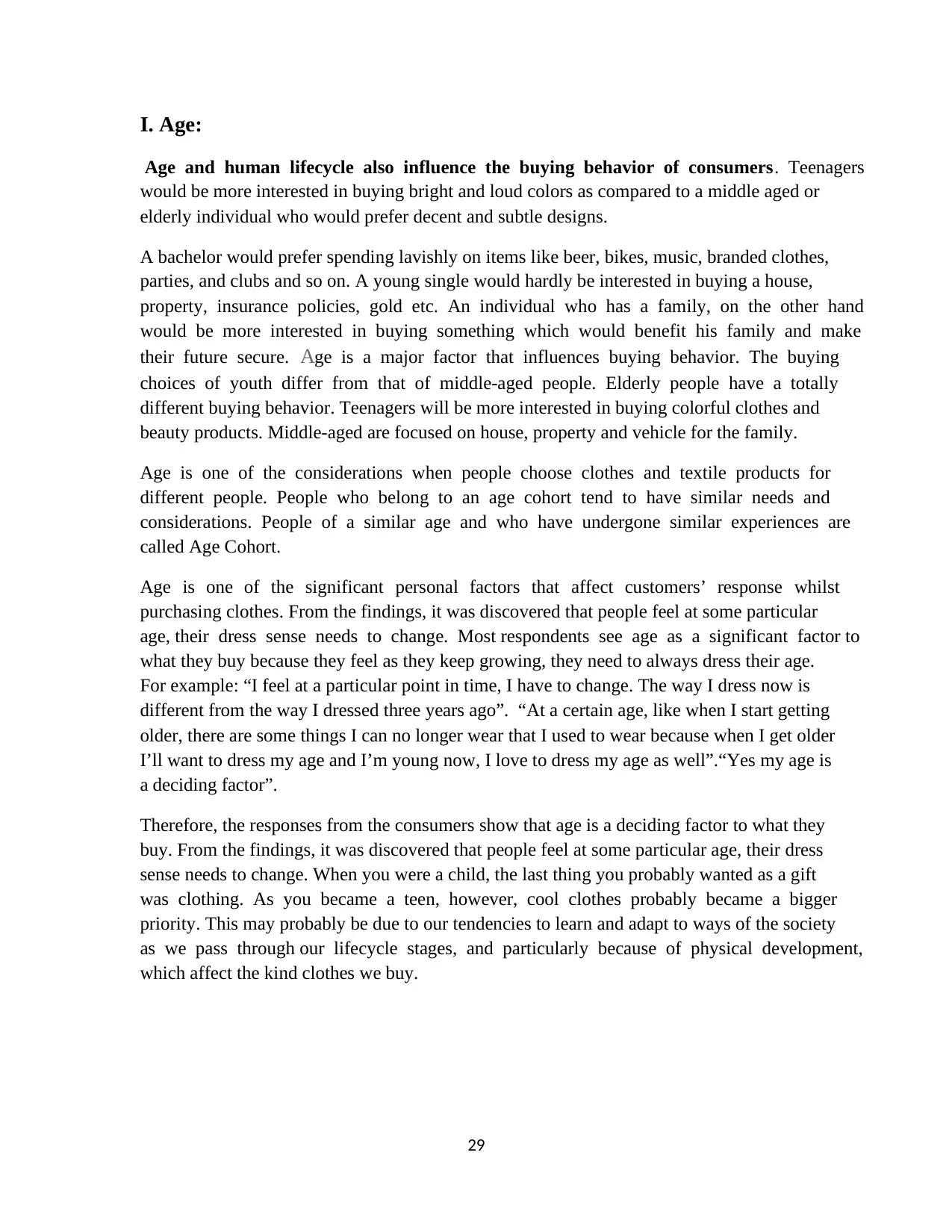
29
I. Age:
Age and human lifecycle also influence the buying behavior of consumers. Teenagers
would be more interested in buying bright and loud colors as compared to a middle aged or
elderly individual who would prefer decent and subtle designs.
A bachelor would prefer spending lavishly on items like beer, bikes, music, branded clothes,
parties, and clubs and so on. A young single would hardly be interested in buying a house,
property, insurance policies, gold etc. An individual who has a family, on the other hand
would be more interested in buying something which would benefit his family and make
their future secure. Age is a major factor that influences buying behavior. The buying
choices of youth differ from that of middle-aged people. Elderly people have a totally
different buying behavior. Teenagers will be more interested in buying colorful clothes and
beauty products. Middle-aged are focused on house, property and vehicle for the family.
Age is one of the considerations when people choose clothes and textile products for
different people. People who belong to an age cohort tend to have similar needs and
considerations. People of a similar age and who have undergone similar experiences are
called Age Cohort.
Age is one of the significant personal factors that affect customers’ response whilst
purchasing clothes. From the findings, it was discovered that people feel at some particular
age, their dress sense needs to change. Most respondents see age as a significant factor to
what they buy because they feel as they keep growing, they need to always dress their age.
For example: “I feel at a particular point in time, I have to change. The way I dress now is
different from the way I dressed three years ago”. “At a certain age, like when I start getting
older, there are some things I can no longer wear that I used to wear because when I get older
I’ll want to dress my age and I’m young now, I love to dress my age as well”.“Yes my age is
a deciding factor”.
Therefore, the responses from the consumers show that age is a deciding factor to what they
buy. From the findings, it was discovered that people feel at some particular age, their dress
sense needs to change. When you were a child, the last thing you probably wanted as a gift
was clothing. As you became a teen, however, cool clothes probably became a bigger
priority. This may probably be due to our tendencies to learn and adapt to ways of the society
as we pass through our lifecycle stages, and particularly because of physical development,
which affect the kind clothes we buy.
I. Age:
Age and human lifecycle also influence the buying behavior of consumers. Teenagers
would be more interested in buying bright and loud colors as compared to a middle aged or
elderly individual who would prefer decent and subtle designs.
A bachelor would prefer spending lavishly on items like beer, bikes, music, branded clothes,
parties, and clubs and so on. A young single would hardly be interested in buying a house,
property, insurance policies, gold etc. An individual who has a family, on the other hand
would be more interested in buying something which would benefit his family and make
their future secure. Age is a major factor that influences buying behavior. The buying
choices of youth differ from that of middle-aged people. Elderly people have a totally
different buying behavior. Teenagers will be more interested in buying colorful clothes and
beauty products. Middle-aged are focused on house, property and vehicle for the family.
Age is one of the considerations when people choose clothes and textile products for
different people. People who belong to an age cohort tend to have similar needs and
considerations. People of a similar age and who have undergone similar experiences are
called Age Cohort.
Age is one of the significant personal factors that affect customers’ response whilst
purchasing clothes. From the findings, it was discovered that people feel at some particular
age, their dress sense needs to change. Most respondents see age as a significant factor to
what they buy because they feel as they keep growing, they need to always dress their age.
For example: “I feel at a particular point in time, I have to change. The way I dress now is
different from the way I dressed three years ago”. “At a certain age, like when I start getting
older, there are some things I can no longer wear that I used to wear because when I get older
I’ll want to dress my age and I’m young now, I love to dress my age as well”.“Yes my age is
a deciding factor”.
Therefore, the responses from the consumers show that age is a deciding factor to what they
buy. From the findings, it was discovered that people feel at some particular age, their dress
sense needs to change. When you were a child, the last thing you probably wanted as a gift
was clothing. As you became a teen, however, cool clothes probably became a bigger
priority. This may probably be due to our tendencies to learn and adapt to ways of the society
as we pass through our lifecycle stages, and particularly because of physical development,
which affect the kind clothes we buy.
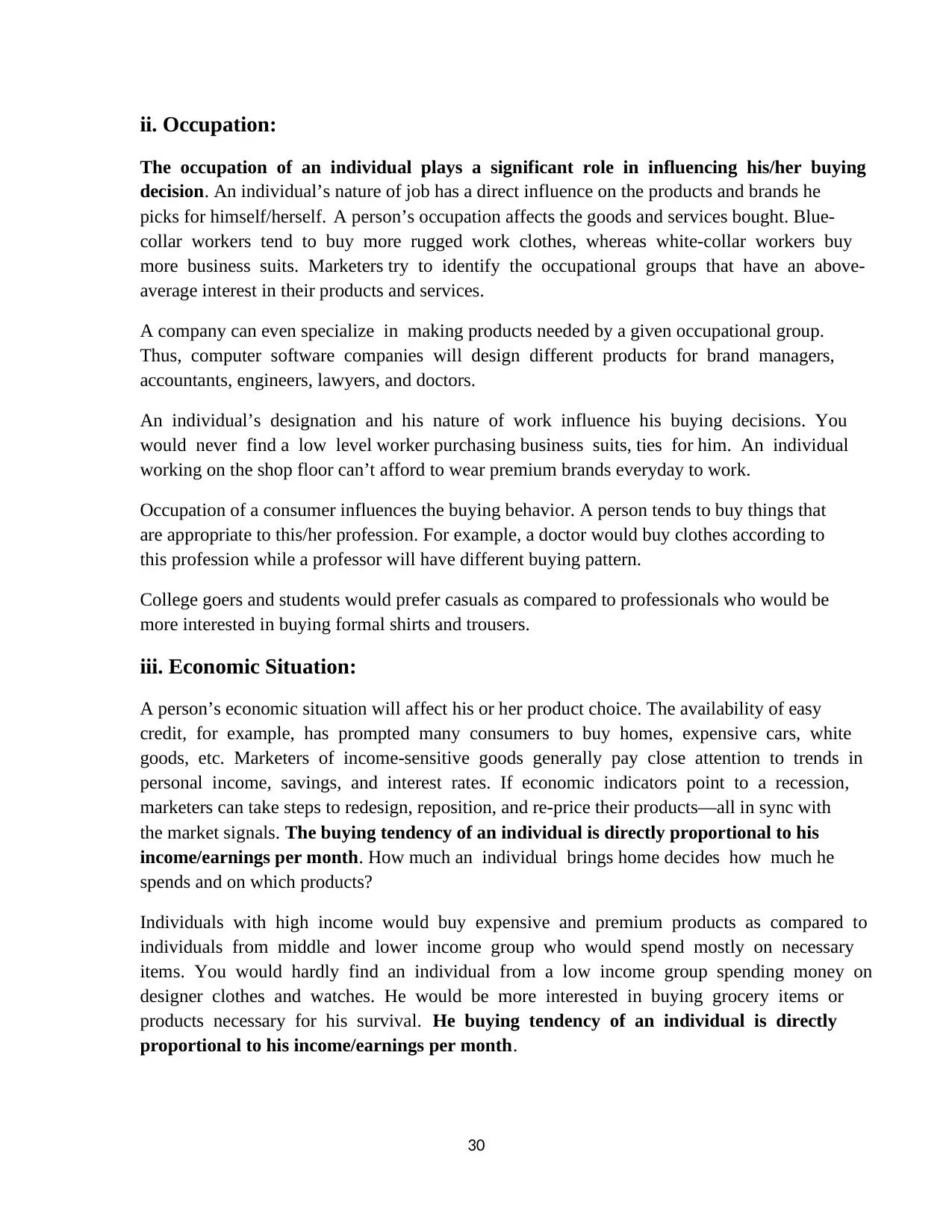
30
ii. Occupation:
The occupation of an individual plays a significant role in influencing his/her buying
decision. An individual’s nature of job has a direct influence on the products and brands he
picks for himself/herself. A person’s occupation affects the goods and services bought. Blue-
collar workers tend to buy more rugged work clothes, whereas white-collar workers buy
more business suits. Marketers try to identify the occupational groups that have an above-
average interest in their products and services.
A company can even specialize in making products needed by a given occupational group.
Thus, computer software companies will design different products for brand managers,
accountants, engineers, lawyers, and doctors.
An individual’s designation and his nature of work influence his buying decisions. You
would never find a low level worker purchasing business suits, ties for him. An individual
working on the shop floor can’t afford to wear premium brands everyday to work.
Occupation of a consumer influences the buying behavior. A person tends to buy things that
are appropriate to this/her profession. For example, a doctor would buy clothes according to
this profession while a professor will have different buying pattern.
College goers and students would prefer casuals as compared to professionals who would be
more interested in buying formal shirts and trousers.
iii. Economic Situation:
A person’s economic situation will affect his or her product choice. The availability of easy
credit, for example, has prompted many consumers to buy homes, expensive cars, white
goods, etc. Marketers of income-sensitive goods generally pay close attention to trends in
personal income, savings, and interest rates. If economic indicators point to a recession,
marketers can take steps to redesign, reposition, and re-price their products—all in sync with
the market signals. The buying tendency of an individual is directly proportional to his
income/earnings per month. How much an individual brings home decides how much he
spends and on which products?
Individuals with high income would buy expensive and premium products as compared to
individuals from middle and lower income group who would spend mostly on necessary
items. You would hardly find an individual from a low income group spending money on
designer clothes and watches. He would be more interested in buying grocery items or
products necessary for his survival. He buying tendency of an individual is directly
proportional to his income/earnings per month.
ii. Occupation:
The occupation of an individual plays a significant role in influencing his/her buying
decision. An individual’s nature of job has a direct influence on the products and brands he
picks for himself/herself. A person’s occupation affects the goods and services bought. Blue-
collar workers tend to buy more rugged work clothes, whereas white-collar workers buy
more business suits. Marketers try to identify the occupational groups that have an above-
average interest in their products and services.
A company can even specialize in making products needed by a given occupational group.
Thus, computer software companies will design different products for brand managers,
accountants, engineers, lawyers, and doctors.
An individual’s designation and his nature of work influence his buying decisions. You
would never find a low level worker purchasing business suits, ties for him. An individual
working on the shop floor can’t afford to wear premium brands everyday to work.
Occupation of a consumer influences the buying behavior. A person tends to buy things that
are appropriate to this/her profession. For example, a doctor would buy clothes according to
this profession while a professor will have different buying pattern.
College goers and students would prefer casuals as compared to professionals who would be
more interested in buying formal shirts and trousers.
iii. Economic Situation:
A person’s economic situation will affect his or her product choice. The availability of easy
credit, for example, has prompted many consumers to buy homes, expensive cars, white
goods, etc. Marketers of income-sensitive goods generally pay close attention to trends in
personal income, savings, and interest rates. If economic indicators point to a recession,
marketers can take steps to redesign, reposition, and re-price their products—all in sync with
the market signals. The buying tendency of an individual is directly proportional to his
income/earnings per month. How much an individual brings home decides how much he
spends and on which products?
Individuals with high income would buy expensive and premium products as compared to
individuals from middle and lower income group who would spend mostly on necessary
items. You would hardly find an individual from a low income group spending money on
designer clothes and watches. He would be more interested in buying grocery items or
products necessary for his survival. He buying tendency of an individual is directly
proportional to his income/earnings per month.
Paraphrase This Document
Need a fresh take? Get an instant paraphrase of this document with our AI Paraphraser
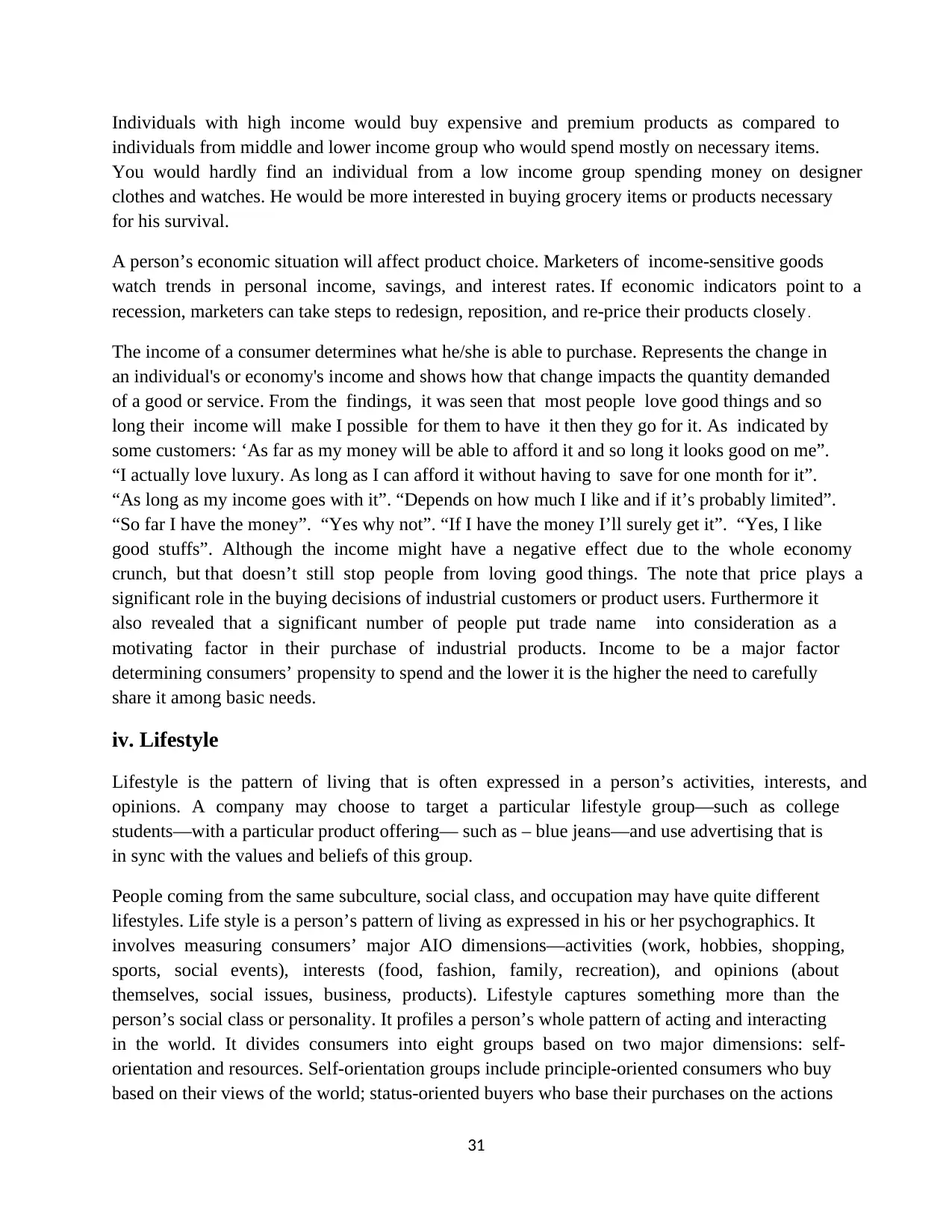
31
Individuals with high income would buy expensive and premium products as compared to
individuals from middle and lower income group who would spend mostly on necessary items.
You would hardly find an individual from a low income group spending money on designer
clothes and watches. He would be more interested in buying grocery items or products necessary
for his survival.
A person’s economic situation will affect product choice. Marketers of income-sensitive goods
watch trends in personal income, savings, and interest rates. If economic indicators point to a
recession, marketers can take steps to redesign, reposition, and re-price their products closely.
The income of a consumer determines what he/she is able to purchase. Represents the change in
an individual's or economy's income and shows how that change impacts the quantity demanded
of a good or service. From the findings, it was seen that most people love good things and so
long their income will make I possible for them to have it then they go for it. As indicated by
some customers: ‘As far as my money will be able to afford it and so long it looks good on me”.
“I actually love luxury. As long as I can afford it without having to save for one month for it”.
“As long as my income goes with it”. “Depends on how much I like and if it’s probably limited”.
“So far I have the money”. “Yes why not”. “If I have the money I’ll surely get it”. “Yes, I like
good stuffs”. Although the income might have a negative effect due to the whole economy
crunch, but that doesn’t still stop people from loving good things. The note that price plays a
significant role in the buying decisions of industrial customers or product users. Furthermore it
also revealed that a significant number of people put trade name into consideration as a
motivating factor in their purchase of industrial products. Income to be a major factor
determining consumers’ propensity to spend and the lower it is the higher the need to carefully
share it among basic needs.
iv. Lifestyle
Lifestyle is the pattern of living that is often expressed in a person’s activities, interests, and
opinions. A company may choose to target a particular lifestyle group—such as college
students—with a particular product offering— such as – blue jeans—and use advertising that is
in sync with the values and beliefs of this group.
People coming from the same subculture, social class, and occupation may have quite different
lifestyles. Life style is a person’s pattern of living as expressed in his or her psychographics. It
involves measuring consumers’ major AIO dimensions—activities (work, hobbies, shopping,
sports, social events), interests (food, fashion, family, recreation), and opinions (about
themselves, social issues, business, products). Lifestyle captures something more than the
person’s social class or personality. It profiles a person’s whole pattern of acting and interacting
in the world. It divides consumers into eight groups based on two major dimensions: self-
orientation and resources. Self-orientation groups include principle-oriented consumers who buy
based on their views of the world; status-oriented buyers who base their purchases on the actions
Individuals with high income would buy expensive and premium products as compared to
individuals from middle and lower income group who would spend mostly on necessary items.
You would hardly find an individual from a low income group spending money on designer
clothes and watches. He would be more interested in buying grocery items or products necessary
for his survival.
A person’s economic situation will affect product choice. Marketers of income-sensitive goods
watch trends in personal income, savings, and interest rates. If economic indicators point to a
recession, marketers can take steps to redesign, reposition, and re-price their products closely.
The income of a consumer determines what he/she is able to purchase. Represents the change in
an individual's or economy's income and shows how that change impacts the quantity demanded
of a good or service. From the findings, it was seen that most people love good things and so
long their income will make I possible for them to have it then they go for it. As indicated by
some customers: ‘As far as my money will be able to afford it and so long it looks good on me”.
“I actually love luxury. As long as I can afford it without having to save for one month for it”.
“As long as my income goes with it”. “Depends on how much I like and if it’s probably limited”.
“So far I have the money”. “Yes why not”. “If I have the money I’ll surely get it”. “Yes, I like
good stuffs”. Although the income might have a negative effect due to the whole economy
crunch, but that doesn’t still stop people from loving good things. The note that price plays a
significant role in the buying decisions of industrial customers or product users. Furthermore it
also revealed that a significant number of people put trade name into consideration as a
motivating factor in their purchase of industrial products. Income to be a major factor
determining consumers’ propensity to spend and the lower it is the higher the need to carefully
share it among basic needs.
iv. Lifestyle
Lifestyle is the pattern of living that is often expressed in a person’s activities, interests, and
opinions. A company may choose to target a particular lifestyle group—such as college
students—with a particular product offering— such as – blue jeans—and use advertising that is
in sync with the values and beliefs of this group.
People coming from the same subculture, social class, and occupation may have quite different
lifestyles. Life style is a person’s pattern of living as expressed in his or her psychographics. It
involves measuring consumers’ major AIO dimensions—activities (work, hobbies, shopping,
sports, social events), interests (food, fashion, family, recreation), and opinions (about
themselves, social issues, business, products). Lifestyle captures something more than the
person’s social class or personality. It profiles a person’s whole pattern of acting and interacting
in the world. It divides consumers into eight groups based on two major dimensions: self-
orientation and resources. Self-orientation groups include principle-oriented consumers who buy
based on their views of the world; status-oriented buyers who base their purchases on the actions
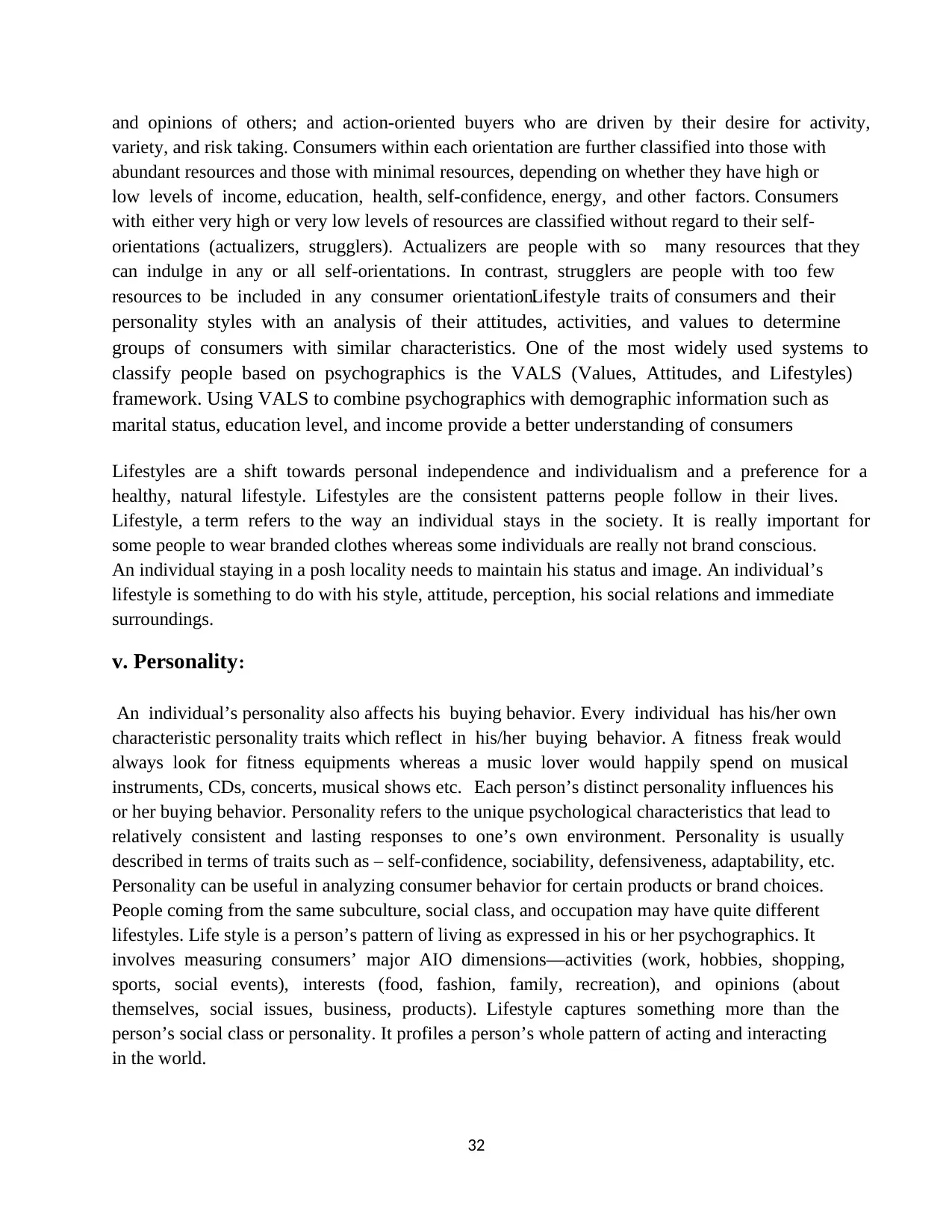
32
and opinions of others; and action-oriented buyers who are driven by their desire for activity,
variety, and risk taking. Consumers within each orientation are further classified into those with
abundant resources and those with minimal resources, depending on whether they have high or
low levels of income, education, health, self-confidence, energy, and other factors. Consumers
with either very high or very low levels of resources are classified without regard to their self-
orientations (actualizers, strugglers). Actualizers are people with so many resources that they
can indulge in any or all self-orientations. In contrast, strugglers are people with too few
resources to be included in any consumer orientation.Lifestyle traits of consumers and their
personality styles with an analysis of their attitudes, activities, and values to determine
groups of consumers with similar characteristics. One of the most widely used systems to
classify people based on psychographics is the VALS (Values, Attitudes, and Lifestyles)
framework. Using VALS to combine psychographics with demographic information such as
marital status, education level, and income provide a better understanding of consumers
Lifestyles are a shift towards personal independence and individualism and a preference for a
healthy, natural lifestyle. Lifestyles are the consistent patterns people follow in their lives.
Lifestyle, a term refers to the way an individual stays in the society. It is really important for
some people to wear branded clothes whereas some individuals are really not brand conscious.
An individual staying in a posh locality needs to maintain his status and image. An individual’s
lifestyle is something to do with his style, attitude, perception, his social relations and immediate
surroundings.
v. Personality:
An individual’s personality also affects his buying behavior. Every individual has his/her own
characteristic personality traits which reflect in his/her buying behavior. A fitness freak would
always look for fitness equipments whereas a music lover would happily spend on musical
instruments, CDs, concerts, musical shows etc. Each person’s distinct personality influences his
or her buying behavior. Personality refers to the unique psychological characteristics that lead to
relatively consistent and lasting responses to one’s own environment. Personality is usually
described in terms of traits such as – self-confidence, sociability, defensiveness, adaptability, etc.
Personality can be useful in analyzing consumer behavior for certain products or brand choices.
People coming from the same subculture, social class, and occupation may have quite different
lifestyles. Life style is a person’s pattern of living as expressed in his or her psychographics. It
involves measuring consumers’ major AIO dimensions—activities (work, hobbies, shopping,
sports, social events), interests (food, fashion, family, recreation), and opinions (about
themselves, social issues, business, products). Lifestyle captures something more than the
person’s social class or personality. It profiles a person’s whole pattern of acting and interacting
in the world.
and opinions of others; and action-oriented buyers who are driven by their desire for activity,
variety, and risk taking. Consumers within each orientation are further classified into those with
abundant resources and those with minimal resources, depending on whether they have high or
low levels of income, education, health, self-confidence, energy, and other factors. Consumers
with either very high or very low levels of resources are classified without regard to their self-
orientations (actualizers, strugglers). Actualizers are people with so many resources that they
can indulge in any or all self-orientations. In contrast, strugglers are people with too few
resources to be included in any consumer orientation.Lifestyle traits of consumers and their
personality styles with an analysis of their attitudes, activities, and values to determine
groups of consumers with similar characteristics. One of the most widely used systems to
classify people based on psychographics is the VALS (Values, Attitudes, and Lifestyles)
framework. Using VALS to combine psychographics with demographic information such as
marital status, education level, and income provide a better understanding of consumers
Lifestyles are a shift towards personal independence and individualism and a preference for a
healthy, natural lifestyle. Lifestyles are the consistent patterns people follow in their lives.
Lifestyle, a term refers to the way an individual stays in the society. It is really important for
some people to wear branded clothes whereas some individuals are really not brand conscious.
An individual staying in a posh locality needs to maintain his status and image. An individual’s
lifestyle is something to do with his style, attitude, perception, his social relations and immediate
surroundings.
v. Personality:
An individual’s personality also affects his buying behavior. Every individual has his/her own
characteristic personality traits which reflect in his/her buying behavior. A fitness freak would
always look for fitness equipments whereas a music lover would happily spend on musical
instruments, CDs, concerts, musical shows etc. Each person’s distinct personality influences his
or her buying behavior. Personality refers to the unique psychological characteristics that lead to
relatively consistent and lasting responses to one’s own environment. Personality is usually
described in terms of traits such as – self-confidence, sociability, defensiveness, adaptability, etc.
Personality can be useful in analyzing consumer behavior for certain products or brand choices.
People coming from the same subculture, social class, and occupation may have quite different
lifestyles. Life style is a person’s pattern of living as expressed in his or her psychographics. It
involves measuring consumers’ major AIO dimensions—activities (work, hobbies, shopping,
sports, social events), interests (food, fashion, family, recreation), and opinions (about
themselves, social issues, business, products). Lifestyle captures something more than the
person’s social class or personality. It profiles a person’s whole pattern of acting and interacting
in the world.
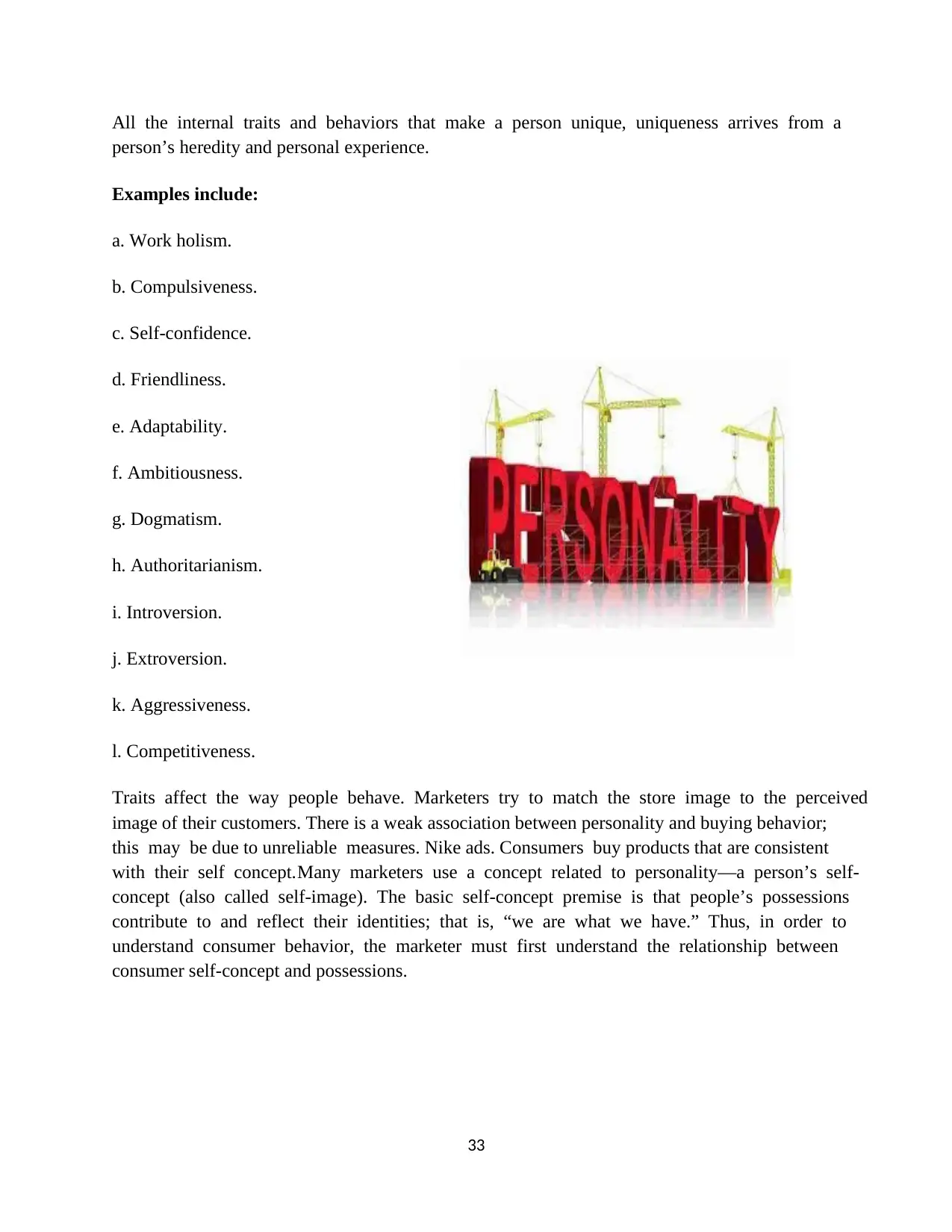
33
All the internal traits and behaviors that make a person unique, uniqueness arrives from a
person’s heredity and personal experience.
Examples include:
a. Work holism.
b. Compulsiveness.
c. Self-confidence.
d. Friendliness.
e. Adaptability.
f. Ambitiousness.
g. Dogmatism.
h. Authoritarianism.
i. Introversion.
j. Extroversion.
k. Aggressiveness.
l. Competitiveness.
Traits affect the way people behave. Marketers try to match the store image to the perceived
image of their customers. There is a weak association between personality and buying behavior;
this may be due to unreliable measures. Nike ads. Consumers buy products that are consistent
with their self concept. Many marketers use a concept related to personality—a person’s self-
concept (also called self-image). The basic self-concept premise is that people’s possessions
contribute to and reflect their identities; that is, “we are what we have.” Thus, in order to
understand consumer behavior, the marketer must first understand the relationship between
consumer self-concept and possessions.
All the internal traits and behaviors that make a person unique, uniqueness arrives from a
person’s heredity and personal experience.
Examples include:
a. Work holism.
b. Compulsiveness.
c. Self-confidence.
d. Friendliness.
e. Adaptability.
f. Ambitiousness.
g. Dogmatism.
h. Authoritarianism.
i. Introversion.
j. Extroversion.
k. Aggressiveness.
l. Competitiveness.
Traits affect the way people behave. Marketers try to match the store image to the perceived
image of their customers. There is a weak association between personality and buying behavior;
this may be due to unreliable measures. Nike ads. Consumers buy products that are consistent
with their self concept. Many marketers use a concept related to personality—a person’s self-
concept (also called self-image). The basic self-concept premise is that people’s possessions
contribute to and reflect their identities; that is, “we are what we have.” Thus, in order to
understand consumer behavior, the marketer must first understand the relationship between
consumer self-concept and possessions.
Secure Best Marks with AI Grader
Need help grading? Try our AI Grader for instant feedback on your assignments.
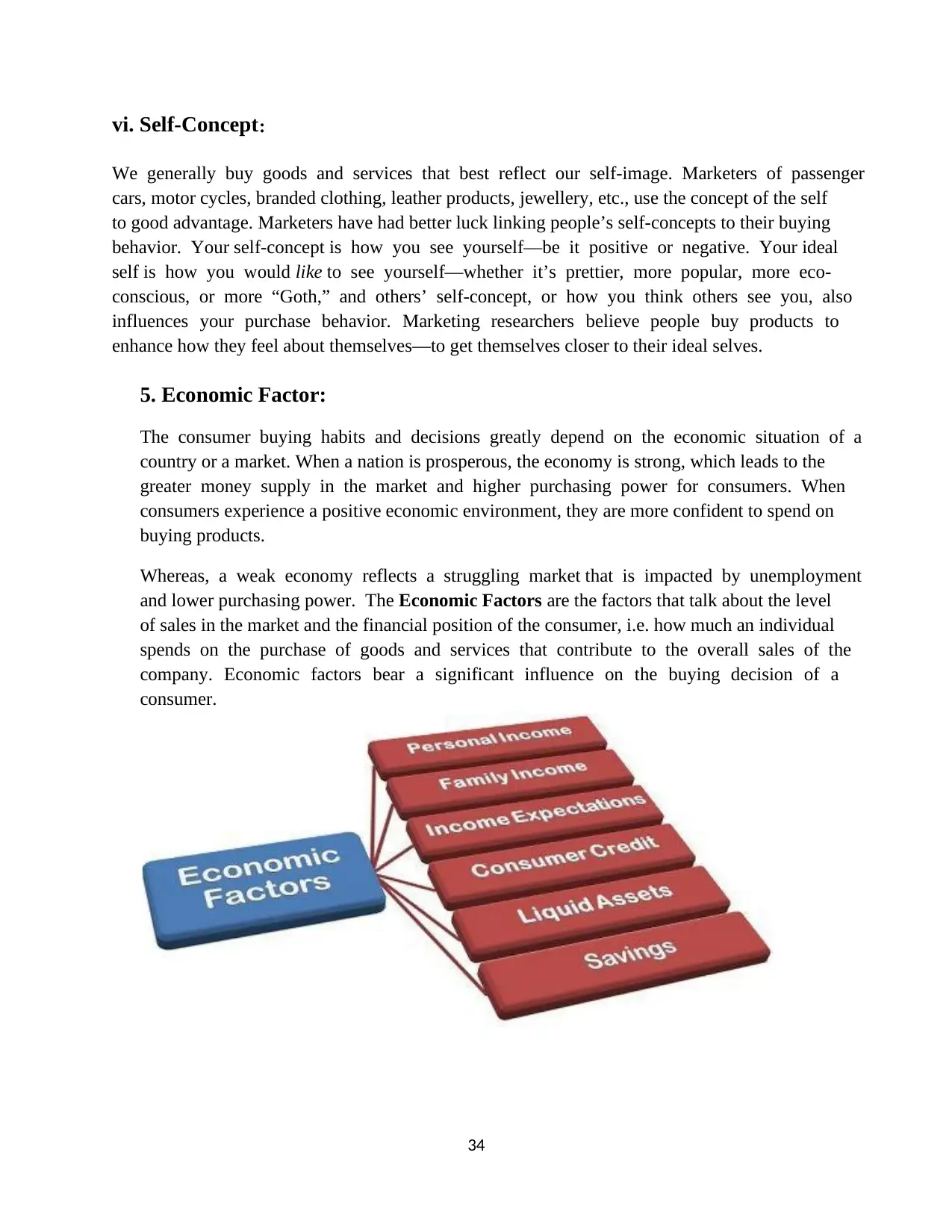
34
vi. Self-Concept:
We generally buy goods and services that best reflect our self-image. Marketers of passenger
cars, motor cycles, branded clothing, leather products, jewellery, etc., use the concept of the self
to good advantage. Marketers have had better luck linking people’s self-concepts to their buying
behavior. Your self-concept is how you see yourself—be it positive or negative. Your ideal
self is how you would like to see yourself—whether it’s prettier, more popular, more eco-
conscious, or more “Goth,” and others’ self-concept, or how you think others see you, also
influences your purchase behavior. Marketing researchers believe people buy products to
enhance how they feel about themselves—to get themselves closer to their ideal selves.
5. Economic Factor:
The consumer buying habits and decisions greatly depend on the economic situation of a
country or a market. When a nation is prosperous, the economy is strong, which leads to the
greater money supply in the market and higher purchasing power for consumers. When
consumers experience a positive economic environment, they are more confident to spend on
buying products.
Whereas, a weak economy reflects a struggling market that is impacted by unemployment
and lower purchasing power. The Economic Factors are the factors that talk about the level
of sales in the market and the financial position of the consumer, i.e. how much an individual
spends on the purchase of goods and services that contribute to the overall sales of the
company. Economic factors bear a significant influence on the buying decision of a
consumer.
vi. Self-Concept:
We generally buy goods and services that best reflect our self-image. Marketers of passenger
cars, motor cycles, branded clothing, leather products, jewellery, etc., use the concept of the self
to good advantage. Marketers have had better luck linking people’s self-concepts to their buying
behavior. Your self-concept is how you see yourself—be it positive or negative. Your ideal
self is how you would like to see yourself—whether it’s prettier, more popular, more eco-
conscious, or more “Goth,” and others’ self-concept, or how you think others see you, also
influences your purchase behavior. Marketing researchers believe people buy products to
enhance how they feel about themselves—to get themselves closer to their ideal selves.
5. Economic Factor:
The consumer buying habits and decisions greatly depend on the economic situation of a
country or a market. When a nation is prosperous, the economy is strong, which leads to the
greater money supply in the market and higher purchasing power for consumers. When
consumers experience a positive economic environment, they are more confident to spend on
buying products.
Whereas, a weak economy reflects a struggling market that is impacted by unemployment
and lower purchasing power. The Economic Factors are the factors that talk about the level
of sales in the market and the financial position of the consumer, i.e. how much an individual
spends on the purchase of goods and services that contribute to the overall sales of the
company. Economic factors bear a significant influence on the buying decision of a
consumer.
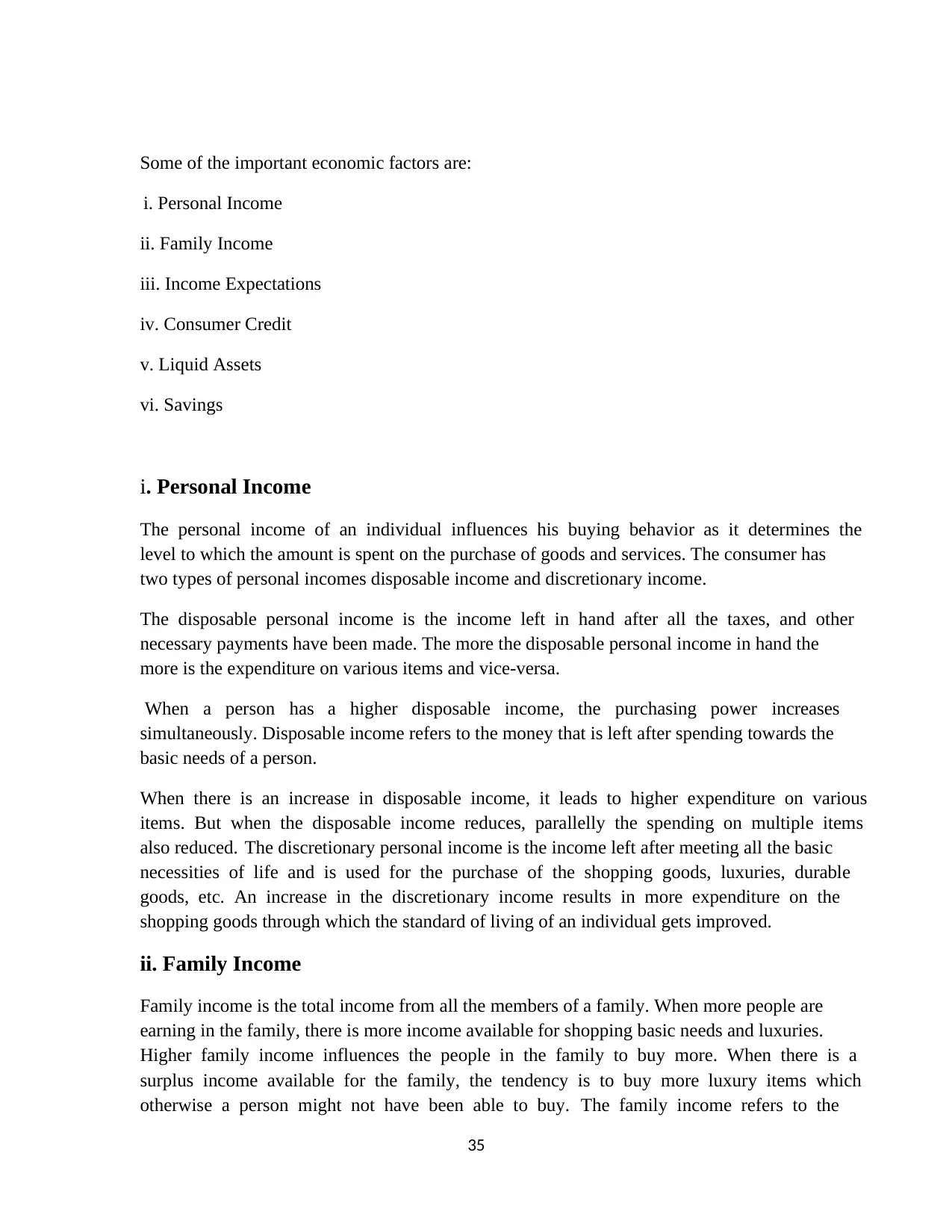
35
Some of the important economic factors are:
i. Personal Income
ii. Family Income
iii. Income Expectations
iv. Consumer Credit
v. Liquid Assets
vi. Savings
i. Personal Income
The personal income of an individual influences his buying behavior as it determines the
level to which the amount is spent on the purchase of goods and services. The consumer has
two types of personal incomes disposable income and discretionary income.
The disposable personal income is the income left in hand after all the taxes, and other
necessary payments have been made. The more the disposable personal income in hand the
more is the expenditure on various items and vice-versa.
When a person has a higher disposable income, the purchasing power increases
simultaneously. Disposable income refers to the money that is left after spending towards the
basic needs of a person.
When there is an increase in disposable income, it leads to higher expenditure on various
items. But when the disposable income reduces, parallelly the spending on multiple items
also reduced. The discretionary personal income is the income left after meeting all the basic
necessities of life and is used for the purchase of the shopping goods, luxuries, durable
goods, etc. An increase in the discretionary income results in more expenditure on the
shopping goods through which the standard of living of an individual gets improved.
ii. Family Income
Family income is the total income from all the members of a family. When more people are
earning in the family, there is more income available for shopping basic needs and luxuries.
Higher family income influences the people in the family to buy more. When there is a
surplus income available for the family, the tendency is to buy more luxury items which
otherwise a person might not have been able to buy. The family income refers to the
Some of the important economic factors are:
i. Personal Income
ii. Family Income
iii. Income Expectations
iv. Consumer Credit
v. Liquid Assets
vi. Savings
i. Personal Income
The personal income of an individual influences his buying behavior as it determines the
level to which the amount is spent on the purchase of goods and services. The consumer has
two types of personal incomes disposable income and discretionary income.
The disposable personal income is the income left in hand after all the taxes, and other
necessary payments have been made. The more the disposable personal income in hand the
more is the expenditure on various items and vice-versa.
When a person has a higher disposable income, the purchasing power increases
simultaneously. Disposable income refers to the money that is left after spending towards the
basic needs of a person.
When there is an increase in disposable income, it leads to higher expenditure on various
items. But when the disposable income reduces, parallelly the spending on multiple items
also reduced. The discretionary personal income is the income left after meeting all the basic
necessities of life and is used for the purchase of the shopping goods, luxuries, durable
goods, etc. An increase in the discretionary income results in more expenditure on the
shopping goods through which the standard of living of an individual gets improved.
ii. Family Income
Family income is the total income from all the members of a family. When more people are
earning in the family, there is more income available for shopping basic needs and luxuries.
Higher family income influences the people in the family to buy more. When there is a
surplus income available for the family, the tendency is to buy more luxury items which
otherwise a person might not have been able to buy. The family income refers to the
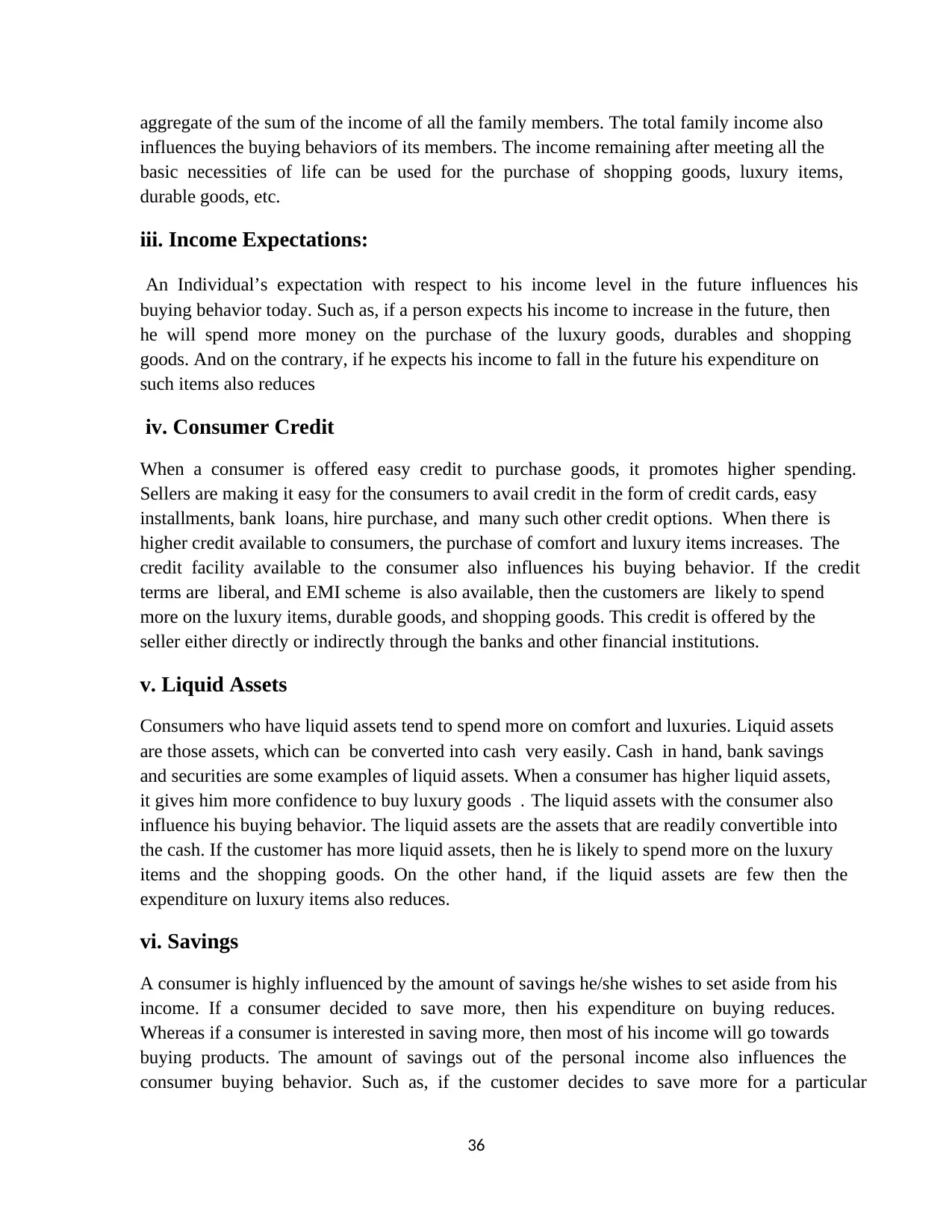
36
aggregate of the sum of the income of all the family members. The total family income also
influences the buying behaviors of its members. The income remaining after meeting all the
basic necessities of life can be used for the purchase of shopping goods, luxury items,
durable goods, etc.
iii. Income Expectations:
An Individual’s expectation with respect to his income level in the future influences his
buying behavior today. Such as, if a person expects his income to increase in the future, then
he will spend more money on the purchase of the luxury goods, durables and shopping
goods. And on the contrary, if he expects his income to fall in the future his expenditure on
such items also reduces
iv. Consumer Credit
When a consumer is offered easy credit to purchase goods, it promotes higher spending.
Sellers are making it easy for the consumers to avail credit in the form of credit cards, easy
installments, bank loans, hire purchase, and many such other credit options. When there is
higher credit available to consumers, the purchase of comfort and luxury items increases. The
credit facility available to the consumer also influences his buying behavior. If the credit
terms are liberal, and EMI scheme is also available, then the customers are likely to spend
more on the luxury items, durable goods, and shopping goods. This credit is offered by the
seller either directly or indirectly through the banks and other financial institutions.
v. Liquid Assets
Consumers who have liquid assets tend to spend more on comfort and luxuries. Liquid assets
are those assets, which can be converted into cash very easily. Cash in hand, bank savings
and securities are some examples of liquid assets. When a consumer has higher liquid assets,
it gives him more confidence to buy luxury goods . The liquid assets with the consumer also
influence his buying behavior. The liquid assets are the assets that are readily convertible into
the cash. If the customer has more liquid assets, then he is likely to spend more on the luxury
items and the shopping goods. On the other hand, if the liquid assets are few then the
expenditure on luxury items also reduces.
vi. Savings
A consumer is highly influenced by the amount of savings he/she wishes to set aside from his
income. If a consumer decided to save more, then his expenditure on buying reduces.
Whereas if a consumer is interested in saving more, then most of his income will go towards
buying products. The amount of savings out of the personal income also influences the
consumer buying behavior. Such as, if the customer decides to save more for a particular
aggregate of the sum of the income of all the family members. The total family income also
influences the buying behaviors of its members. The income remaining after meeting all the
basic necessities of life can be used for the purchase of shopping goods, luxury items,
durable goods, etc.
iii. Income Expectations:
An Individual’s expectation with respect to his income level in the future influences his
buying behavior today. Such as, if a person expects his income to increase in the future, then
he will spend more money on the purchase of the luxury goods, durables and shopping
goods. And on the contrary, if he expects his income to fall in the future his expenditure on
such items also reduces
iv. Consumer Credit
When a consumer is offered easy credit to purchase goods, it promotes higher spending.
Sellers are making it easy for the consumers to avail credit in the form of credit cards, easy
installments, bank loans, hire purchase, and many such other credit options. When there is
higher credit available to consumers, the purchase of comfort and luxury items increases. The
credit facility available to the consumer also influences his buying behavior. If the credit
terms are liberal, and EMI scheme is also available, then the customers are likely to spend
more on the luxury items, durable goods, and shopping goods. This credit is offered by the
seller either directly or indirectly through the banks and other financial institutions.
v. Liquid Assets
Consumers who have liquid assets tend to spend more on comfort and luxuries. Liquid assets
are those assets, which can be converted into cash very easily. Cash in hand, bank savings
and securities are some examples of liquid assets. When a consumer has higher liquid assets,
it gives him more confidence to buy luxury goods . The liquid assets with the consumer also
influence his buying behavior. The liquid assets are the assets that are readily convertible into
the cash. If the customer has more liquid assets, then he is likely to spend more on the luxury
items and the shopping goods. On the other hand, if the liquid assets are few then the
expenditure on luxury items also reduces.
vi. Savings
A consumer is highly influenced by the amount of savings he/she wishes to set aside from his
income. If a consumer decided to save more, then his expenditure on buying reduces.
Whereas if a consumer is interested in saving more, then most of his income will go towards
buying products. The amount of savings out of the personal income also influences the
consumer buying behavior. Such as, if the customer decides to save more for a particular
Paraphrase This Document
Need a fresh take? Get an instant paraphrase of this document with our AI Paraphraser
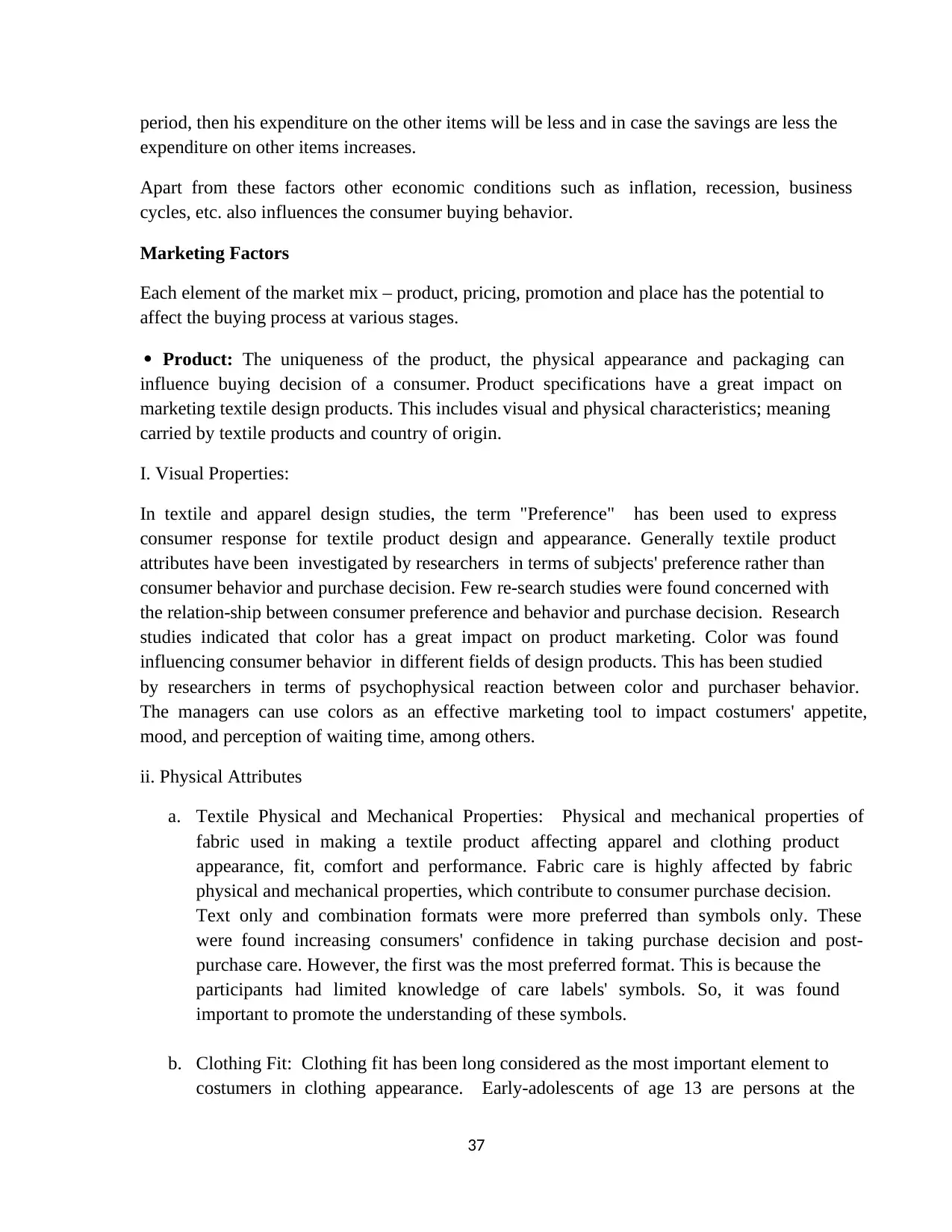
37
period, then his expenditure on the other items will be less and in case the savings are less the
expenditure on other items increases.
Apart from these factors other economic conditions such as inflation, recession, business
cycles, etc. also influences the consumer buying behavior.
Marketing Factors
Each element of the market mix – product, pricing, promotion and place has the potential to
affect the buying process at various stages.
Product: The uniqueness of the product, the physical appearance and packaging can
influence buying decision of a consumer. Product specifications have a great impact on
marketing textile design products. This includes visual and physical characteristics; meaning
carried by textile products and country of origin.
I. Visual Properties:
In textile and apparel design studies, the term "Preference" has been used to express
consumer response for textile product design and appearance. Generally textile product
attributes have been investigated by researchers in terms of subjects' preference rather than
consumer behavior and purchase decision. Few re-search studies were found concerned with
the relation-ship between consumer preference and behavior and purchase decision. Research
studies indicated that color has a great impact on product marketing. Color was found
influencing consumer behavior in different fields of design products. This has been studied
by researchers in terms of psychophysical reaction between color and purchaser behavior.
The managers can use colors as an effective marketing tool to impact costumers' appetite,
mood, and perception of waiting time, among others.
ii. Physical Attributes
a. Textile Physical and Mechanical Properties: Physical and mechanical properties of
fabric used in making a textile product affecting apparel and clothing product
appearance, fit, comfort and performance. Fabric care is highly affected by fabric
physical and mechanical properties, which contribute to consumer purchase decision.
Text only and combination formats were more preferred than symbols only. These
were found increasing consumers' confidence in taking purchase decision and post-
purchase care. However, the first was the most preferred format. This is because the
participants had limited knowledge of care labels' symbols. So, it was found
important to promote the understanding of these symbols.
b. Clothing Fit: Clothing fit has been long considered as the most important element to
costumers in clothing appearance. Early-adolescents of age 13 are persons at the
period, then his expenditure on the other items will be less and in case the savings are less the
expenditure on other items increases.
Apart from these factors other economic conditions such as inflation, recession, business
cycles, etc. also influences the consumer buying behavior.
Marketing Factors
Each element of the market mix – product, pricing, promotion and place has the potential to
affect the buying process at various stages.
Product: The uniqueness of the product, the physical appearance and packaging can
influence buying decision of a consumer. Product specifications have a great impact on
marketing textile design products. This includes visual and physical characteristics; meaning
carried by textile products and country of origin.
I. Visual Properties:
In textile and apparel design studies, the term "Preference" has been used to express
consumer response for textile product design and appearance. Generally textile product
attributes have been investigated by researchers in terms of subjects' preference rather than
consumer behavior and purchase decision. Few re-search studies were found concerned with
the relation-ship between consumer preference and behavior and purchase decision. Research
studies indicated that color has a great impact on product marketing. Color was found
influencing consumer behavior in different fields of design products. This has been studied
by researchers in terms of psychophysical reaction between color and purchaser behavior.
The managers can use colors as an effective marketing tool to impact costumers' appetite,
mood, and perception of waiting time, among others.
ii. Physical Attributes
a. Textile Physical and Mechanical Properties: Physical and mechanical properties of
fabric used in making a textile product affecting apparel and clothing product
appearance, fit, comfort and performance. Fabric care is highly affected by fabric
physical and mechanical properties, which contribute to consumer purchase decision.
Text only and combination formats were more preferred than symbols only. These
were found increasing consumers' confidence in taking purchase decision and post-
purchase care. However, the first was the most preferred format. This is because the
participants had limited knowledge of care labels' symbols. So, it was found
important to promote the understanding of these symbols.
b. Clothing Fit: Clothing fit has been long considered as the most important element to
costumers in clothing appearance. Early-adolescents of age 13 are persons at the
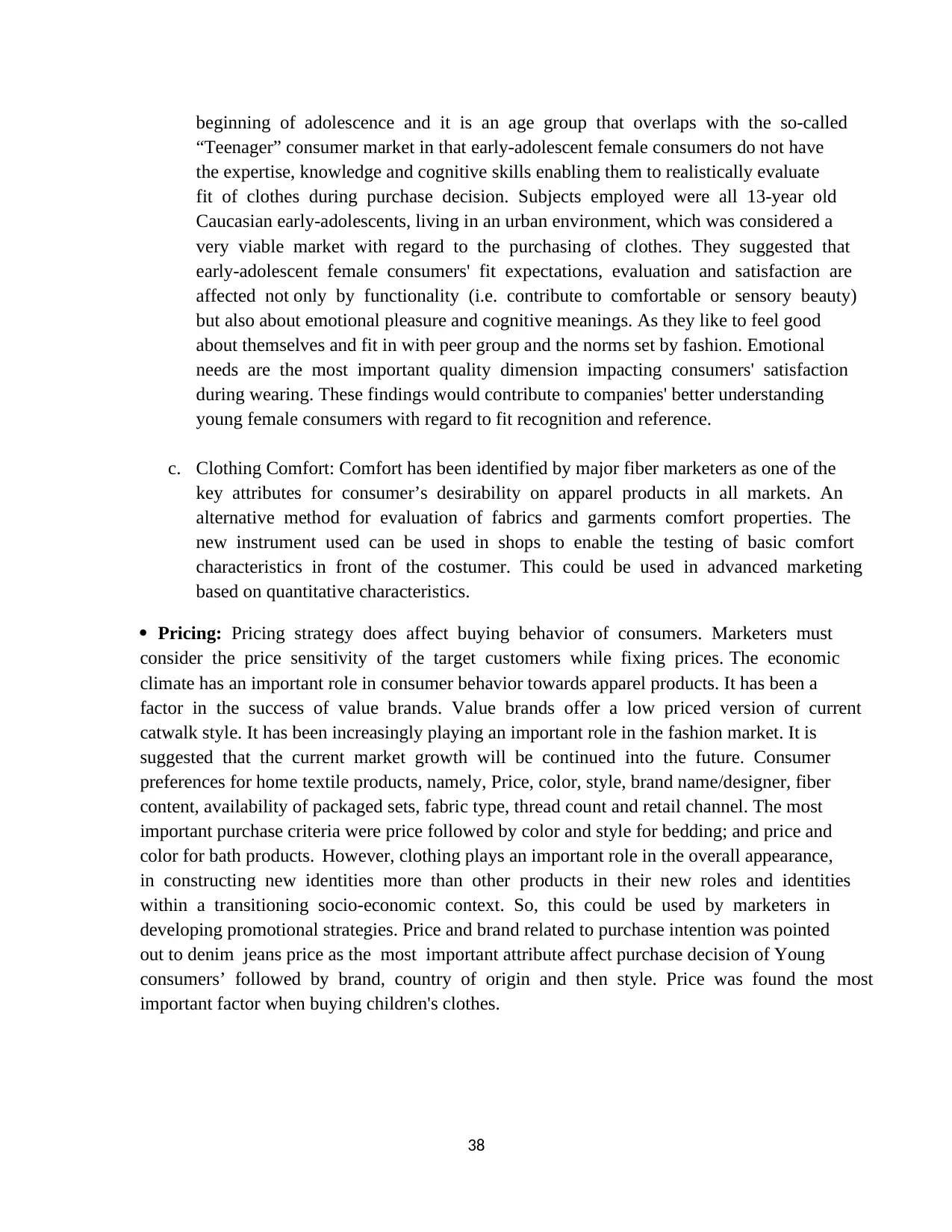
38
beginning of adolescence and it is an age group that overlaps with the so-called
“Teenager” consumer market in that early-adolescent female consumers do not have
the expertise, knowledge and cognitive skills enabling them to realistically evaluate
fit of clothes during purchase decision. Subjects employed were all 13-year old
Caucasian early-adolescents, living in an urban environment, which was considered a
very viable market with regard to the purchasing of clothes. They suggested that
early-adolescent female consumers' fit expectations, evaluation and satisfaction are
affected not only by functionality (i.e. contribute to comfortable or sensory beauty)
but also about emotional pleasure and cognitive meanings. As they like to feel good
about themselves and fit in with peer group and the norms set by fashion. Emotional
needs are the most important quality dimension impacting consumers' satisfaction
during wearing. These findings would contribute to companies' better understanding
young female consumers with regard to fit recognition and reference.
c. Clothing Comfort: Comfort has been identified by major fiber marketers as one of the
key attributes for consumer’s desirability on apparel products in all markets. An
alternative method for evaluation of fabrics and garments comfort properties. The
new instrument used can be used in shops to enable the testing of basic comfort
characteristics in front of the costumer. This could be used in advanced marketing
based on quantitative characteristics.
Pricing: Pricing strategy does affect buying behavior of consumers. Marketers must
consider the price sensitivity of the target customers while fixing prices. The economic
climate has an important role in consumer behavior towards apparel products. It has been a
factor in the success of value brands. Value brands offer a low priced version of current
catwalk style. It has been increasingly playing an important role in the fashion market. It is
suggested that the current market growth will be continued into the future. Consumer
preferences for home textile products, namely, Price, color, style, brand name/designer, fiber
content, availability of packaged sets, fabric type, thread count and retail channel. The most
important purchase criteria were price followed by color and style for bedding; and price and
color for bath products. However, clothing plays an important role in the overall appearance,
in constructing new identities more than other products in their new roles and identities
within a transitioning socio-economic context. So, this could be used by marketers in
developing promotional strategies. Price and brand related to purchase intention was pointed
out to denim jeans price as the most important attribute affect purchase decision of Young
consumers’ followed by brand, country of origin and then style. Price was found the most
important factor when buying children's clothes.
beginning of adolescence and it is an age group that overlaps with the so-called
“Teenager” consumer market in that early-adolescent female consumers do not have
the expertise, knowledge and cognitive skills enabling them to realistically evaluate
fit of clothes during purchase decision. Subjects employed were all 13-year old
Caucasian early-adolescents, living in an urban environment, which was considered a
very viable market with regard to the purchasing of clothes. They suggested that
early-adolescent female consumers' fit expectations, evaluation and satisfaction are
affected not only by functionality (i.e. contribute to comfortable or sensory beauty)
but also about emotional pleasure and cognitive meanings. As they like to feel good
about themselves and fit in with peer group and the norms set by fashion. Emotional
needs are the most important quality dimension impacting consumers' satisfaction
during wearing. These findings would contribute to companies' better understanding
young female consumers with regard to fit recognition and reference.
c. Clothing Comfort: Comfort has been identified by major fiber marketers as one of the
key attributes for consumer’s desirability on apparel products in all markets. An
alternative method for evaluation of fabrics and garments comfort properties. The
new instrument used can be used in shops to enable the testing of basic comfort
characteristics in front of the costumer. This could be used in advanced marketing
based on quantitative characteristics.
Pricing: Pricing strategy does affect buying behavior of consumers. Marketers must
consider the price sensitivity of the target customers while fixing prices. The economic
climate has an important role in consumer behavior towards apparel products. It has been a
factor in the success of value brands. Value brands offer a low priced version of current
catwalk style. It has been increasingly playing an important role in the fashion market. It is
suggested that the current market growth will be continued into the future. Consumer
preferences for home textile products, namely, Price, color, style, brand name/designer, fiber
content, availability of packaged sets, fabric type, thread count and retail channel. The most
important purchase criteria were price followed by color and style for bedding; and price and
color for bath products. However, clothing plays an important role in the overall appearance,
in constructing new identities more than other products in their new roles and identities
within a transitioning socio-economic context. So, this could be used by marketers in
developing promotional strategies. Price and brand related to purchase intention was pointed
out to denim jeans price as the most important attribute affect purchase decision of Young
consumers’ followed by brand, country of origin and then style. Price was found the most
important factor when buying children's clothes.
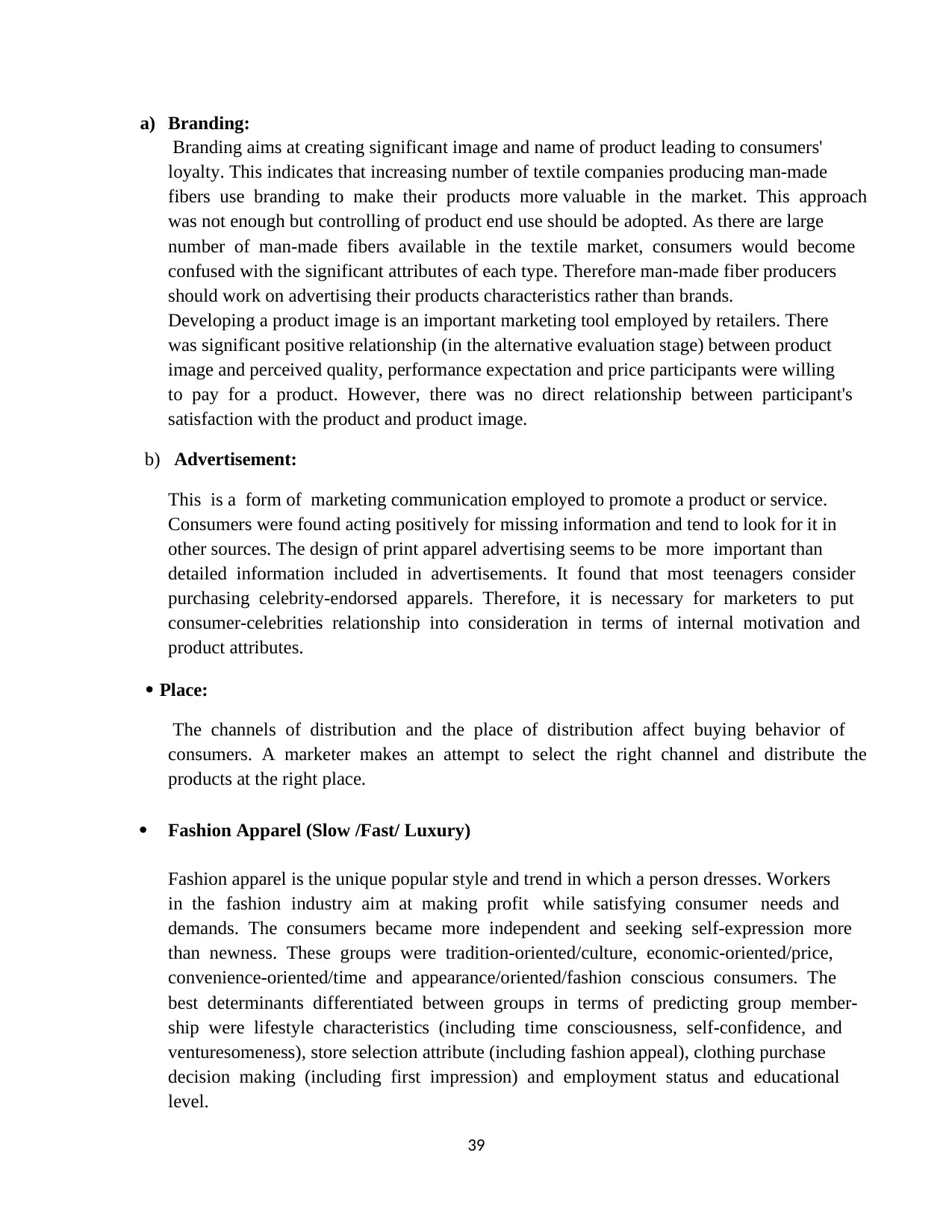
39
a) Branding:
Branding aims at creating significant image and name of product leading to consumers'
loyalty. This indicates that increasing number of textile companies producing man-made
fibers use branding to make their products more valuable in the market. This approach
was not enough but controlling of product end use should be adopted. As there are large
number of man-made fibers available in the textile market, consumers would become
confused with the significant attributes of each type. Therefore man-made fiber producers
should work on advertising their products characteristics rather than brands.
Developing a product image is an important marketing tool employed by retailers. There
was significant positive relationship (in the alternative evaluation stage) between product
image and perceived quality, performance expectation and price participants were willing
to pay for a product. However, there was no direct relationship between participant's
satisfaction with the product and product image.
b) Advertisement:
This is a form of marketing communication employed to promote a product or service.
Consumers were found acting positively for missing information and tend to look for it in
other sources. The design of print apparel advertising seems to be more important than
detailed information included in advertisements. It found that most teenagers consider
purchasing celebrity-endorsed apparels. Therefore, it is necessary for marketers to put
consumer-celebrities relationship into consideration in terms of internal motivation and
product attributes.
Place:
The channels of distribution and the place of distribution affect buying behavior of
consumers. A marketer makes an attempt to select the right channel and distribute the
products at the right place.
Fashion Apparel (Slow /Fast/ Luxury)
Fashion apparel is the unique popular style and trend in which a person dresses. Workers
in the fashion industry aim at making profit while satisfying consumer needs and
demands. The consumers became more independent and seeking self-expression more
than newness. These groups were tradition-oriented/culture, economic-oriented/price,
convenience-oriented/time and appearance/oriented/fashion conscious consumers. The
best determinants differentiated between groups in terms of predicting group member-
ship were lifestyle characteristics (including time consciousness, self-confidence, and
venturesomeness), store selection attribute (including fashion appeal), clothing purchase
decision making (including first impression) and employment status and educational
level.
a) Branding:
Branding aims at creating significant image and name of product leading to consumers'
loyalty. This indicates that increasing number of textile companies producing man-made
fibers use branding to make their products more valuable in the market. This approach
was not enough but controlling of product end use should be adopted. As there are large
number of man-made fibers available in the textile market, consumers would become
confused with the significant attributes of each type. Therefore man-made fiber producers
should work on advertising their products characteristics rather than brands.
Developing a product image is an important marketing tool employed by retailers. There
was significant positive relationship (in the alternative evaluation stage) between product
image and perceived quality, performance expectation and price participants were willing
to pay for a product. However, there was no direct relationship between participant's
satisfaction with the product and product image.
b) Advertisement:
This is a form of marketing communication employed to promote a product or service.
Consumers were found acting positively for missing information and tend to look for it in
other sources. The design of print apparel advertising seems to be more important than
detailed information included in advertisements. It found that most teenagers consider
purchasing celebrity-endorsed apparels. Therefore, it is necessary for marketers to put
consumer-celebrities relationship into consideration in terms of internal motivation and
product attributes.
Place:
The channels of distribution and the place of distribution affect buying behavior of
consumers. A marketer makes an attempt to select the right channel and distribute the
products at the right place.
Fashion Apparel (Slow /Fast/ Luxury)
Fashion apparel is the unique popular style and trend in which a person dresses. Workers
in the fashion industry aim at making profit while satisfying consumer needs and
demands. The consumers became more independent and seeking self-expression more
than newness. These groups were tradition-oriented/culture, economic-oriented/price,
convenience-oriented/time and appearance/oriented/fashion conscious consumers. The
best determinants differentiated between groups in terms of predicting group member-
ship were lifestyle characteristics (including time consciousness, self-confidence, and
venturesomeness), store selection attribute (including fashion appeal), clothing purchase
decision making (including first impression) and employment status and educational
level.
Secure Best Marks with AI Grader
Need help grading? Try our AI Grader for instant feedback on your assignments.

40
Slow and fast fashion industries are two contradictory processes applied in producing
fashion products have been studied by researchers. Slow and fast fashion consumer
decision process stages (i.e. purchase/consumption, post-consumption evaluation, and
divestment), all participants were females above 18 years of age or older. The
purchase/consumption aspects studied were buyers’ remorse avoidance, utilitarianism,
hedonism, and style/self-image congruence. Fast fashion consumers avoid remorse
purchase inexpensive clothing, but slow fashion consumers focus on the concept of
quality over quantity. Achieving hedonism was through shopping experience, stores
atmosphere, social experiences, buying in large quantities, and “hunting” for goods for
fast fashion buyers, and through a love for couture and art however for slow fashion
buyers. For both fast fashion and slow fashion consumers the style of the clothing aligned
with their self-image was an essential factor affecting of purchase/ consumption.
However, fast and slow fashion consumers were different with regard to utilitarianism,
the first maximize their utility by buying a higher quantity of clothing at a lower price,
however the latter by buying clothes that is versatile, well fitting, consistent with their
wardrobe, high quality, and an investment Retailers would use these findings to better
understand the targeted consumer .
Fast fashion implies a personal and social experience and meaning management.
Consumers fast fashion experience using keywords employed by participants. The most
commonly used positive terms were freedom, fun, saving, speed and personalization. The
most commonly used negative terms were unnecessary, poor quality, short term,
anonymous. It was found that functional values over weighted social and symbolic values
to pay more. This finding showed a growing market maturity. Marketers should pay
greater attention to enhance the perceived functional and social values of the brands in
order to uplift consumer attitude towards the brands which in turn strengthen consumer
engagement in purchasing process. Consumer attitude towards branded fashion apparel
is affected by gender. Most of the participants were found significantly buying branded
apparel products. They indicated that men are highly influenced by social/cultural factors.
However females are affected by marketing communication efforts such as television,
advertising, magazines, catalogues and celebrities, and by both personal selling and direct
marketing.
There was a positive relationship between consumers' self-esteem and brand conscious
leading to strong motivation towards purchasing strongly connected brands with them.
This would build consumer brand loyalty and support purchase intention to luxury
fashion products. As they prefer buying brand name supporting their view with their
peers. Moreover, they chose brands reflecting their self-image. This indicates that it is
important to understand generation "new comers" to luxury fashion market in the light of
their personality and consumption motivations. Luxury fashion brands should build brand
consciousness reflecting young generation of consumer.
Slow and fast fashion industries are two contradictory processes applied in producing
fashion products have been studied by researchers. Slow and fast fashion consumer
decision process stages (i.e. purchase/consumption, post-consumption evaluation, and
divestment), all participants were females above 18 years of age or older. The
purchase/consumption aspects studied were buyers’ remorse avoidance, utilitarianism,
hedonism, and style/self-image congruence. Fast fashion consumers avoid remorse
purchase inexpensive clothing, but slow fashion consumers focus on the concept of
quality over quantity. Achieving hedonism was through shopping experience, stores
atmosphere, social experiences, buying in large quantities, and “hunting” for goods for
fast fashion buyers, and through a love for couture and art however for slow fashion
buyers. For both fast fashion and slow fashion consumers the style of the clothing aligned
with their self-image was an essential factor affecting of purchase/ consumption.
However, fast and slow fashion consumers were different with regard to utilitarianism,
the first maximize their utility by buying a higher quantity of clothing at a lower price,
however the latter by buying clothes that is versatile, well fitting, consistent with their
wardrobe, high quality, and an investment Retailers would use these findings to better
understand the targeted consumer .
Fast fashion implies a personal and social experience and meaning management.
Consumers fast fashion experience using keywords employed by participants. The most
commonly used positive terms were freedom, fun, saving, speed and personalization. The
most commonly used negative terms were unnecessary, poor quality, short term,
anonymous. It was found that functional values over weighted social and symbolic values
to pay more. This finding showed a growing market maturity. Marketers should pay
greater attention to enhance the perceived functional and social values of the brands in
order to uplift consumer attitude towards the brands which in turn strengthen consumer
engagement in purchasing process. Consumer attitude towards branded fashion apparel
is affected by gender. Most of the participants were found significantly buying branded
apparel products. They indicated that men are highly influenced by social/cultural factors.
However females are affected by marketing communication efforts such as television,
advertising, magazines, catalogues and celebrities, and by both personal selling and direct
marketing.
There was a positive relationship between consumers' self-esteem and brand conscious
leading to strong motivation towards purchasing strongly connected brands with them.
This would build consumer brand loyalty and support purchase intention to luxury
fashion products. As they prefer buying brand name supporting their view with their
peers. Moreover, they chose brands reflecting their self-image. This indicates that it is
important to understand generation "new comers" to luxury fashion market in the light of
their personality and consumption motivations. Luxury fashion brands should build brand
consciousness reflecting young generation of consumer.
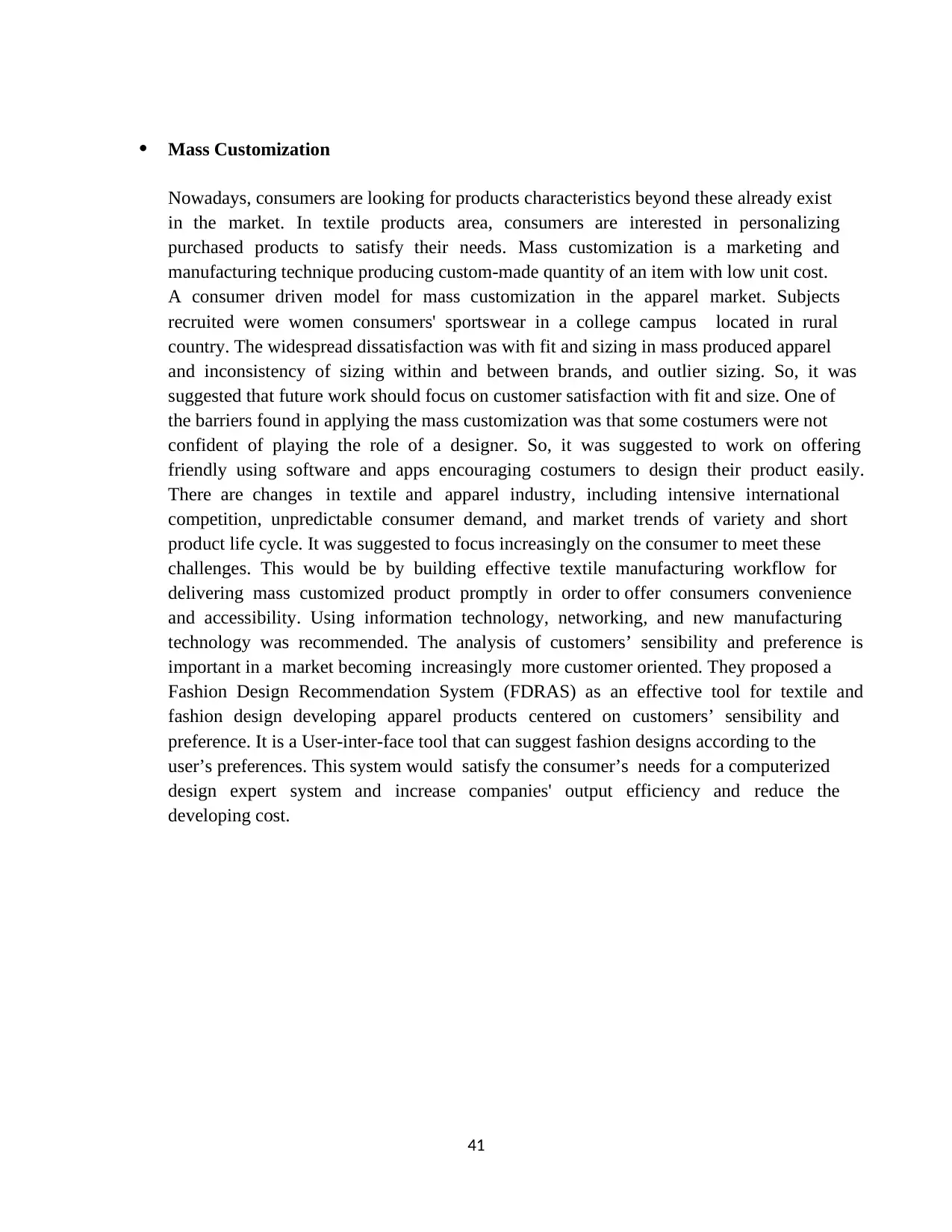
41
Mass Customization
Nowadays, consumers are looking for products characteristics beyond these already exist
in the market. In textile products area, consumers are interested in personalizing
purchased products to satisfy their needs. Mass customization is a marketing and
manufacturing technique producing custom-made quantity of an item with low unit cost.
A consumer driven model for mass customization in the apparel market. Subjects
recruited were women consumers' sportswear in a college campus located in rural
country. The widespread dissatisfaction was with fit and sizing in mass produced apparel
and inconsistency of sizing within and between brands, and outlier sizing. So, it was
suggested that future work should focus on customer satisfaction with fit and size. One of
the barriers found in applying the mass customization was that some costumers were not
confident of playing the role of a designer. So, it was suggested to work on offering
friendly using software and apps encouraging costumers to design their product easily.
There are changes in textile and apparel industry, including intensive international
competition, unpredictable consumer demand, and market trends of variety and short
product life cycle. It was suggested to focus increasingly on the consumer to meet these
challenges. This would be by building effective textile manufacturing workflow for
delivering mass customized product promptly in order to offer consumers convenience
and accessibility. Using information technology, networking, and new manufacturing
technology was recommended. The analysis of customers’ sensibility and preference is
important in a market becoming increasingly more customer oriented. They proposed a
Fashion Design Recommendation System (FDRAS) as an effective tool for textile and
fashion design developing apparel products centered on customers’ sensibility and
preference. It is a User-inter-face tool that can suggest fashion designs according to the
user’s preferences. This system would satisfy the consumer’s needs for a computerized
design expert system and increase companies' output efficiency and reduce the
developing cost.
Mass Customization
Nowadays, consumers are looking for products characteristics beyond these already exist
in the market. In textile products area, consumers are interested in personalizing
purchased products to satisfy their needs. Mass customization is a marketing and
manufacturing technique producing custom-made quantity of an item with low unit cost.
A consumer driven model for mass customization in the apparel market. Subjects
recruited were women consumers' sportswear in a college campus located in rural
country. The widespread dissatisfaction was with fit and sizing in mass produced apparel
and inconsistency of sizing within and between brands, and outlier sizing. So, it was
suggested that future work should focus on customer satisfaction with fit and size. One of
the barriers found in applying the mass customization was that some costumers were not
confident of playing the role of a designer. So, it was suggested to work on offering
friendly using software and apps encouraging costumers to design their product easily.
There are changes in textile and apparel industry, including intensive international
competition, unpredictable consumer demand, and market trends of variety and short
product life cycle. It was suggested to focus increasingly on the consumer to meet these
challenges. This would be by building effective textile manufacturing workflow for
delivering mass customized product promptly in order to offer consumers convenience
and accessibility. Using information technology, networking, and new manufacturing
technology was recommended. The analysis of customers’ sensibility and preference is
important in a market becoming increasingly more customer oriented. They proposed a
Fashion Design Recommendation System (FDRAS) as an effective tool for textile and
fashion design developing apparel products centered on customers’ sensibility and
preference. It is a User-inter-face tool that can suggest fashion designs according to the
user’s preferences. This system would satisfy the consumer’s needs for a computerized
design expert system and increase companies' output efficiency and reduce the
developing cost.
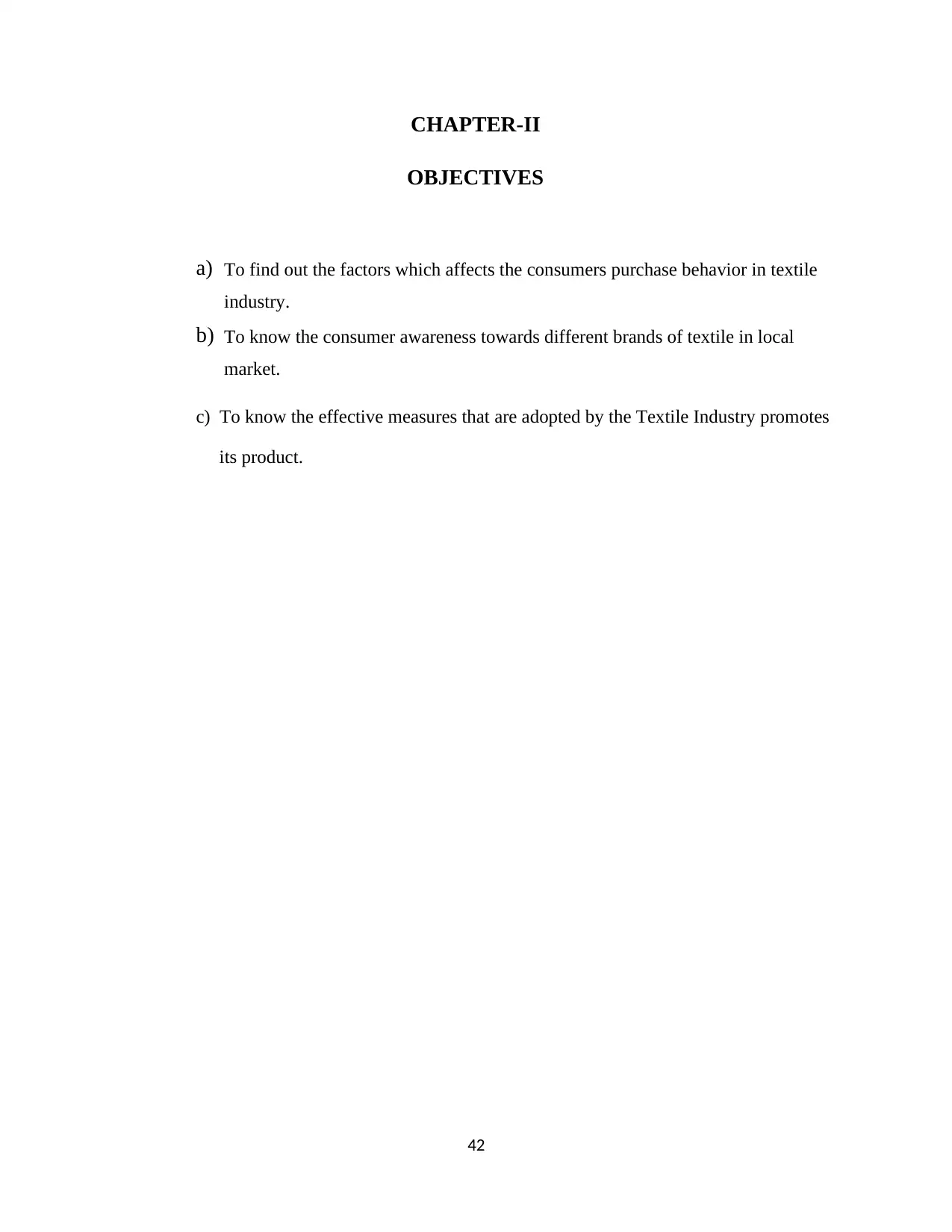
42
CHAPTER-II
OBJECTIVES
a) To find out the factors which affects the consumers purchase behavior in textile
industry.
b) To know the consumer awareness towards different brands of textile in local
market.
c) To know the effective measures that are adopted by the Textile Industry promotes
its product.
CHAPTER-II
OBJECTIVES
a) To find out the factors which affects the consumers purchase behavior in textile
industry.
b) To know the consumer awareness towards different brands of textile in local
market.
c) To know the effective measures that are adopted by the Textile Industry promotes
its product.
Paraphrase This Document
Need a fresh take? Get an instant paraphrase of this document with our AI Paraphraser
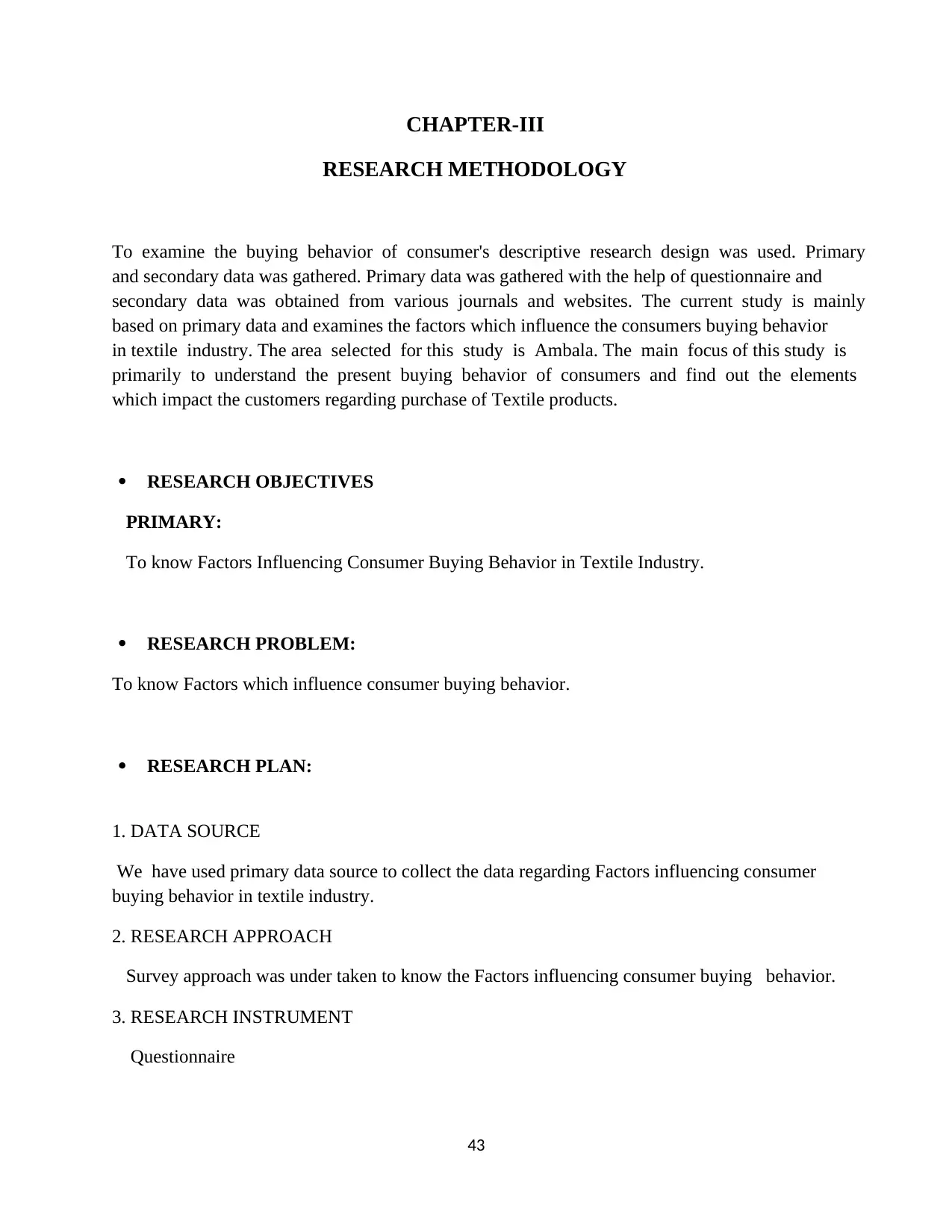
43
CHAPTER-III
RESEARCH METHODOLOGY
To examine the buying behavior of consumer's descriptive research design was used. Primary
and secondary data was gathered. Primary data was gathered with the help of questionnaire and
secondary data was obtained from various journals and websites. The current study is mainly
based on primary data and examines the factors which influence the consumers buying behavior
in textile industry. The area selected for this study is Ambala. The main focus of this study is
primarily to understand the present buying behavior of consumers and find out the elements
which impact the customers regarding purchase of Textile products.
RESEARCH OBJECTIVES
PRIMARY:
To know Factors Influencing Consumer Buying Behavior in Textile Industry.
RESEARCH PROBLEM:
To know Factors which influence consumer buying behavior.
RESEARCH PLAN:
1. DATA SOURCE
We have used primary data source to collect the data regarding Factors influencing consumer
buying behavior in textile industry.
2. RESEARCH APPROACH
Survey approach was under taken to know the Factors influencing consumer buying behavior.
3. RESEARCH INSTRUMENT
Questionnaire
CHAPTER-III
RESEARCH METHODOLOGY
To examine the buying behavior of consumer's descriptive research design was used. Primary
and secondary data was gathered. Primary data was gathered with the help of questionnaire and
secondary data was obtained from various journals and websites. The current study is mainly
based on primary data and examines the factors which influence the consumers buying behavior
in textile industry. The area selected for this study is Ambala. The main focus of this study is
primarily to understand the present buying behavior of consumers and find out the elements
which impact the customers regarding purchase of Textile products.
RESEARCH OBJECTIVES
PRIMARY:
To know Factors Influencing Consumer Buying Behavior in Textile Industry.
RESEARCH PROBLEM:
To know Factors which influence consumer buying behavior.
RESEARCH PLAN:
1. DATA SOURCE
We have used primary data source to collect the data regarding Factors influencing consumer
buying behavior in textile industry.
2. RESEARCH APPROACH
Survey approach was under taken to know the Factors influencing consumer buying behavior.
3. RESEARCH INSTRUMENT
Questionnaire

44
CHAPTER-IV
FINDINGS
Fashion, Brand and Comfort are the most important variables during the decision of purchase
in Textile industry. Proximity to work and Availability of quality apparel are factors
considered by customers for choosing store. Divider poles and Hoardings from
advertisements, Discount and Holiday vouchers from offers are having a higher impact on
the perception of the consumer with respect to promotional strategies. Quality factor plays an
important role for consumers during buying behavior of apparel. Impulsiveness/Carelessness
buying is also factor for consumers during buying behavior of apparel and hence store Plano-
gram should be aligned to impulsive tendencies Brand behavior, pricing and availability are
other significant factors is also considered an important factor for the customers who shop
from value Garment store. Age group of 15-25 yrs is more active in shopping and visiting to
fashion as compared to other age groups. A consumer may purchase, use, and / or dispose of
am product, but these functions may be performed by different people. In addition,
consumers may be thought of as role players who need different products to help them play
their various parts. Marketing activities exert an enormous impact on individuals. Consumer
behavior is relevant to our understanding of the dynamics of popular culture.
The various elements of promotion such as advertising, publicity, public relations, personal
selling, and sales promotion affect buying behavior of consumers. Marketers select the
promotion mix after considering the nature of customers. This is one of the marketing
elements used to communicate a product to a costumer. This is to raise consumer awareness
of the product. Brand awareness is one of the most common uses of promotional items
establishing product image for consumer. This is one of the marketing elements used to
communicate a product to a costumer. This is to raise consumer awareness of the product.
Brand awareness is one of the most common uses of promotional items establishing product
image for consumer.
CHAPTER-IV
FINDINGS
Fashion, Brand and Comfort are the most important variables during the decision of purchase
in Textile industry. Proximity to work and Availability of quality apparel are factors
considered by customers for choosing store. Divider poles and Hoardings from
advertisements, Discount and Holiday vouchers from offers are having a higher impact on
the perception of the consumer with respect to promotional strategies. Quality factor plays an
important role for consumers during buying behavior of apparel. Impulsiveness/Carelessness
buying is also factor for consumers during buying behavior of apparel and hence store Plano-
gram should be aligned to impulsive tendencies Brand behavior, pricing and availability are
other significant factors is also considered an important factor for the customers who shop
from value Garment store. Age group of 15-25 yrs is more active in shopping and visiting to
fashion as compared to other age groups. A consumer may purchase, use, and / or dispose of
am product, but these functions may be performed by different people. In addition,
consumers may be thought of as role players who need different products to help them play
their various parts. Marketing activities exert an enormous impact on individuals. Consumer
behavior is relevant to our understanding of the dynamics of popular culture.
The various elements of promotion such as advertising, publicity, public relations, personal
selling, and sales promotion affect buying behavior of consumers. Marketers select the
promotion mix after considering the nature of customers. This is one of the marketing
elements used to communicate a product to a costumer. This is to raise consumer awareness
of the product. Brand awareness is one of the most common uses of promotional items
establishing product image for consumer. This is one of the marketing elements used to
communicate a product to a costumer. This is to raise consumer awareness of the product.
Brand awareness is one of the most common uses of promotional items establishing product
image for consumer.
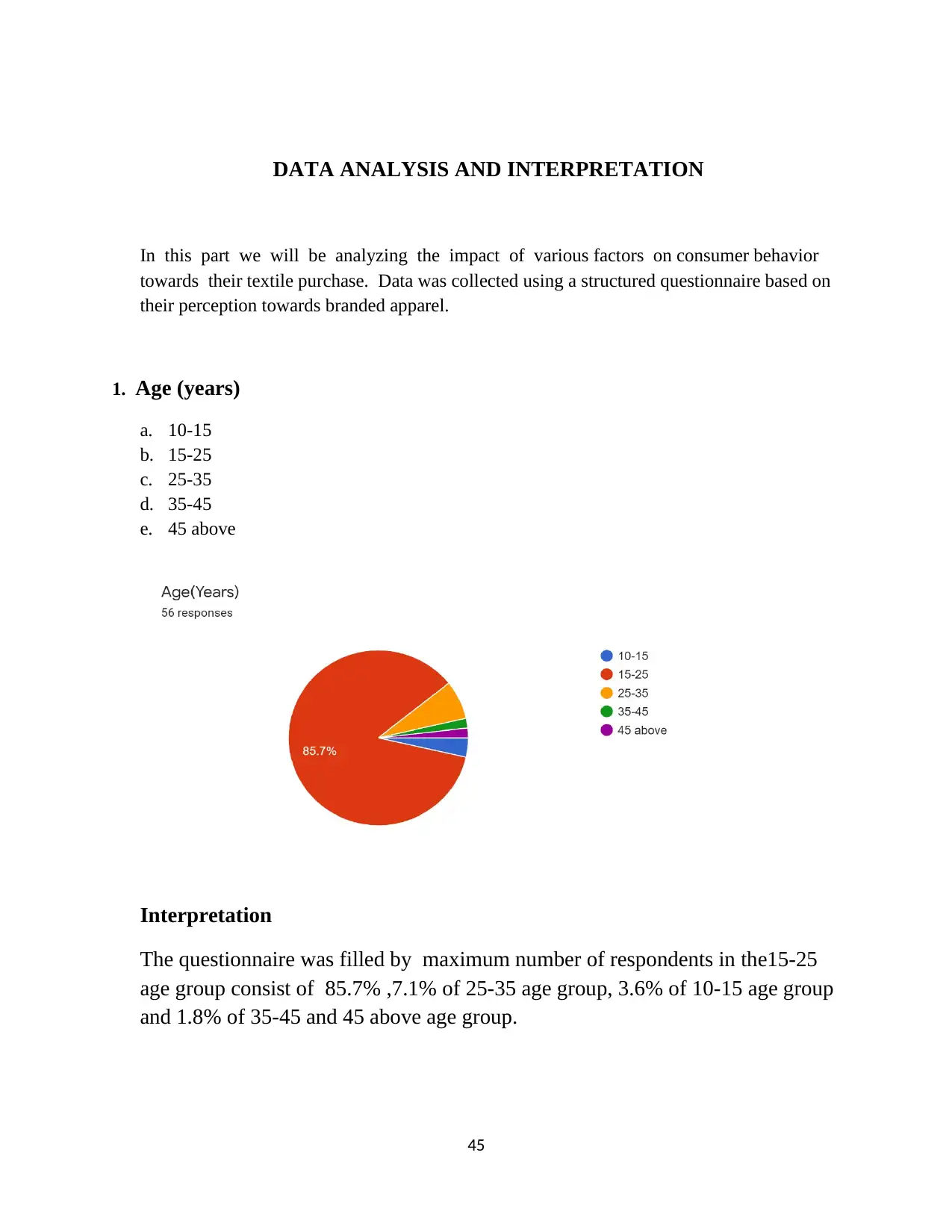
45
DATA ANALYSIS AND INTERPRETATION
In this part we will be analyzing the impact of various factors on consumer behavior
towards their textile purchase. Data was collected using a structured questionnaire based on
their perception towards branded apparel.
1. Age (years)
a. 10-15
b. 15-25
c. 25-35
d. 35-45
e. 45 above
Interpretation
The questionnaire was filled by maximum number of respondents in the15-25
age group consist of 85.7% ,7.1% of 25-35 age group, 3.6% of 10-15 age group
and 1.8% of 35-45 and 45 above age group.
DATA ANALYSIS AND INTERPRETATION
In this part we will be analyzing the impact of various factors on consumer behavior
towards their textile purchase. Data was collected using a structured questionnaire based on
their perception towards branded apparel.
1. Age (years)
a. 10-15
b. 15-25
c. 25-35
d. 35-45
e. 45 above
Interpretation
The questionnaire was filled by maximum number of respondents in the15-25
age group consist of 85.7% ,7.1% of 25-35 age group, 3.6% of 10-15 age group
and 1.8% of 35-45 and 45 above age group.
Secure Best Marks with AI Grader
Need help grading? Try our AI Grader for instant feedback on your assignments.
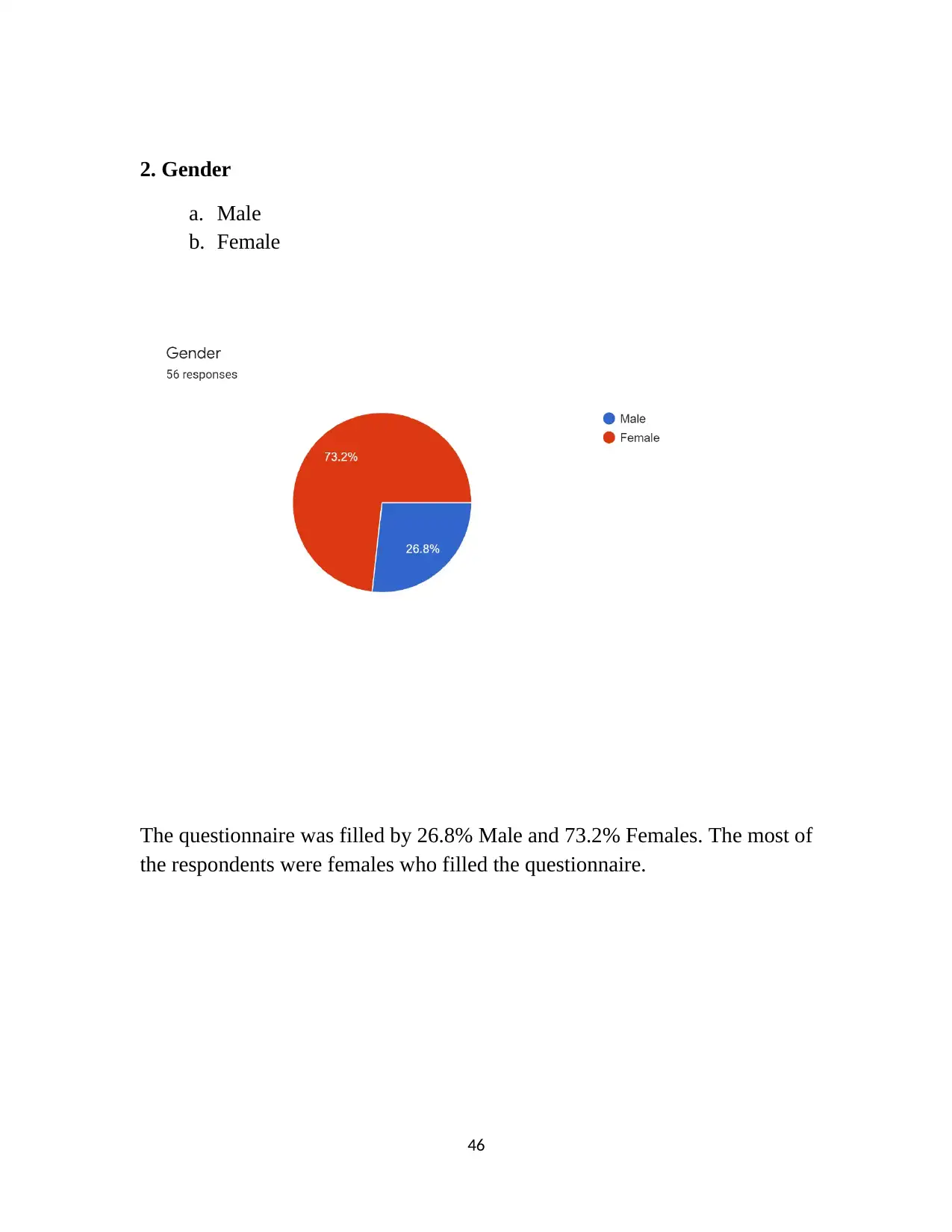
46
2. Gender
a. Male
b. Female
The questionnaire was filled by 26.8% Male and 73.2% Females. The most of
the respondents were females who filled the questionnaire.
2. Gender
a. Male
b. Female
The questionnaire was filled by 26.8% Male and 73.2% Females. The most of
the respondents were females who filled the questionnaire.
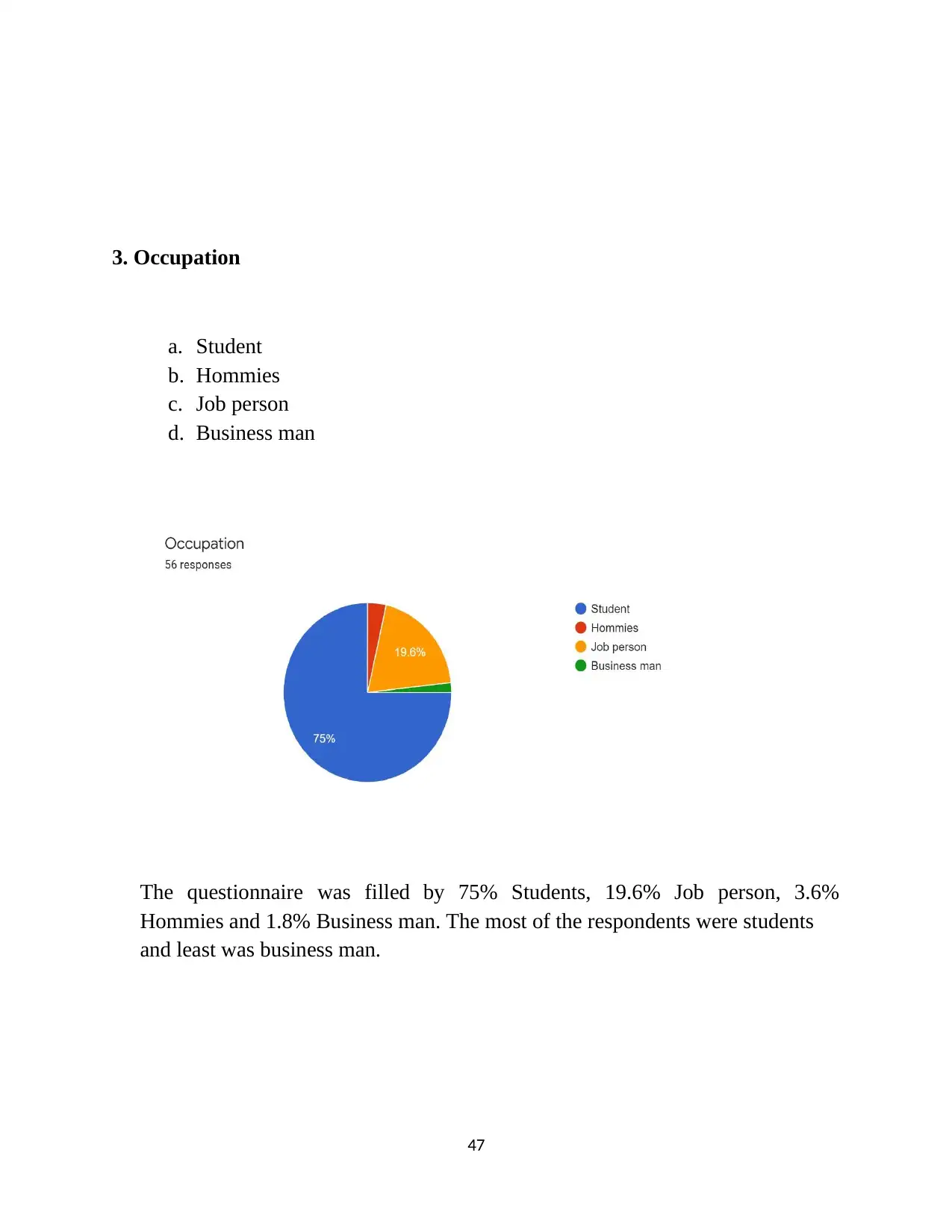
47
3. Occupation
a. Student
b. Hommies
c. Job person
d. Business man
The questionnaire was filled by 75% Students, 19.6% Job person, 3.6%
Hommies and 1.8% Business man. The most of the respondents were students
and least was business man.
3. Occupation
a. Student
b. Hommies
c. Job person
d. Business man
The questionnaire was filled by 75% Students, 19.6% Job person, 3.6%
Hommies and 1.8% Business man. The most of the respondents were students
and least was business man.

48
4. Annual Income
a. Below 1 lakh
b. 1-2 lakh
c. 2-3 lakh
d. Above 3 lakh
The above chart shows that 55.4% of the respondents are found to have an annual
income of less than 1lakh (includes students also, their pocket money is also
considered as income as they tend to spend that money while making transactions).
23.2% of the respondents have an income of 1-2 lakh, 8.9% of the respondents
have an income between 2-3 lakh and 12.5% of the respondents were found to
have an income more than 3 lakh .
4. Annual Income
a. Below 1 lakh
b. 1-2 lakh
c. 2-3 lakh
d. Above 3 lakh
The above chart shows that 55.4% of the respondents are found to have an annual
income of less than 1lakh (includes students also, their pocket money is also
considered as income as they tend to spend that money while making transactions).
23.2% of the respondents have an income of 1-2 lakh, 8.9% of the respondents
have an income between 2-3 lakh and 12.5% of the respondents were found to
have an income more than 3 lakh .
Paraphrase This Document
Need a fresh take? Get an instant paraphrase of this document with our AI Paraphraser

49
5. Qualification
a. Matric
b. Intermediate
c. Graduate
d. Post Graduate
e. Any other Technical Qualification
The questionnaire was filled by the respondents out of which 37.5% of
respondents were Intermediate, 28.6%of respondents were Graduate, 19.6%of
respondents were Post Graduate, and 8.9% of respondents were Matriculate and
5.4% of respondents having any other technical qualification.
5. Qualification
a. Matric
b. Intermediate
c. Graduate
d. Post Graduate
e. Any other Technical Qualification
The questionnaire was filled by the respondents out of which 37.5% of
respondents were Intermediate, 28.6%of respondents were Graduate, 19.6%of
respondents were Post Graduate, and 8.9% of respondents were Matriculate and
5.4% of respondents having any other technical qualification.
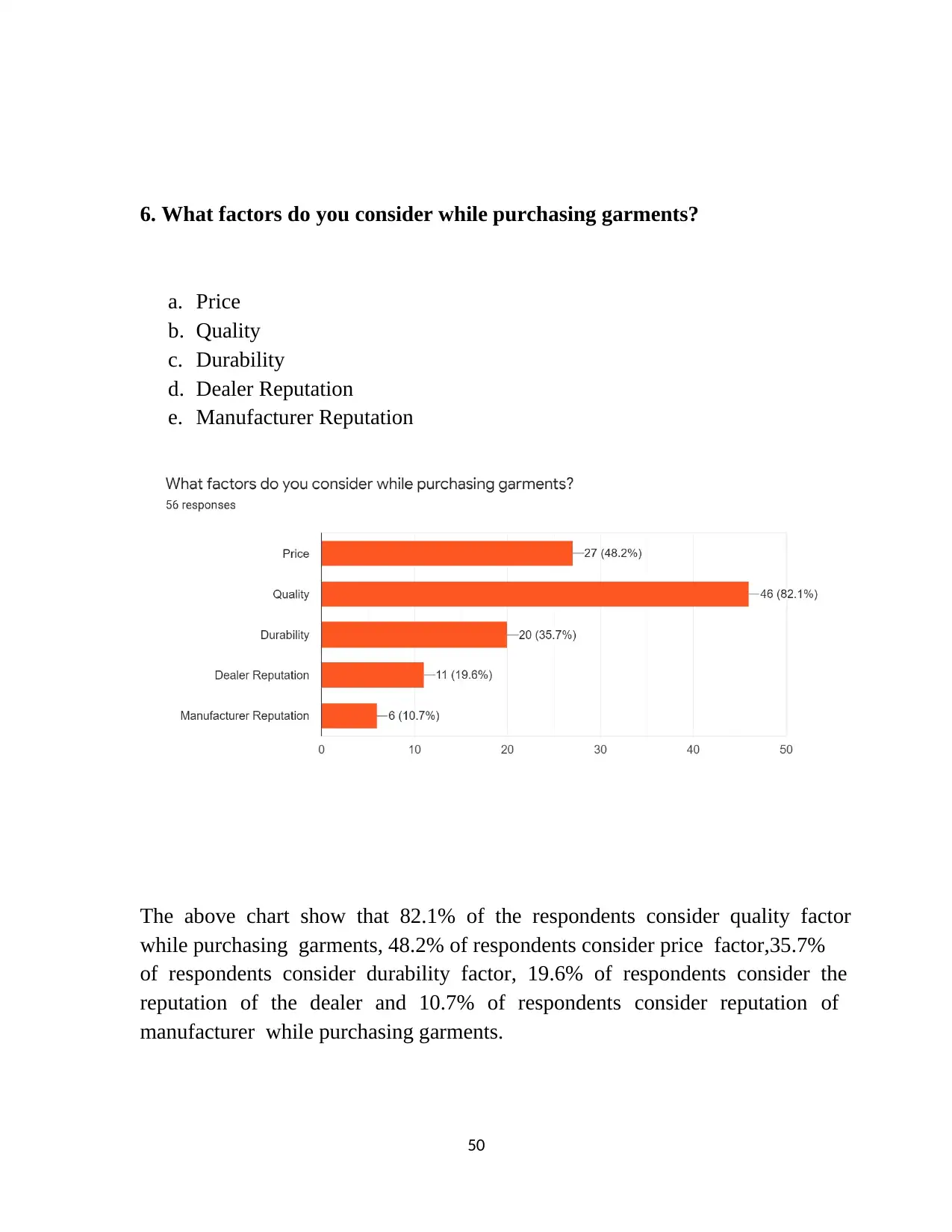
50
6. What factors do you consider while purchasing garments?
a. Price
b. Quality
c. Durability
d. Dealer Reputation
e. Manufacturer Reputation
The above chart show that 82.1% of the respondents consider quality factor
while purchasing garments, 48.2% of respondents consider price factor,35.7%
of respondents consider durability factor, 19.6% of respondents consider the
reputation of the dealer and 10.7% of respondents consider reputation of
manufacturer while purchasing garments.
6. What factors do you consider while purchasing garments?
a. Price
b. Quality
c. Durability
d. Dealer Reputation
e. Manufacturer Reputation
The above chart show that 82.1% of the respondents consider quality factor
while purchasing garments, 48.2% of respondents consider price factor,35.7%
of respondents consider durability factor, 19.6% of respondents consider the
reputation of the dealer and 10.7% of respondents consider reputation of
manufacturer while purchasing garments.
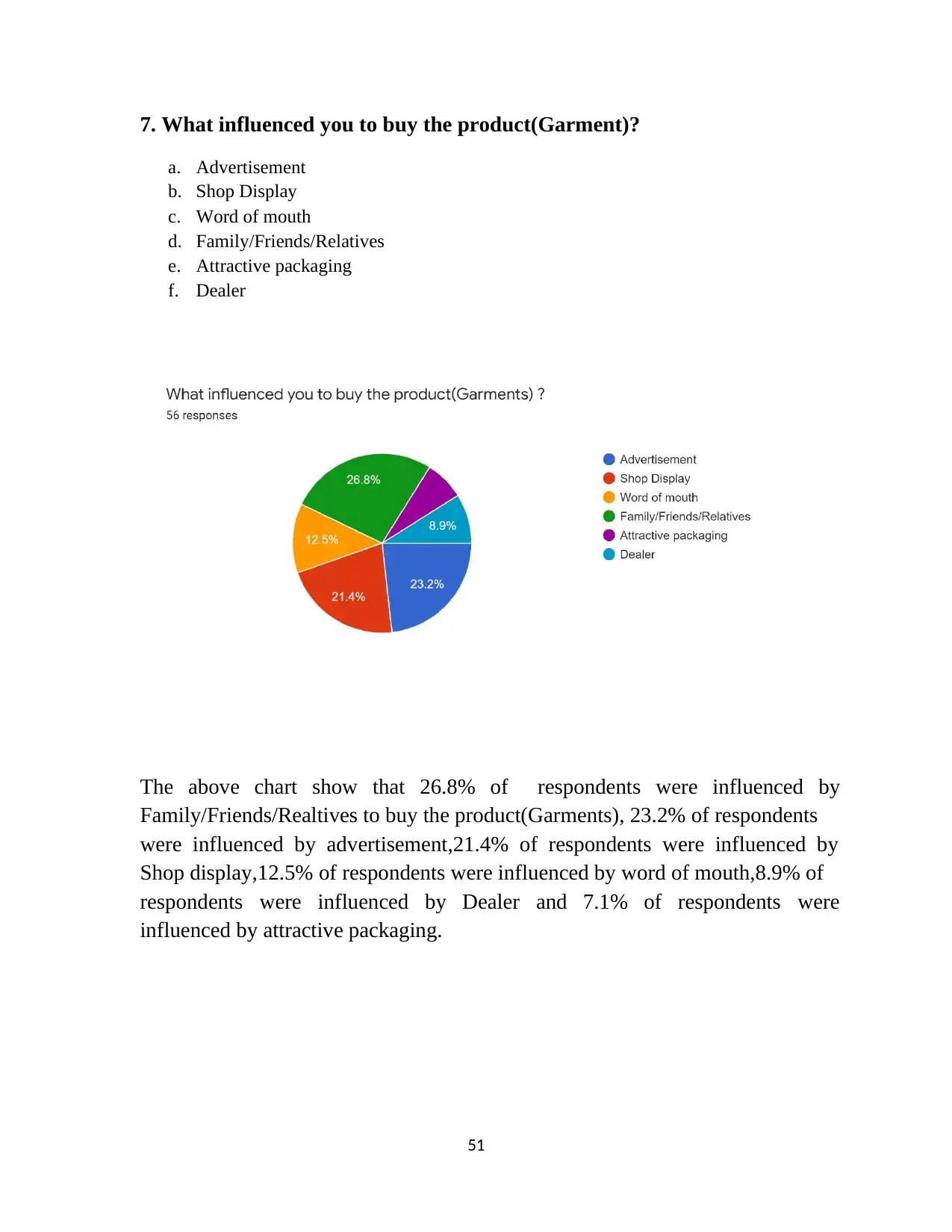
51
7. What influenced you to buy the product(Garment)?
a. Advertisement
b. Shop Display
c. Word of mouth
d. Family/Friends/Relatives
e. Attractive packaging
f. Dealer
The above chart show that 26.8% of respondents were influenced by
Family/Friends/Realtives to buy the product(Garments), 23.2% of respondents
were influenced by advertisement,21.4% of respondents were influenced by
Shop display,12.5% of respondents were influenced by word of mouth,8.9% of
respondents were influenced by Dealer and 7.1% of respondents were
influenced by attractive packaging.
7. What influenced you to buy the product(Garment)?
a. Advertisement
b. Shop Display
c. Word of mouth
d. Family/Friends/Relatives
e. Attractive packaging
f. Dealer
The above chart show that 26.8% of respondents were influenced by
Family/Friends/Realtives to buy the product(Garments), 23.2% of respondents
were influenced by advertisement,21.4% of respondents were influenced by
Shop display,12.5% of respondents were influenced by word of mouth,8.9% of
respondents were influenced by Dealer and 7.1% of respondents were
influenced by attractive packaging.
Secure Best Marks with AI Grader
Need help grading? Try our AI Grader for instant feedback on your assignments.
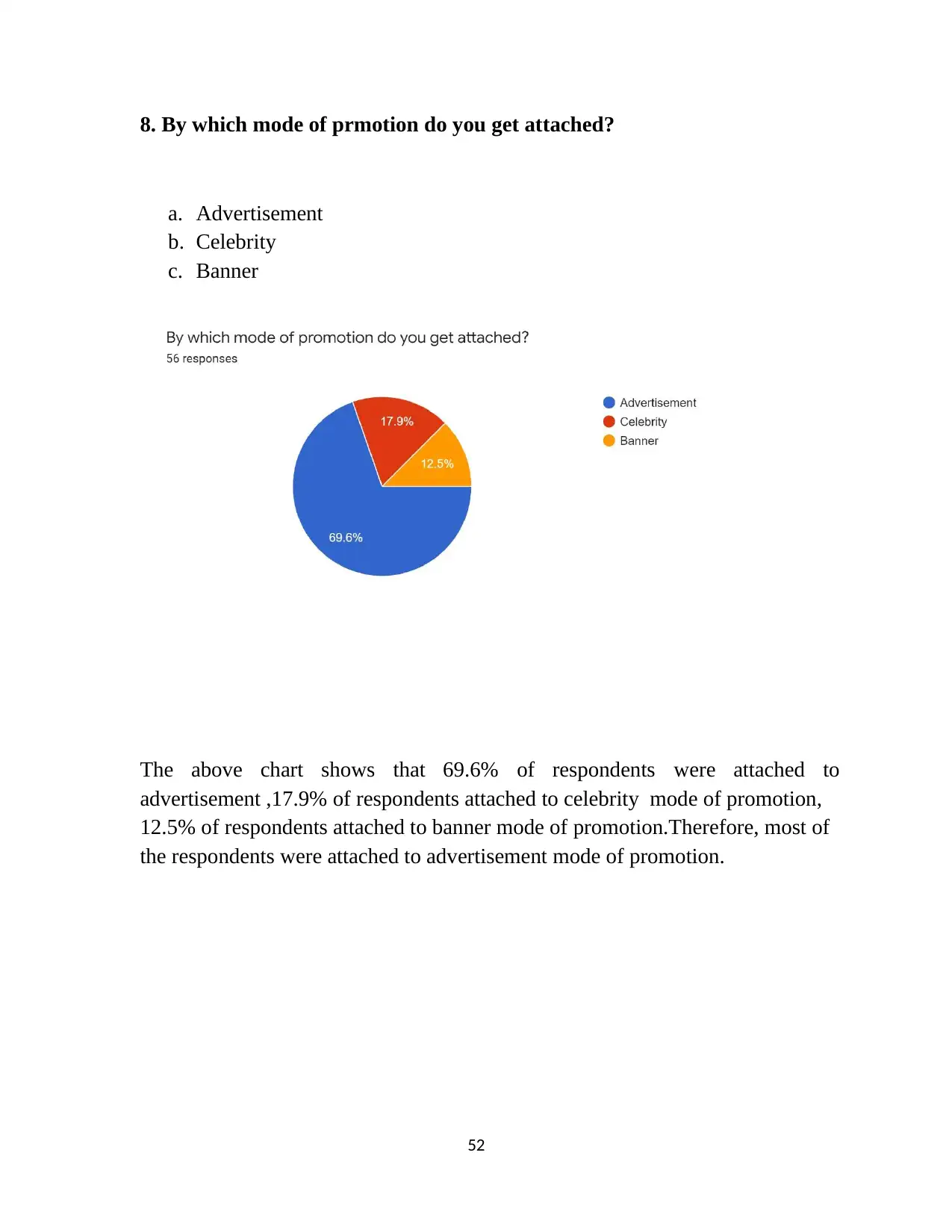
52
8. By which mode of prmotion do you get attached?
a. Advertisement
b. Celebrity
c. Banner
The above chart shows that 69.6% of respondents were attached to
advertisement ,17.9% of respondents attached to celebrity mode of promotion,
12.5% of respondents attached to banner mode of promotion.Therefore, most of
the respondents were attached to advertisement mode of promotion.
8. By which mode of prmotion do you get attached?
a. Advertisement
b. Celebrity
c. Banner
The above chart shows that 69.6% of respondents were attached to
advertisement ,17.9% of respondents attached to celebrity mode of promotion,
12.5% of respondents attached to banner mode of promotion.Therefore, most of
the respondents were attached to advertisement mode of promotion.
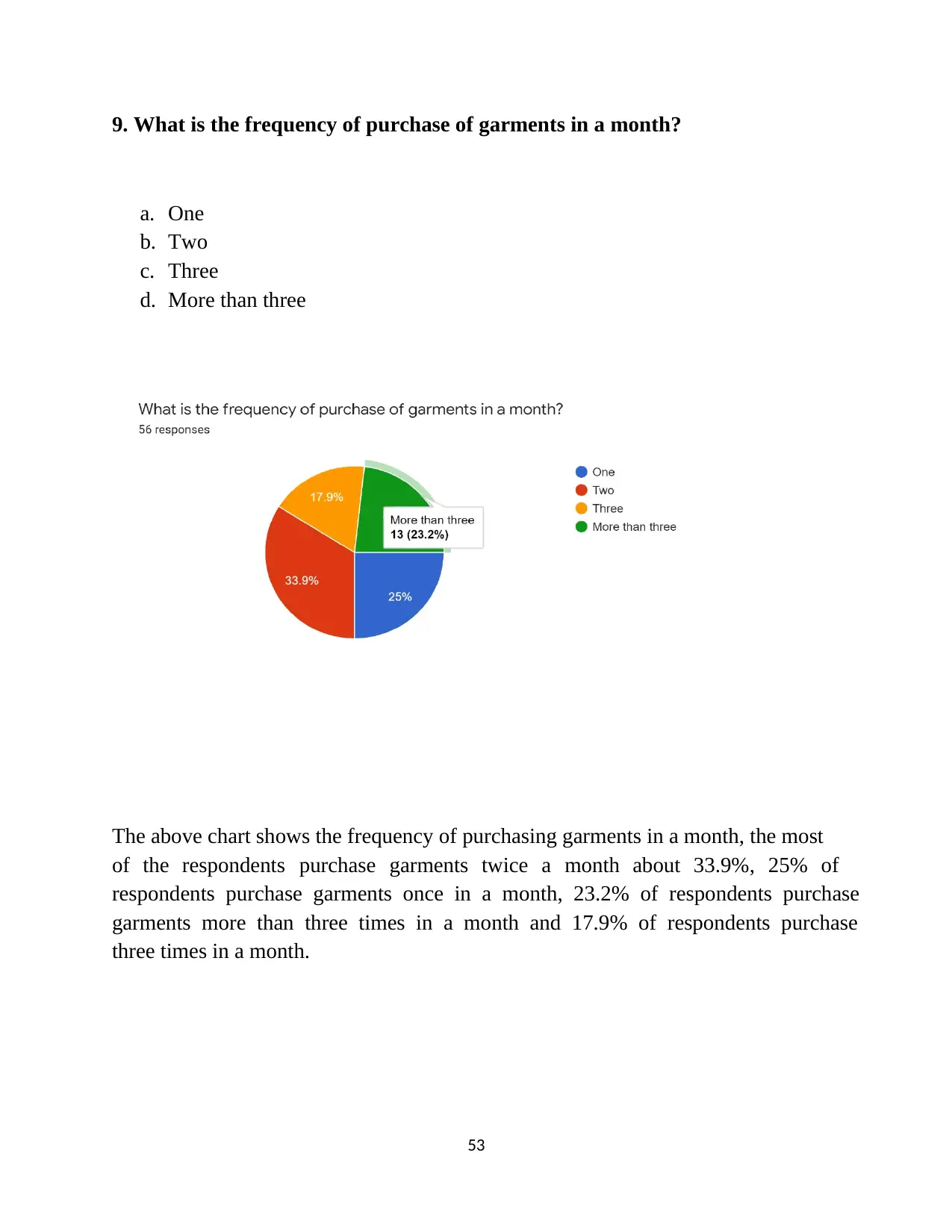
53
9. What is the frequency of purchase of garments in a month?
a. One
b. Two
c. Three
d. More than three
The above chart shows the frequency of purchasing garments in a month, the most
of the respondents purchase garments twice a month about 33.9%, 25% of
respondents purchase garments once in a month, 23.2% of respondents purchase
garments more than three times in a month and 17.9% of respondents purchase
three times in a month.
9. What is the frequency of purchase of garments in a month?
a. One
b. Two
c. Three
d. More than three
The above chart shows the frequency of purchasing garments in a month, the most
of the respondents purchase garments twice a month about 33.9%, 25% of
respondents purchase garments once in a month, 23.2% of respondents purchase
garments more than three times in a month and 17.9% of respondents purchase
three times in a month.
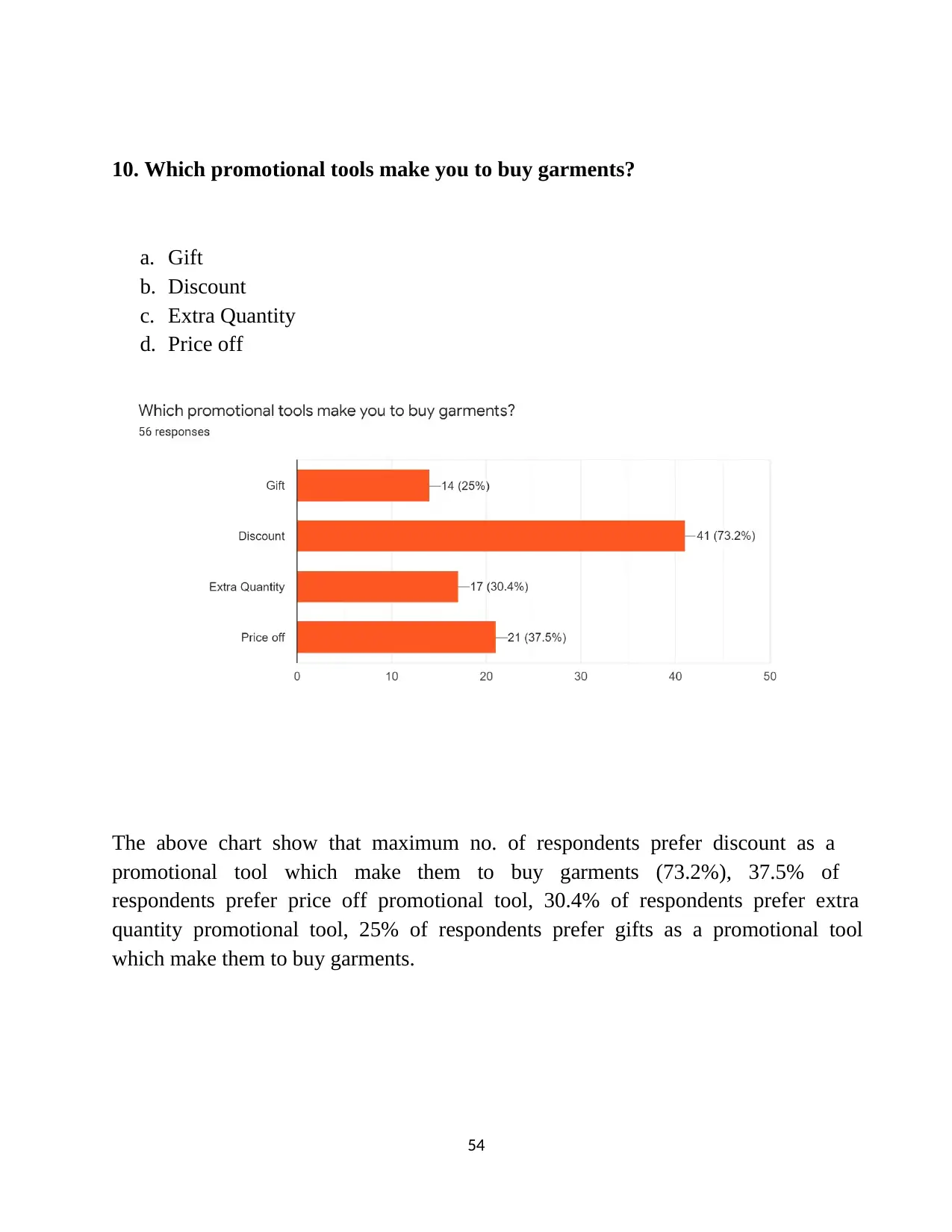
54
10. Which promotional tools make you to buy garments?
a. Gift
b. Discount
c. Extra Quantity
d. Price off
The above chart show that maximum no. of respondents prefer discount as a
promotional tool which make them to buy garments (73.2%), 37.5% of
respondents prefer price off promotional tool, 30.4% of respondents prefer extra
quantity promotional tool, 25% of respondents prefer gifts as a promotional tool
which make them to buy garments.
10. Which promotional tools make you to buy garments?
a. Gift
b. Discount
c. Extra Quantity
d. Price off
The above chart show that maximum no. of respondents prefer discount as a
promotional tool which make them to buy garments (73.2%), 37.5% of
respondents prefer price off promotional tool, 30.4% of respondents prefer extra
quantity promotional tool, 25% of respondents prefer gifts as a promotional tool
which make them to buy garments.
Paraphrase This Document
Need a fresh take? Get an instant paraphrase of this document with our AI Paraphraser
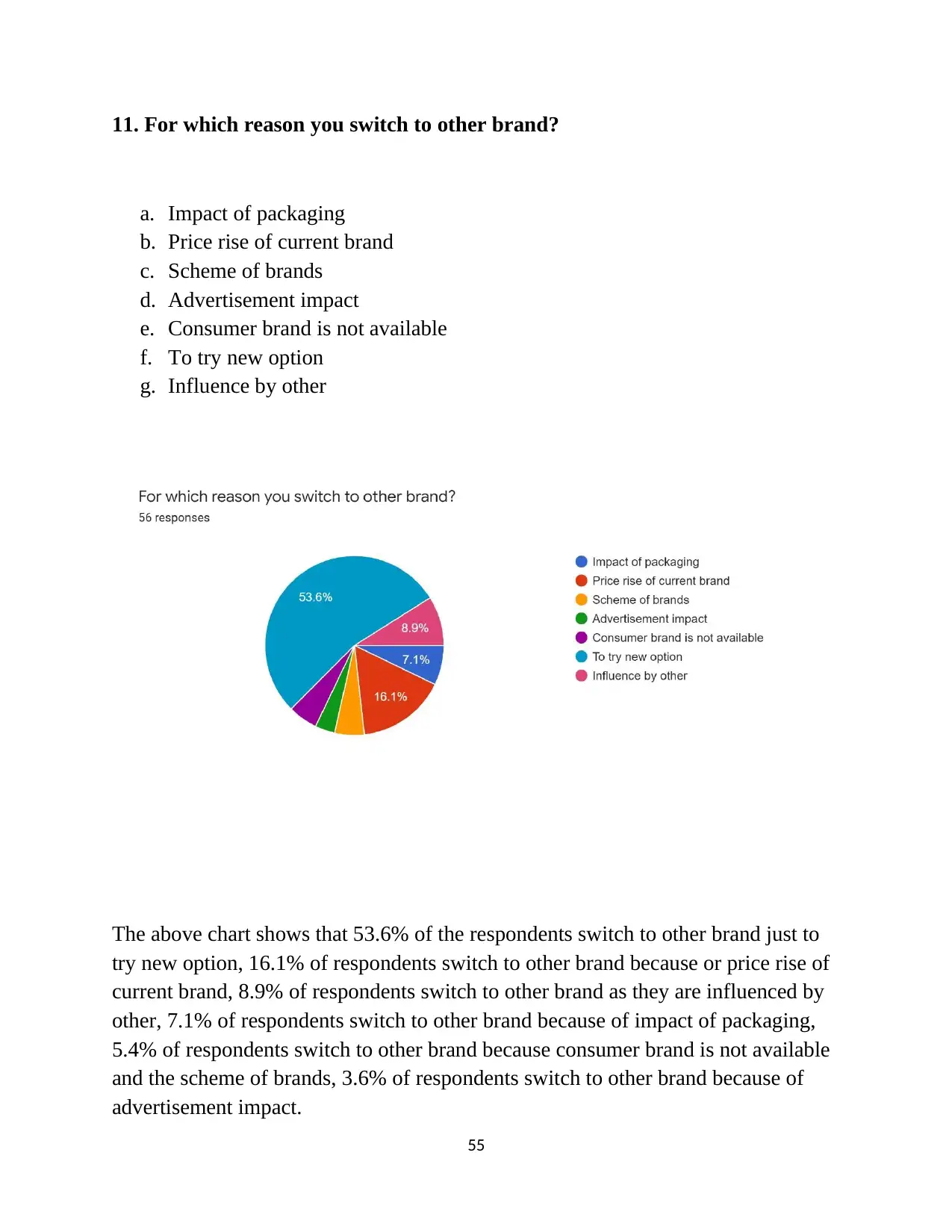
55
11. For which reason you switch to other brand?
a. Impact of packaging
b. Price rise of current brand
c. Scheme of brands
d. Advertisement impact
e. Consumer brand is not available
f. To try new option
g. Influence by other
The above chart shows that 53.6% of the respondents switch to other brand just to
try new option, 16.1% of respondents switch to other brand because or price rise of
current brand, 8.9% of respondents switch to other brand as they are influenced by
other, 7.1% of respondents switch to other brand because of impact of packaging,
5.4% of respondents switch to other brand because consumer brand is not available
and the scheme of brands, 3.6% of respondents switch to other brand because of
advertisement impact.
11. For which reason you switch to other brand?
a. Impact of packaging
b. Price rise of current brand
c. Scheme of brands
d. Advertisement impact
e. Consumer brand is not available
f. To try new option
g. Influence by other
The above chart shows that 53.6% of the respondents switch to other brand just to
try new option, 16.1% of respondents switch to other brand because or price rise of
current brand, 8.9% of respondents switch to other brand as they are influenced by
other, 7.1% of respondents switch to other brand because of impact of packaging,
5.4% of respondents switch to other brand because consumer brand is not available
and the scheme of brands, 3.6% of respondents switch to other brand because of
advertisement impact.
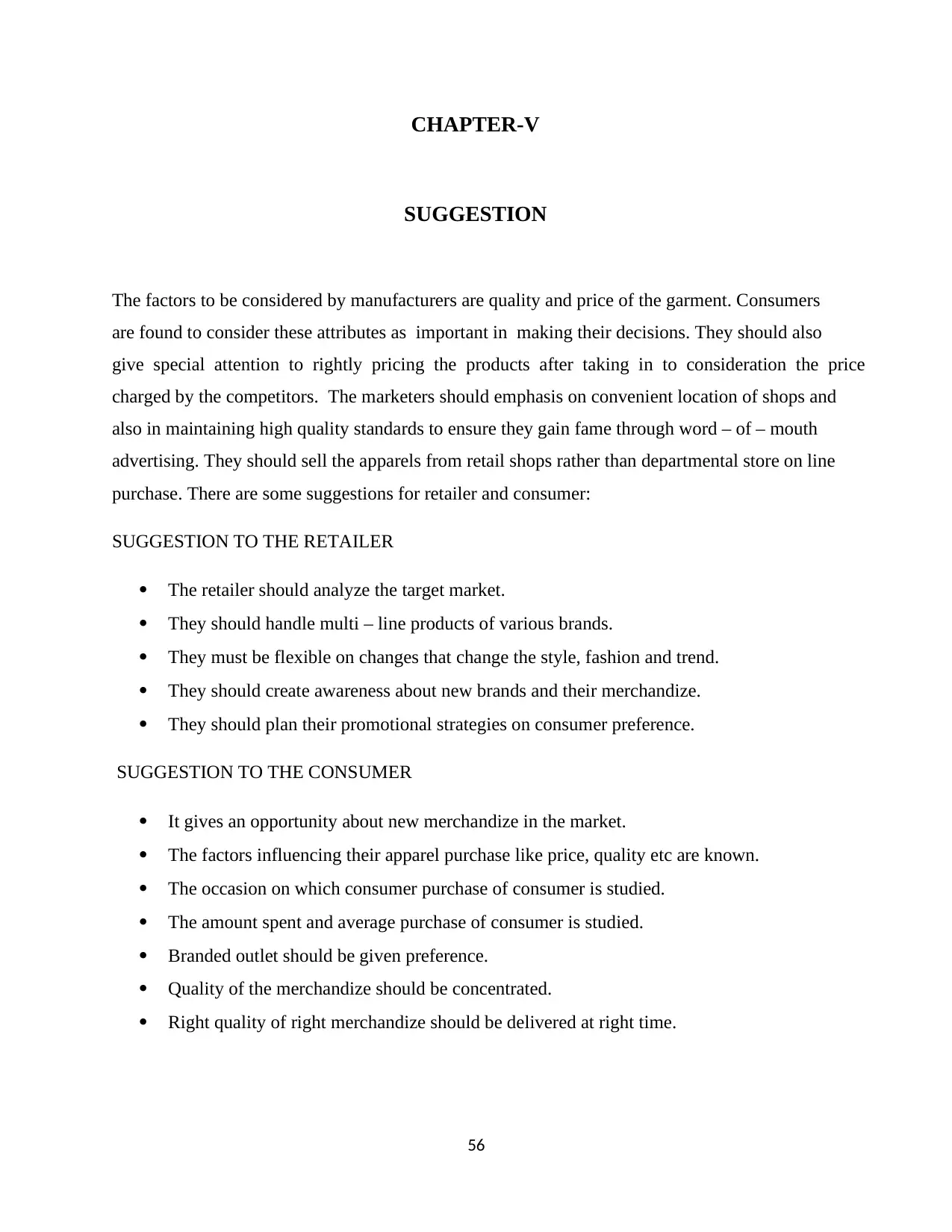
56
CHAPTER-V
SUGGESTION
The factors to be considered by manufacturers are quality and price of the garment. Consumers
are found to consider these attributes as important in making their decisions. They should also
give special attention to rightly pricing the products after taking in to consideration the price
charged by the competitors. The marketers should emphasis on convenient location of shops and
also in maintaining high quality standards to ensure they gain fame through word – of – mouth
advertising. They should sell the apparels from retail shops rather than departmental store on line
purchase. There are some suggestions for retailer and consumer:
SUGGESTION TO THE RETAILER
The retailer should analyze the target market.
They should handle multi – line products of various brands.
They must be flexible on changes that change the style, fashion and trend.
They should create awareness about new brands and their merchandize.
They should plan their promotional strategies on consumer preference.
SUGGESTION TO THE CONSUMER
It gives an opportunity about new merchandize in the market.
The factors influencing their apparel purchase like price, quality etc are known.
The occasion on which consumer purchase of consumer is studied.
The amount spent and average purchase of consumer is studied.
Branded outlet should be given preference.
Quality of the merchandize should be concentrated.
Right quality of right merchandize should be delivered at right time.
CHAPTER-V
SUGGESTION
The factors to be considered by manufacturers are quality and price of the garment. Consumers
are found to consider these attributes as important in making their decisions. They should also
give special attention to rightly pricing the products after taking in to consideration the price
charged by the competitors. The marketers should emphasis on convenient location of shops and
also in maintaining high quality standards to ensure they gain fame through word – of – mouth
advertising. They should sell the apparels from retail shops rather than departmental store on line
purchase. There are some suggestions for retailer and consumer:
SUGGESTION TO THE RETAILER
The retailer should analyze the target market.
They should handle multi – line products of various brands.
They must be flexible on changes that change the style, fashion and trend.
They should create awareness about new brands and their merchandize.
They should plan their promotional strategies on consumer preference.
SUGGESTION TO THE CONSUMER
It gives an opportunity about new merchandize in the market.
The factors influencing their apparel purchase like price, quality etc are known.
The occasion on which consumer purchase of consumer is studied.
The amount spent and average purchase of consumer is studied.
Branded outlet should be given preference.
Quality of the merchandize should be concentrated.
Right quality of right merchandize should be delivered at right time.
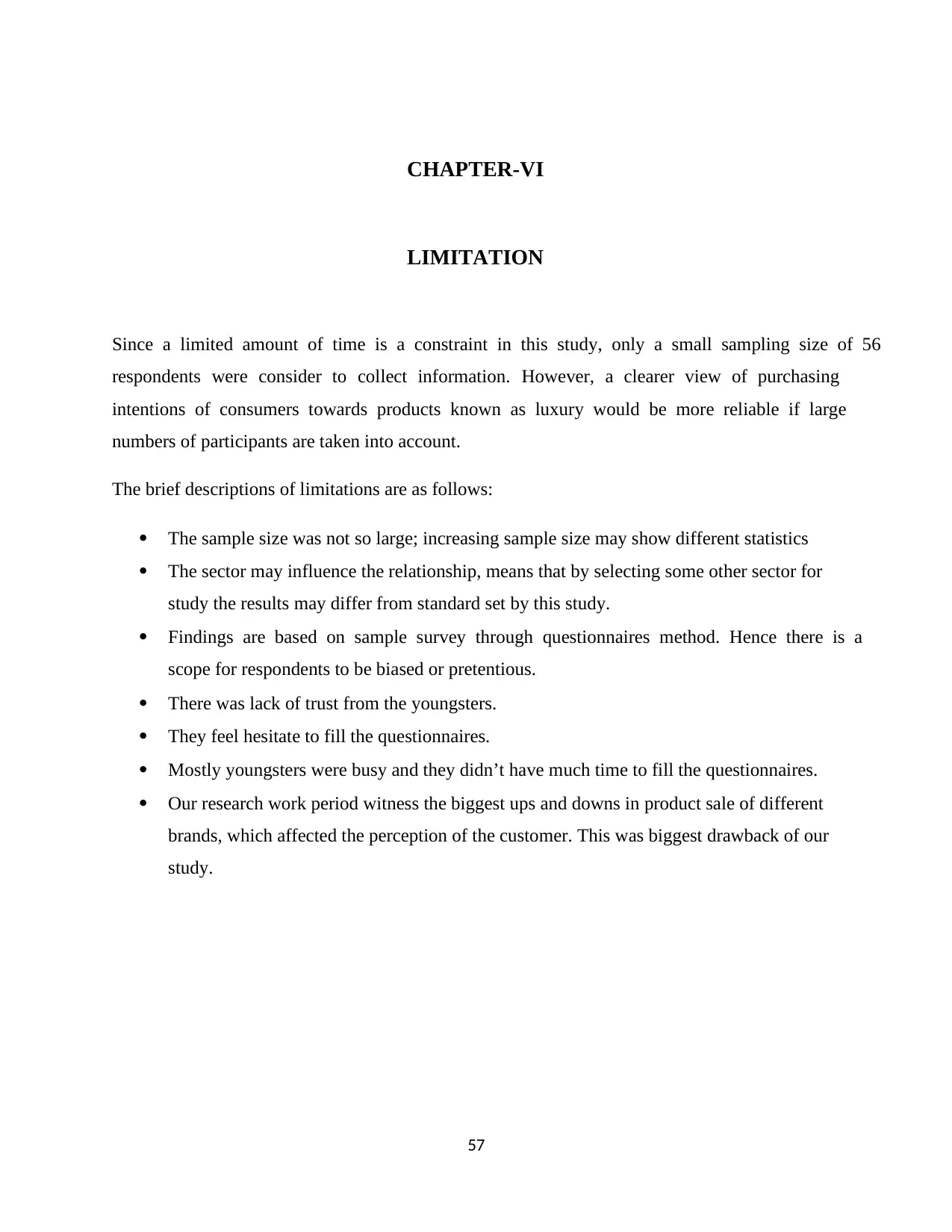
57
CHAPTER-VI
LIMITATION
Since a limited amount of time is a constraint in this study, only a small sampling size of 56
respondents were consider to collect information. However, a clearer view of purchasing
intentions of consumers towards products known as luxury would be more reliable if large
numbers of participants are taken into account.
The brief descriptions of limitations are as follows:
The sample size was not so large; increasing sample size may show different statistics
The sector may influence the relationship, means that by selecting some other sector for
study the results may differ from standard set by this study.
Findings are based on sample survey through questionnaires method. Hence there is a
scope for respondents to be biased or pretentious.
There was lack of trust from the youngsters.
They feel hesitate to fill the questionnaires.
Mostly youngsters were busy and they didn’t have much time to fill the questionnaires.
Our research work period witness the biggest ups and downs in product sale of different
brands, which affected the perception of the customer. This was biggest drawback of our
study.
CHAPTER-VI
LIMITATION
Since a limited amount of time is a constraint in this study, only a small sampling size of 56
respondents were consider to collect information. However, a clearer view of purchasing
intentions of consumers towards products known as luxury would be more reliable if large
numbers of participants are taken into account.
The brief descriptions of limitations are as follows:
The sample size was not so large; increasing sample size may show different statistics
The sector may influence the relationship, means that by selecting some other sector for
study the results may differ from standard set by this study.
Findings are based on sample survey through questionnaires method. Hence there is a
scope for respondents to be biased or pretentious.
There was lack of trust from the youngsters.
They feel hesitate to fill the questionnaires.
Mostly youngsters were busy and they didn’t have much time to fill the questionnaires.
Our research work period witness the biggest ups and downs in product sale of different
brands, which affected the perception of the customer. This was biggest drawback of our
study.
Secure Best Marks with AI Grader
Need help grading? Try our AI Grader for instant feedback on your assignments.
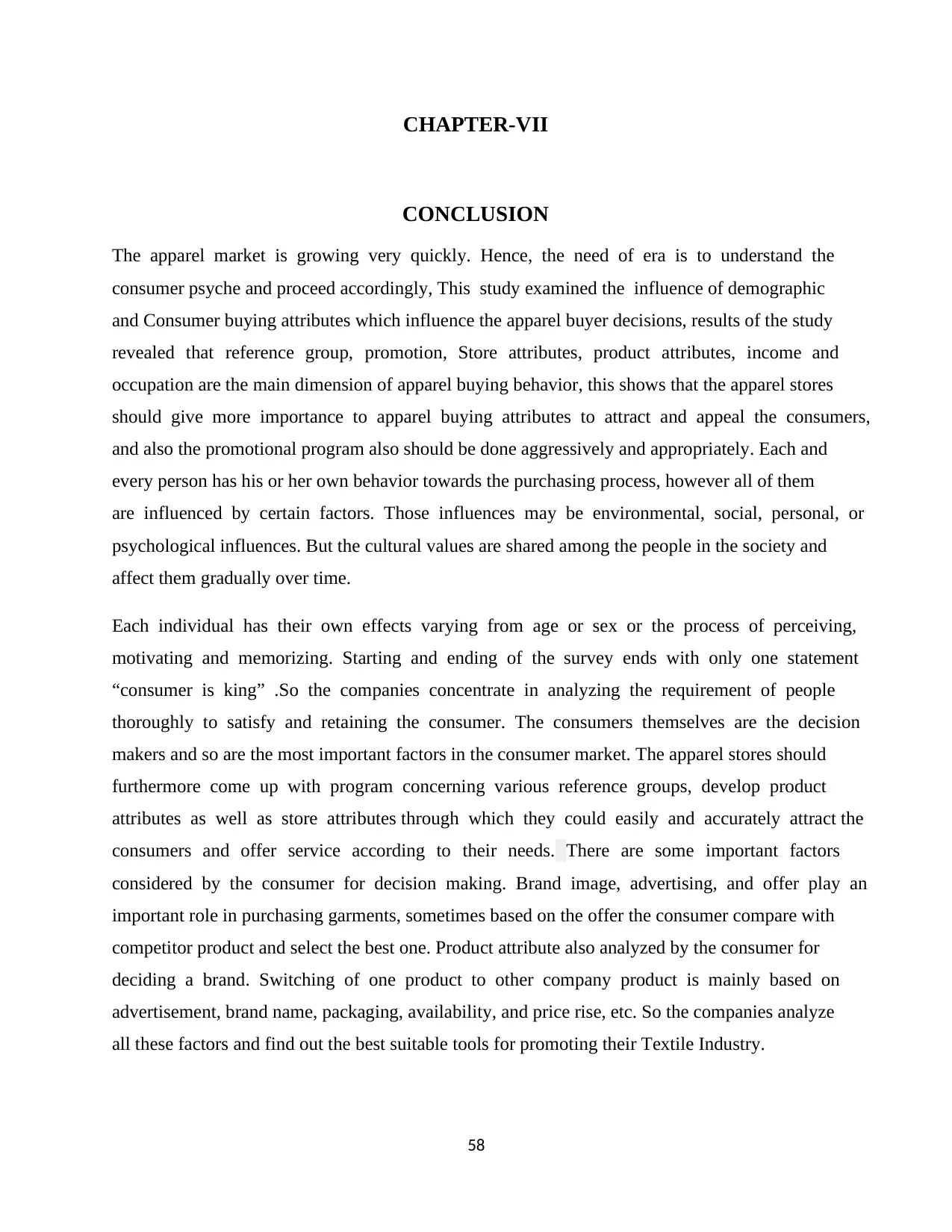
58
CHAPTER-VII
CONCLUSION
The apparel market is growing very quickly. Hence, the need of era is to understand the
consumer psyche and proceed accordingly, This study examined the influence of demographic
and Consumer buying attributes which influence the apparel buyer decisions, results of the study
revealed that reference group, promotion, Store attributes, product attributes, income and
occupation are the main dimension of apparel buying behavior, this shows that the apparel stores
should give more importance to apparel buying attributes to attract and appeal the consumers,
and also the promotional program also should be done aggressively and appropriately. Each and
every person has his or her own behavior towards the purchasing process, however all of them
are influenced by certain factors. Those influences may be environmental, social, personal, or
psychological influences. But the cultural values are shared among the people in the society and
affect them gradually over time.
Each individual has their own effects varying from age or sex or the process of perceiving,
motivating and memorizing. Starting and ending of the survey ends with only one statement
“consumer is king” .So the companies concentrate in analyzing the requirement of people
thoroughly to satisfy and retaining the consumer. The consumers themselves are the decision
makers and so are the most important factors in the consumer market. The apparel stores should
furthermore come up with program concerning various reference groups, develop product
attributes as well as store attributes through which they could easily and accurately attract the
consumers and offer service according to their needs. There are some important factors
considered by the consumer for decision making. Brand image, advertising, and offer play an
important role in purchasing garments, sometimes based on the offer the consumer compare with
competitor product and select the best one. Product attribute also analyzed by the consumer for
deciding a brand. Switching of one product to other company product is mainly based on
advertisement, brand name, packaging, availability, and price rise, etc. So the companies analyze
all these factors and find out the best suitable tools for promoting their Textile Industry.
CHAPTER-VII
CONCLUSION
The apparel market is growing very quickly. Hence, the need of era is to understand the
consumer psyche and proceed accordingly, This study examined the influence of demographic
and Consumer buying attributes which influence the apparel buyer decisions, results of the study
revealed that reference group, promotion, Store attributes, product attributes, income and
occupation are the main dimension of apparel buying behavior, this shows that the apparel stores
should give more importance to apparel buying attributes to attract and appeal the consumers,
and also the promotional program also should be done aggressively and appropriately. Each and
every person has his or her own behavior towards the purchasing process, however all of them
are influenced by certain factors. Those influences may be environmental, social, personal, or
psychological influences. But the cultural values are shared among the people in the society and
affect them gradually over time.
Each individual has their own effects varying from age or sex or the process of perceiving,
motivating and memorizing. Starting and ending of the survey ends with only one statement
“consumer is king” .So the companies concentrate in analyzing the requirement of people
thoroughly to satisfy and retaining the consumer. The consumers themselves are the decision
makers and so are the most important factors in the consumer market. The apparel stores should
furthermore come up with program concerning various reference groups, develop product
attributes as well as store attributes through which they could easily and accurately attract the
consumers and offer service according to their needs. There are some important factors
considered by the consumer for decision making. Brand image, advertising, and offer play an
important role in purchasing garments, sometimes based on the offer the consumer compare with
competitor product and select the best one. Product attribute also analyzed by the consumer for
deciding a brand. Switching of one product to other company product is mainly based on
advertisement, brand name, packaging, availability, and price rise, etc. So the companies analyze
all these factors and find out the best suitable tools for promoting their Textile Industry.
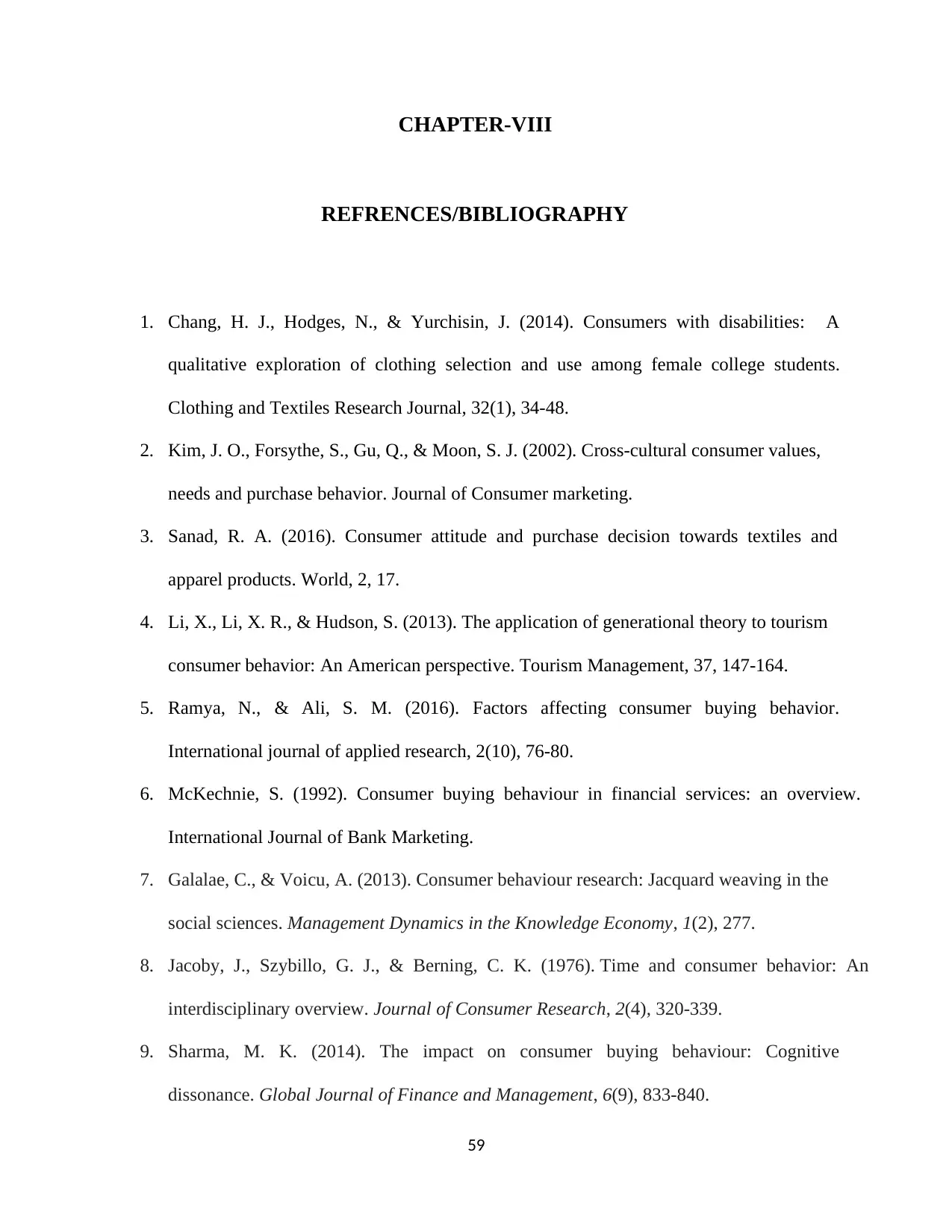
59
CHAPTER-VIII
REFRENCES/BIBLIOGRAPHY
1. Chang, H. J., Hodges, N., & Yurchisin, J. (2014). Consumers with disabilities: A
qualitative exploration of clothing selection and use among female college students.
Clothing and Textiles Research Journal, 32(1), 34-48.
2. Kim, J. O., Forsythe, S., Gu, Q., & Moon, S. J. (2002). Cross‐cultural consumer values,
needs and purchase behavior. Journal of Consumer marketing.
3. Sanad, R. A. (2016). Consumer attitude and purchase decision towards textiles and
apparel products. World, 2, 17.
4. Li, X., Li, X. R., & Hudson, S. (2013). The application of generational theory to tourism
consumer behavior: An American perspective. Tourism Management, 37, 147-164.
5. Ramya, N., & Ali, S. M. (2016). Factors affecting consumer buying behavior.
International journal of applied research, 2(10), 76-80.
6. McKechnie, S. (1992). Consumer buying behaviour in financial services: an overview.
International Journal of Bank Marketing.
7. Galalae, C., & Voicu, A. (2013). Consumer behaviour research: Jacquard weaving in the
social sciences. Management Dynamics in the Knowledge Economy, 1(2), 277.
8. Jacoby, J., Szybillo, G. J., & Berning, C. K. (1976). Time and consumer behavior: An
interdisciplinary overview. Journal of Consumer Research, 2(4), 320-339.
9. Sharma, M. K. (2014). The impact on consumer buying behaviour: Cognitive
dissonance. Global Journal of Finance and Management, 6(9), 833-840.
CHAPTER-VIII
REFRENCES/BIBLIOGRAPHY
1. Chang, H. J., Hodges, N., & Yurchisin, J. (2014). Consumers with disabilities: A
qualitative exploration of clothing selection and use among female college students.
Clothing and Textiles Research Journal, 32(1), 34-48.
2. Kim, J. O., Forsythe, S., Gu, Q., & Moon, S. J. (2002). Cross‐cultural consumer values,
needs and purchase behavior. Journal of Consumer marketing.
3. Sanad, R. A. (2016). Consumer attitude and purchase decision towards textiles and
apparel products. World, 2, 17.
4. Li, X., Li, X. R., & Hudson, S. (2013). The application of generational theory to tourism
consumer behavior: An American perspective. Tourism Management, 37, 147-164.
5. Ramya, N., & Ali, S. M. (2016). Factors affecting consumer buying behavior.
International journal of applied research, 2(10), 76-80.
6. McKechnie, S. (1992). Consumer buying behaviour in financial services: an overview.
International Journal of Bank Marketing.
7. Galalae, C., & Voicu, A. (2013). Consumer behaviour research: Jacquard weaving in the
social sciences. Management Dynamics in the Knowledge Economy, 1(2), 277.
8. Jacoby, J., Szybillo, G. J., & Berning, C. K. (1976). Time and consumer behavior: An
interdisciplinary overview. Journal of Consumer Research, 2(4), 320-339.
9. Sharma, M. K. (2014). The impact on consumer buying behaviour: Cognitive
dissonance. Global Journal of Finance and Management, 6(9), 833-840.
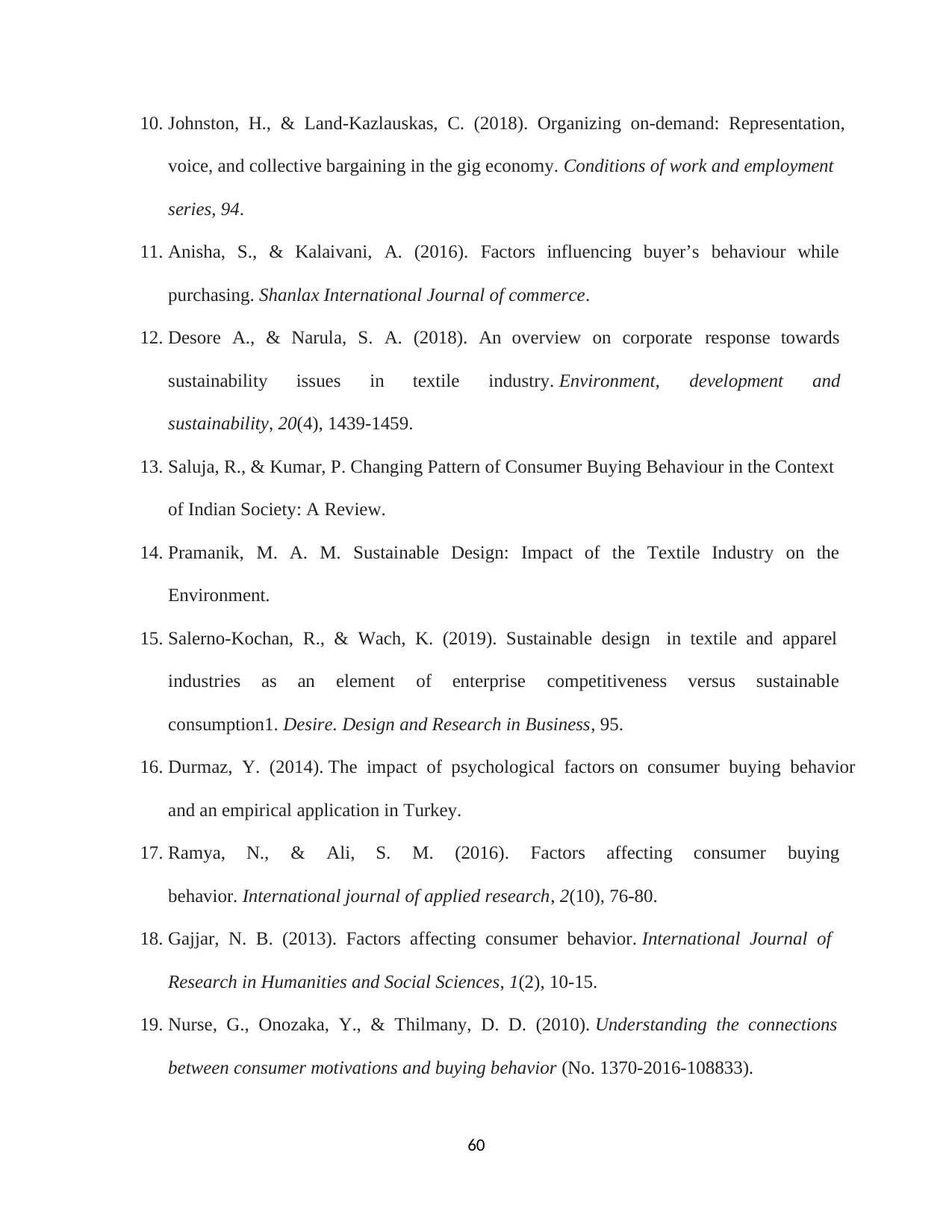
60
10. Johnston, H., & Land-Kazlauskas, C. (2018). Organizing on-demand: Representation,
voice, and collective bargaining in the gig economy. Conditions of work and employment
series, 94.
11. Anisha, S., & Kalaivani, A. (2016). Factors influencing buyer’s behaviour while
purchasing. Shanlax International Journal of commerce.
12. Desore A., & Narula, S. A. (2018). An overview on corporate response towards
sustainability issues in textile industry. Environment, development and
sustainability, 20(4), 1439-1459.
13. Saluja, R., & Kumar, P. Changing Pattern of Consumer Buying Behaviour in the Context
of Indian Society: A Review.
14. Pramanik, M. A. M. Sustainable Design: Impact of the Textile Industry on the
Environment.
15. Salerno-Kochan, R., & Wach, K. (2019). Sustainable design in textile and apparel
industries as an element of enterprise competitiveness versus sustainable
consumption1. Desire. Design and Research in Business, 95.
16. Durmaz, Y. (2014). The impact of psychological factors on consumer buying behavior
and an empirical application in Turkey.
17. Ramya, N., & Ali, S. M. (2016). Factors affecting consumer buying
behavior. International journal of applied research, 2(10), 76-80.
18. Gajjar, N. B. (2013). Factors affecting consumer behavior. International Journal of
Research in Humanities and Social Sciences, 1(2), 10-15.
19. Nurse, G., Onozaka, Y., & Thilmany, D. D. (2010). Understanding the connections
between consumer motivations and buying behavior (No. 1370-2016-108833).
10. Johnston, H., & Land-Kazlauskas, C. (2018). Organizing on-demand: Representation,
voice, and collective bargaining in the gig economy. Conditions of work and employment
series, 94.
11. Anisha, S., & Kalaivani, A. (2016). Factors influencing buyer’s behaviour while
purchasing. Shanlax International Journal of commerce.
12. Desore A., & Narula, S. A. (2018). An overview on corporate response towards
sustainability issues in textile industry. Environment, development and
sustainability, 20(4), 1439-1459.
13. Saluja, R., & Kumar, P. Changing Pattern of Consumer Buying Behaviour in the Context
of Indian Society: A Review.
14. Pramanik, M. A. M. Sustainable Design: Impact of the Textile Industry on the
Environment.
15. Salerno-Kochan, R., & Wach, K. (2019). Sustainable design in textile and apparel
industries as an element of enterprise competitiveness versus sustainable
consumption1. Desire. Design and Research in Business, 95.
16. Durmaz, Y. (2014). The impact of psychological factors on consumer buying behavior
and an empirical application in Turkey.
17. Ramya, N., & Ali, S. M. (2016). Factors affecting consumer buying
behavior. International journal of applied research, 2(10), 76-80.
18. Gajjar, N. B. (2013). Factors affecting consumer behavior. International Journal of
Research in Humanities and Social Sciences, 1(2), 10-15.
19. Nurse, G., Onozaka, Y., & Thilmany, D. D. (2010). Understanding the connections
between consumer motivations and buying behavior (No. 1370-2016-108833).
Paraphrase This Document
Need a fresh take? Get an instant paraphrase of this document with our AI Paraphraser
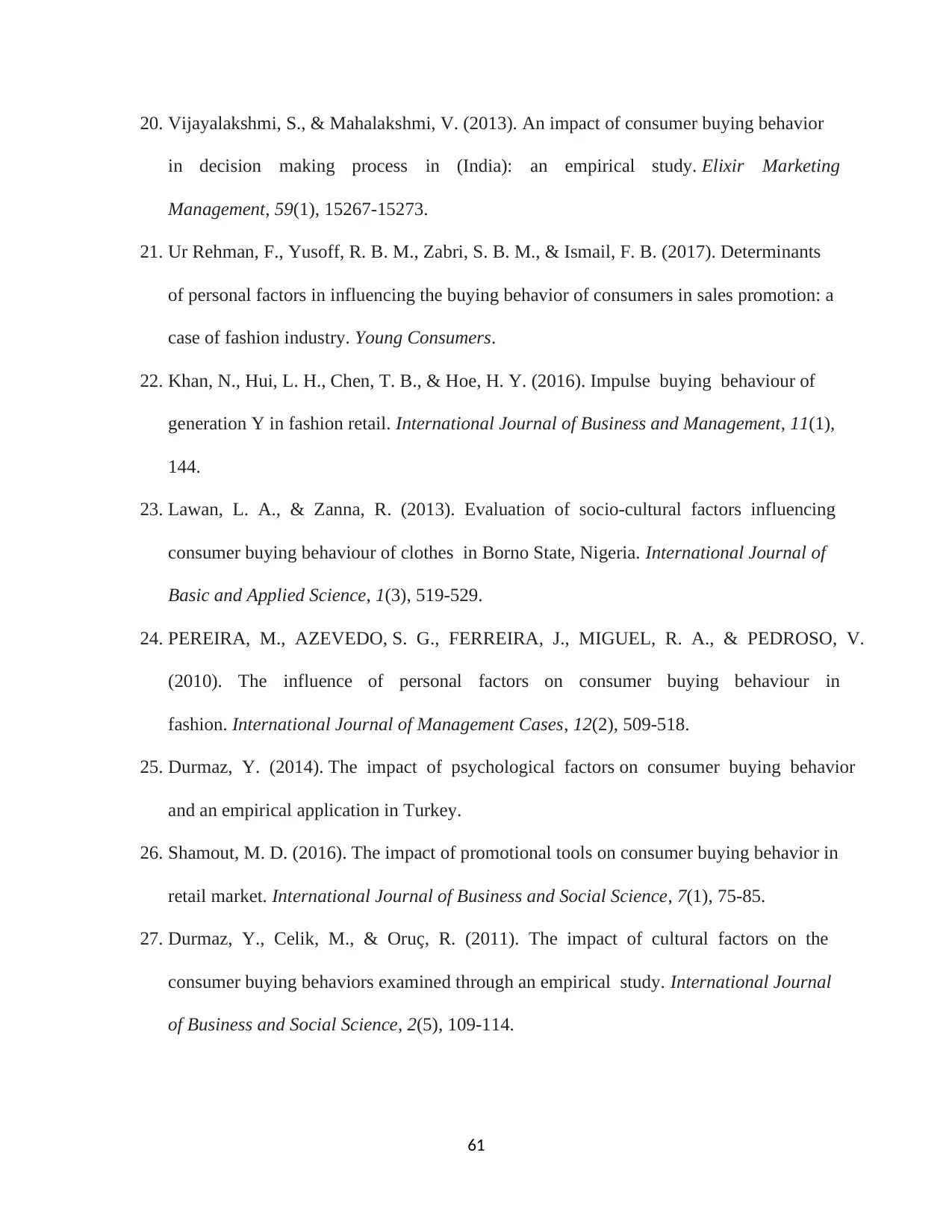
61
20. Vijayalakshmi, S., & Mahalakshmi, V. (2013). An impact of consumer buying behavior
in decision making process in (India): an empirical study. Elixir Marketing
Management, 59(1), 15267-15273.
21. Ur Rehman, F., Yusoff, R. B. M., Zabri, S. B. M., & Ismail, F. B. (2017). Determinants
of personal factors in influencing the buying behavior of consumers in sales promotion: a
case of fashion industry. Young Consumers.
22. Khan, N., Hui, L. H., Chen, T. B., & Hoe, H. Y. (2016). Impulse buying behaviour of
generation Y in fashion retail. International Journal of Business and Management, 11(1),
144.
23. Lawan, L. A., & Zanna, R. (2013). Evaluation of socio-cultural factors influencing
consumer buying behaviour of clothes in Borno State, Nigeria. International Journal of
Basic and Applied Science, 1(3), 519-529.
24. PEREIRA, M., AZEVEDO, S. G., FERREIRA, J., MIGUEL, R. A., & PEDROSO, V.
(2010). The influence of personal factors on consumer buying behaviour in
fashion. International Journal of Management Cases, 12(2), 509-518.
25. Durmaz, Y. (2014). The impact of psychological factors on consumer buying behavior
and an empirical application in Turkey.
26. Shamout, M. D. (2016). The impact of promotional tools on consumer buying behavior in
retail market. International Journal of Business and Social Science, 7(1), 75-85.
27. Durmaz, Y., Celik, M., & Oruç, R. (2011). The impact of cultural factors on the
consumer buying behaviors examined through an empirical study. International Journal
of Business and Social Science, 2(5), 109-114.
20. Vijayalakshmi, S., & Mahalakshmi, V. (2013). An impact of consumer buying behavior
in decision making process in (India): an empirical study. Elixir Marketing
Management, 59(1), 15267-15273.
21. Ur Rehman, F., Yusoff, R. B. M., Zabri, S. B. M., & Ismail, F. B. (2017). Determinants
of personal factors in influencing the buying behavior of consumers in sales promotion: a
case of fashion industry. Young Consumers.
22. Khan, N., Hui, L. H., Chen, T. B., & Hoe, H. Y. (2016). Impulse buying behaviour of
generation Y in fashion retail. International Journal of Business and Management, 11(1),
144.
23. Lawan, L. A., & Zanna, R. (2013). Evaluation of socio-cultural factors influencing
consumer buying behaviour of clothes in Borno State, Nigeria. International Journal of
Basic and Applied Science, 1(3), 519-529.
24. PEREIRA, M., AZEVEDO, S. G., FERREIRA, J., MIGUEL, R. A., & PEDROSO, V.
(2010). The influence of personal factors on consumer buying behaviour in
fashion. International Journal of Management Cases, 12(2), 509-518.
25. Durmaz, Y. (2014). The impact of psychological factors on consumer buying behavior
and an empirical application in Turkey.
26. Shamout, M. D. (2016). The impact of promotional tools on consumer buying behavior in
retail market. International Journal of Business and Social Science, 7(1), 75-85.
27. Durmaz, Y., Celik, M., & Oruç, R. (2011). The impact of cultural factors on the
consumer buying behaviors examined through an empirical study. International Journal
of Business and Social Science, 2(5), 109-114.
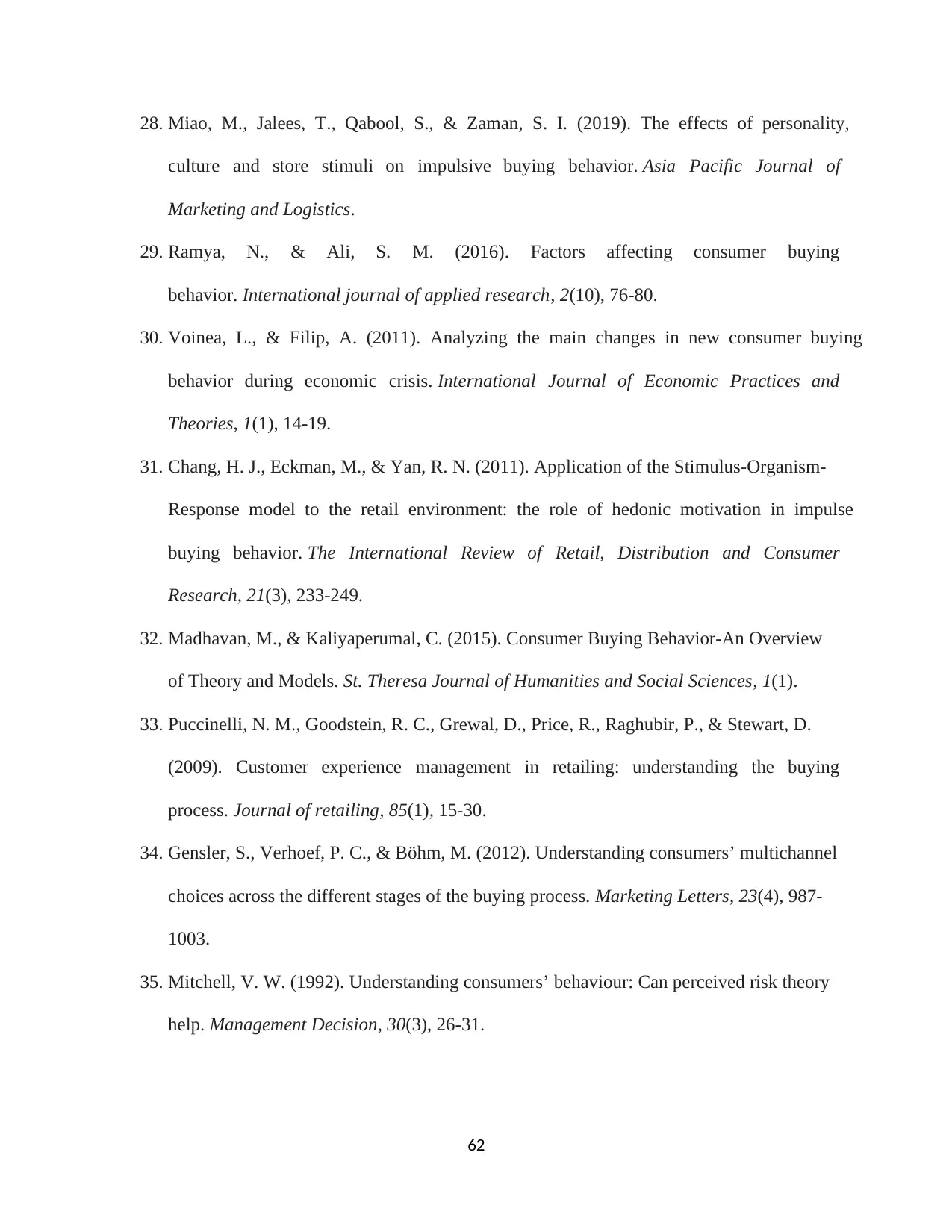
62
28. Miao, M., Jalees, T., Qabool, S., & Zaman, S. I. (2019). The effects of personality,
culture and store stimuli on impulsive buying behavior. Asia Pacific Journal of
Marketing and Logistics.
29. Ramya, N., & Ali, S. M. (2016). Factors affecting consumer buying
behavior. International journal of applied research, 2(10), 76-80.
30. Voinea, L., & Filip, A. (2011). Analyzing the main changes in new consumer buying
behavior during economic crisis. International Journal of Economic Practices and
Theories, 1(1), 14-19.
31. Chang, H. J., Eckman, M., & Yan, R. N. (2011). Application of the Stimulus-Organism-
Response model to the retail environment: the role of hedonic motivation in impulse
buying behavior. The International Review of Retail, Distribution and Consumer
Research, 21(3), 233-249.
32. Madhavan, M., & Kaliyaperumal, C. (2015). Consumer Buying Behavior-An Overview
of Theory and Models. St. Theresa Journal of Humanities and Social Sciences, 1(1).
33. Puccinelli, N. M., Goodstein, R. C., Grewal, D., Price, R., Raghubir, P., & Stewart, D.
(2009). Customer experience management in retailing: understanding the buying
process. Journal of retailing, 85(1), 15-30.
34. Gensler, S., Verhoef, P. C., & Böhm, M. (2012). Understanding consumers’ multichannel
choices across the different stages of the buying process. Marketing Letters, 23(4), 987-
1003.
35. Mitchell, V. W. (1992). Understanding consumers’ behaviour: Can perceived risk theory
help. Management Decision, 30(3), 26-31.
28. Miao, M., Jalees, T., Qabool, S., & Zaman, S. I. (2019). The effects of personality,
culture and store stimuli on impulsive buying behavior. Asia Pacific Journal of
Marketing and Logistics.
29. Ramya, N., & Ali, S. M. (2016). Factors affecting consumer buying
behavior. International journal of applied research, 2(10), 76-80.
30. Voinea, L., & Filip, A. (2011). Analyzing the main changes in new consumer buying
behavior during economic crisis. International Journal of Economic Practices and
Theories, 1(1), 14-19.
31. Chang, H. J., Eckman, M., & Yan, R. N. (2011). Application of the Stimulus-Organism-
Response model to the retail environment: the role of hedonic motivation in impulse
buying behavior. The International Review of Retail, Distribution and Consumer
Research, 21(3), 233-249.
32. Madhavan, M., & Kaliyaperumal, C. (2015). Consumer Buying Behavior-An Overview
of Theory and Models. St. Theresa Journal of Humanities and Social Sciences, 1(1).
33. Puccinelli, N. M., Goodstein, R. C., Grewal, D., Price, R., Raghubir, P., & Stewart, D.
(2009). Customer experience management in retailing: understanding the buying
process. Journal of retailing, 85(1), 15-30.
34. Gensler, S., Verhoef, P. C., & Böhm, M. (2012). Understanding consumers’ multichannel
choices across the different stages of the buying process. Marketing Letters, 23(4), 987-
1003.
35. Mitchell, V. W. (1992). Understanding consumers’ behaviour: Can perceived risk theory
help. Management Decision, 30(3), 26-31.

63
CHAPTER-IX
ANNEXURE
CHAPTER-IX
ANNEXURE
1 out of 70
Your All-in-One AI-Powered Toolkit for Academic Success.
+13062052269
info@desklib.com
Available 24*7 on WhatsApp / Email
![[object Object]](/_next/static/media/star-bottom.7253800d.svg)
Unlock your academic potential
© 2024 | Zucol Services PVT LTD | All rights reserved.




